

National
Briefing | Midwest
 Wolves
to Return to Endangered List Wolves
to Return to Endangered List
June
29, 2009
More than 4,000 gray wolves in the western Great Lakes region
are going back on the federal endangered species list, at least
temporarily.
The Fish and Wildlife Service said it had erred by ending federal
protection for wolves in Michigan, Minnesota and Wisconsin without
having a public comment period. Under a settlement with five activist
groups, the agency said it would return Great Lakes wolves to
the list while considering its next move. The wolves had been
classified as endangered from 1974 until their removal on May
4. About 1,300 wolves in Montana and Idaho that also were dropped
from the list in May are not part of the deal because a public
comment period was held in their case. |

AP
Poll: Half of pet owners give pets human names
By MEGAN K. SCOTT
June
23, 2009

|
Rodin,
Rodin, me |
NEW
YORK (AP) -- So much for Rover and Fido. Almost half of American
pet owners gave an animal human-like name, such as Jack or
Sophie, according to an Associated Press-Petside.com poll
of more than 1,000 pet owners released Tuesday.
Some of the more unusual names: Hollywood and Chichi Mittens,
both cats; Vegas the Labrador Retriever; Jibber Jack the dog;
the Beagle named Talulublue, and Louis XIV, the Yorkie.
In all, 49 percent of respondents, including 51 percent of
dog owners and 50 percent of cat owners, had given at least
one of their pets a human-like name.
The
most popular? Max got more mentions than other names in the
AP Poll, but not enough to give it any broad claim of popularity
(less than 2 percent of all mentions). One database of pet
names, maintained by Veterinary Pet Insurance, also finds
that Max pops up more frequently than any other name.
There has been a move away from classic dog names such as
Spot and Lassie, according to VPI spokesman Curtis Steinhoff.
There were 13 Fidos in VPI's database in 2008, placing the
name at No. 2,866. Rover was No. 2,534, behind names like
Grendel, Ginger Snap and Munchie. Steinhoff said the trend
reflects a stronger bond between people and their pets.
Pet owners who give their pets human names are more likely
to see them as full members of the family, said Wayne Eldridge,
veterinarian and author of "The Best Pet Name Book Ever!"
But he cautions against reading too much into pet names. Many
people choose names based on the animal's appearance, he said.
One of the most unusual names in the VPI database was Snag
L. Tooth for a cat with a "snaggle tooth" that protrudes.
And some people don't know why they chose a certain name for
their pet. Like Beth Hart, 63, of Houston, who started naming
her dogs Sassoon for the hair salon Vidal Sassoon. Her current
Shih Tzu is Sassoon the Third. Her husband named their Lhaso
Apso, "Dawg," their second dog with that name.
Daniel Rivera, 23, of Lansing, Mich. said his 4-year-old daughter
named their pit bull lab mix Little Fella. He said he guesses
the name fits since the dog has very short legs.
For some it's all about being creative. Susan Jacobs, 45,
of Long Beach, Calif., named her black poodle Kingston for
her best vacation ever. "It was beautiful, the people,
the music, the warm weather," she said of her trip to
Jamaica a decade ago. "Now whenever I say his name, I
think of that time of in my life."
|

Pet hotels pick up clients, even as travel industry sags during
recession
Paradise 4 Paws expands, even as human travel
sags
By Ann Meyer | SPECIAL TO THE TRIBUNE
June
22, 2009
With the travel industry plummeting last year, entrepreneur
Saq Nadeem couldn't have picked a worse time to open a luxury
pet hotel.
Nadeem's 25,000-square-foot Paradise 4 Paws resort, complete
with splashing pool, indoor grassy play 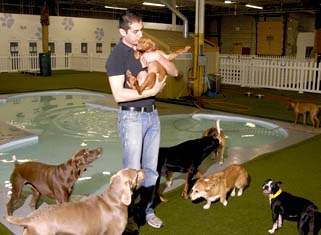 area,
flat-screen TVs, Webcam access and private rooms with attached
patios opened near O'Hare International Airport in May 2008,
just as the travel industry was descending rapidly due to
the economy. area,
flat-screen TVs, Webcam access and private rooms with attached
patios opened near O'Hare International Airport in May 2008,
just as the travel industry was descending rapidly due to
the economy.
A year later, the firm has taken off and Nadeem has plans
to open a second location near Midway Airport by the end of
the year. He hopes to have facilities open in 10 markets within
the next five years if he can find funding.
Nadeem sunk every penny of his savings into the business and
raised funds from individual investors, including several
professors at his alma mater, Northwestern University's Kellogg
School of Management.
The company's success is a credit to Nadeem's skillful execution,
investors said.
"It's a unique idea, but it's also the implementation
with loving care," that has made Paradise 4 Paws successful,
said Kellogg dean emeritus Donald Jacobs, who has invested
in the business.
While a master's student at Kellogg, Nadeem, who has a dog
and two cats, came up with the concept of a luxury pet hotel
located near the airport and open 24 hours a day to accommodate
business travelers.
He took a consulting job after graduation, but his travel
schedule made him realize the strength of his business plan.
If he had a 7 a.m. flight Monday, he would have to drop off
his dog at the kennel on Saturday, because it wasn't open
Sunday or early enough Monday. If he got back late Thursday,
he couldn't get his dog out until Friday, only to have to
return it Saturday for the next week.
By building a pet resort near the airport and allowing 24-hour
drop-off and pickup, Nadeem figured he could save pet owners
time, money and guilt.
At $47 a night, dogs get a private room, plenty of playtime
and round-the-clock care. The facility also is open for doggy
day care any time of day or night, for $25 to $32 per day.
With many customers watching their budget, Nadeem has created
promotions, such as discounts for longer reservations, additional
pets or frequent users. Still, few people balk at the price,
he said.
Bob Vetere, president of the American Pet Products Association,
isn't surprised. He knows of one Virginia pet hotel charging
$75 a night. "If you're in the right spot where it can
be supported, a lot of pet hotels are springing up and doing
well," he said. "Pet owners are making decisions
for their pets based on human feelings and emotions."
People treat their pets like children. That's one reason the
pet industry is proving to be resilient during the recession,
Vetere said.
Pet spending in 2008 hit $43.2 billion, up from $41.2 billion
the prior year. And the trade association is projecting a
5 percent increase in spending this year to $45.4 billion.
Pet services, including boarding and day care, is projected
to climb 6 percent to $3.4 billion this year, adding credence
to the premise that pet owners are more likely to cut back
on spending for themselves before their pets, Vetere said.
Retail giant PetSmart Inc., based in Phoenix, also has noticed
the trend. It now has 152 PetsHotel locations, which offer
suites with TVs and personal care, said spokeswoman Jessica
Douglas. The company opened 45 PetsHotels last year and plans
to open 14 this year, including two in Illinois, she said.
"We see the services in our PetsHotels continuing to
be strong during peak travel times and holiday weekends,"
she said.
Even with growing competition, Paradise 4 Paws seems well-positioned
due to its emphasis on convenience, investors said. Located
near O'Hare, it offers extended parking and will get pet owners
to and from the airport at any hour after they drop off their
pets.
"The idea of putting it adjacent to where people need
to go when they travel is unique," said Julie Hennessy,
clinical professor of marketing at Kellogg, who has invested
in the business.
What's more, few boarding facilities offer the space that
Paradise 4 Paws does, said veterinarian Rae Ann Van Pelt,
co-owner of Family Pet Animal Hospital in Chicago, who boards
her own dogs there when she travels so they get more exercise.
The artificial-turf play area, which was built with a drainage
system to allow for regular cleaning, sold Van Pelt on the
place. She also appreciates that the animals are kept in rooms,
not cages.
"It's less stressful for them," she said.
Standard suites for dogs are 4 feet by 7 feet with an additional
4-by-4 patio, but larger drywalled rooms are popular with
families boarding several dogs together, Nadeem said.
Photo:
Saq Nadeem, founder of Paradise 4 Paws, an upscale resort
for dogs and cats in Schiller Park. (Photo for the Tribune
by Yvette Marie Dostatni / June 22, 2009)
|

Little Dane puts prince in doghouse
Matthew Campbell
June
21, 2009
SPARE a thought for Prince Henrik, the dog-loving husband
of the Queen of Denmark. His 75th  birthday
celebration earlier this month was overshadowed by a public
furore over Evita, his beloved dachshund, after she bit a
royal guardsman on the leg. birthday
celebration earlier this month was overshadowed by a public
furore over Evita, his beloved dachshund, after she bit a
royal guardsman on the leg.
Calls by MPs for the dog to be put down appear to have stirred
Henrik’s unhappiness over a lack of respect for him
as the foreign-born husband of the queen.
Opinion polls show his wife, Queen Margrethe, 69, to be one
of the most popular heads of the Danish monarchy. Nobody would
have the nerve to suggest putting any of her pets to sleep.
For Henrik, a Frenchman, life is more complicated, particularly
since the coming of age of Prince Frederik, his son and the
heir to the throne. Henrik has lamented his own relegation
to “third rank” after years of being “number
two”.
Denmark’s recent referendum vote in favour of granting
male and female heirs equality was seized on by the prince
to press his own case for more equality with Margrethe, a
cousin of Queen Elizabeth.
“I hope men will enjoy the same equality as women -
there is a man married to the queen,” he said when asked
about the referendum, in which an overwhelming majority voted
in favour of changing the law.
Concerns about the status of Henrik have prompted extraordinary
scenes at the family’s rococo palace of Amalienborg
in Copenhagen.
In 2002, when Margrethe cracked a rib and Prince Frederik
took her place at a function, Henrik retreated in a huff to
Château de Caïx, the vineyard near Cahors in France
that is, beside his dogs, his pride and joy.
The 11-year-old Evita had attacked the guard at the royal
family’s castle in Fredensborg.
“If my dog had been so aggressive I’d have had
it put down,” said Bjarne Laustsen, an opposition MP.
Another MP suggested Evita be muzzled. It is not known what
Henrik thinks of that idea, but the queen can only hope he
will not withdraw to his vineyard.
|

BO WOW FOR PIC OF LITTER
HOT DOG!
By CHARLES HURT
June
20, 2009
WASHINGTON -- First dog Bo got the presidential treatment
yesterday with the unveiling of his very 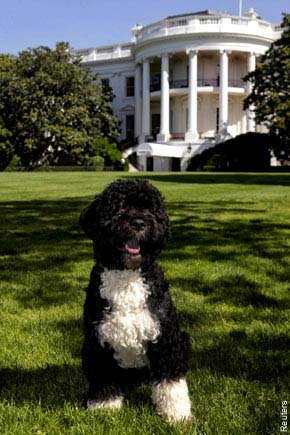 own
official White House portrait. own
official White House portrait.
The shaggy-haired Portuguese water dog -- whose approval ratings
have remained sky-high since he moved into 1600 Pennsylvania
Ave. in April -- is shown preening on the South Lawn in the
fetching pic.
It appears to be the first time an official first-pet portrait
has been taken by the White House. In addition to the new
pic, dog lovers can also get their Bo fix with new details
about life in the biggest doghouse in the land.
According to a baseball-style card released by the White House,
Bo's hobbies include playing on the lawn and going on walks
with his owners, and he loves running.
His
goal as First Dog is to make friends with "foreign DOGnataries"
and his favorite food is tomatoes.
ASPCA
Assiistant Director Joe Pentangelo sais that Dogs nibbling
on tomatoes is fine but pet owners must make sure that their
canines donm't eat the tomato's stem or leavesbecause they
are harmful to the animals.
Perhaps
most surprisingly, Bo reveals that even though he's a Portuguese
Water Dog, a canine bred to work alongside fishermen, he doesn't
know how to swim. Bo shouldn't let his landlubber ways get
him down though, said Stu Freeman, president of the Water
Dog Club of America. "You have to introduce them to it.
You can't say, hey, there's water. Go jump in it," he
said. We do it with our puppies. Some swim naturally. Some
go down like a rock."
|

SICKOS
SHOOT JACK RUSSELL TO MAKE BELT
'I SAW MY PUPPY'S SKIN HANGING THERE'
By TODD VENEZIA
June
20, 2009
A 23-year-old woman has been accused of being a real-life
Cruella de Vil -- for allegedly killing a helpless puppy so
she could skin it and make a belt for herself.
Krystal Lynn Lewis of Muskogee, Okla., allegedly launched
her evil plot earlier this week when she
|
|
Krystal
Llynn Lewis |
Michael
Mullins |
had
a male friend pump a clip full of bullets into little Joplin,
a Jack Russell terrier with white fur and a black spot that
she got as a gift from her lesbian ex-lover, cops said. She
allegedly skinned the animal and started tanning its hide
-- but was caught before she could complete her cruel couture.
When confronted about the gruesome crime by the woman who
gave her the dog, Lewis allegedly admitted that she was as
heartless as the infamous villain from Disney's "101
Dalmatians."
"When have you known me to have a heart?" she told
her stunned former gal pal Jessica Nichols, according to the
Muskogee Phoenix newspaper.
Nichols said Joplin was born on April 3, and she gave the
pup to Lewis because she had to move and could no longer take
care of him. She said she later asked for the dog back, but
Lewis wouldn't return him.
Sometime this week, Lewis allegedly had friend Austin Michael
Mullins, 26, shoot little Joplin 10 times with a .22-caliber
pistol, authorities said. Lewis then told Nichols what she
had done. But the ex-lover told the paper that she refused
to believe the woman could really be that cruel -- until she
actually saw a photo of the carcass in the paper.
"I still wasn't sure she had done it until I opened the
paper and saw my puppy's skin hanging there," said Nichols.
Authorities found the dog's white and black hide pinned to
a board and left to dry inside Lewis' apartment. The horrifying
sight disgusted the officers who found the dog.
"We're talking about a 6- or 7-week-old defenseless puppy,"
said sheriff's deputy George Roberson. "That's pretty
heinous and sadistic."
Both Lewis and Mullins allegedly admitted to killing the puppy
and skinning it.
The were both slapped with felony animal-cruelty charges and
held on $25,000 bail. A judge ordered a mental competency
hearing for both of them.
The
pair of accused puppy skinners now face up to five years in
jail and a $500 fine.
"Why did she have to do what she did?" Nichols told
the paper. "I just can't believe she didn't give the
puppy back to me," Nichols said.
|

A
Furry Mercy: Momofuku Donates Bones
By Frank Bruni
June
19, 2009
Eat a bowl of ramen—and make a dog smile.
That’s an odd notion, yes, but it would be an apt slogan
for Momofuku Noodle Bar , should the  restaurant
want to use it. (My gift! Enjoy! Or maybe not . . .) It captures
the gist of a new and unusual (at least to my knowledge and
quick reporting) but abundantly clever effort by Momofuku
to help homeless dogs. restaurant
want to use it. (My gift! Enjoy! Or maybe not . . .) It captures
the gist of a new and unusual (at least to my knowledge and
quick reporting) but abundantly clever effort by Momofuku
to help homeless dogs.
The restaurant is taking the leftover pork bones from its
daily production of gallon upon gallon of ramen broth and
giving them to New York City animal shelters.
Momofuku workers started doing this about a month ago and
are slowly expanding their effort, though  there’s
been some red tape to cut through, according to the Momofuku
staffer most centrally involved in the project, Christina
Tosi (right). She said some animal shelters
resisted overtures, while others had to pause to research
whether any city codes or ordinances discouraged such donations. there’s
been some red tape to cut through, according to the Momofuku
staffer most centrally involved in the project, Christina
Tosi (right). She said some animal shelters
resisted overtures, while others had to pause to research
whether any city codes or ordinances discouraged such donations.
Ms. Tosi is the pastry chef for many Momofukus — Ko
,Ssam Bar ,Milk Bar — but that’s not the credential
most relevant here. She’s also a dog lover, as she explained
during a recent telephone conversation. Although she lives
in a one-bedroom Brooklyn apartment with only a small yard
out back, Ms. Tosi, 27, has three dogs totaling nearly 200
pounds: Bernadette, a 110-pound, 8-year-old Rottweiler/German
shepherd mix; Thurgood, a 65-pound, two-and-a-half year old
mix of hound dog and pit bull; and Beans, a 20-pound recent
arrival from Puerto Rico whose exact age and pedigree she
doesn’t know. “He looks like a mix of a bat and
a dog,” she said.
About two months ago, Ms. Tosi explained, an animal rights
advocate dropped a flier off at Momofuku Ko, saying that if
the restaurant didn’t stop serving foie gras, protests
could be in the offing. She said that while the flier didn’t
prompt a menu change, it did prompt a little soul searching.
“We started brainstorming as a group: how do we show
people that we really are as thoughtful as possible?”
she said. She said that the restaurant workers wondered in
particular if they could do something related to animal welfare.
With input from — and the help of — several key
outsiders, they started thinking about kitchen leftovers,
the kind that hadn’t gone out on any plate and made
contact with customers, the kind the restaurant could know
were clean and safe and such.
And she said that everyone realized: “We have bones.
We love dogs.” It’s such an obvious idea, it just
takes a little legwork,” Ms. Tosi added.
Over the past month, Momofuku bones began to go to the Brooklyn
Animal Rescue Coalition and the Williamsburg Animal Clinic
, she said. Momofuku bones are just now starting to go as
well to the Animal Haven in SoHo.
Tiffany Lacey, the executive director of the Animal Haven,
told me on the phone late Thursday afternoon that in her five
years at the rescue center, she’d never been approached
by a restaurant or heard about restaurants giving bones to
shelters. “It was something totally new,” she
said, going on to marvel over how many bones the Momofuku
restaurants in aggregate have to give—and how many other
donate-able bones must be out there.
A worker at the Brooklyn Animal Rescue Coalition told me that
Momofuku’s effort, while rare, isn’t unprecedented.
He said that at various points in the past, the Brooklyn shelter
had received bones from Peter Luger, the legendary steakhouse.
Ms. Tosi said that the bones that Momofuku restaurants are
rounding up and sending out are, in addition to pork bones
from Noodle Bar, beef bones that come off the short ribs cooked
at Momofuku Ko and lamb bones from Ssam Bar.
She
said that the restaurants are giving away “only bones
that are left from cooking,” not bones that come back
from tables in the restaurant and have been out of the restaurant
staff’s eyesight and control.
Photo
(above right): The pastry chef Christina Tosi has led the
effort to bring Momofuku’s leftover bones to animal
shelters.
Marilynn K. Yee/The New York Times
|

Pele: A dog who loves a good read
July
19, 2009
Seven-year-old Kevin Clarkson wasn’t ready to leave
the Kanab City Library just yet, no matter how 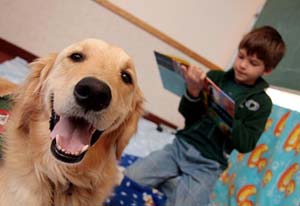 much
his friend tried to persuade him. much
his friend tried to persuade him.
He was having too good a time. He’d spent the past hour
learning dog safety tips, coloring and reading a book about
guinea pigs to Pele, a golden retriever and certified service
dog. “He’s a good listener,” Clarkson said.
After reading to Pele, Clarkson chose a small stuffed zebra
from a bin of stuffed animals, named him Zak, and signed an
adoption certificate promising to read to him every day.
Clarkson was one of almost 40 children who showed up at the
library June 17 to take part in “I Read to Animals,”
a program of Best Friends Animal Society’s Humane Education
department. One by one, Clarkson and the other children took
turns reading to Pele from a book they’d chosen from
a large bin. Pele, comfortably lying on a blanket with a stuffed
toy duck in his mouth, seemed to hang on their every word.
Pele didn’t critique them, didn’t correct them
when they stumbled on a word—he just enjoyed being read
to.
Reading to dogs
The “I Read to Animals” program drew quite a crowd.
“This is an incredible turnout,” said Dr. Sandy
Passmore, manager of Best Friends Humane Education department.
“Some adults came without children just to see this.”
Kanab library director, Dicki Robinson, agreed. “The
turnout was good,” Robinson said. “It’s
a good program.”
The program opened with Passmore and the Humane Education
department’s Jennifer Andrews giving the children dog
safety tips with the help of a stuffed sheepdog named Hal.
The children learned that they should always ask before petting
a dog and that they should never pull a dog’s ears or
try to take his toy away. Then, they introduced Pele.
“Pele is a very special dog and he’s our guest
today,” Passmore said.
While waiting their turns to read to Pele, the children made
their own storybooks complete with stories and illustrations.
Seven-year-old Emmorie Decker made a colorful drawing of a
duck. Macie Stewart, also 7, drew turtles in her book before
reading “Me and My Dog” to Pele.
Nine-year-old McLean Ray read “Mr. Putter and Tabby
Stir the Soup” to Pele before “adopting”
his stuffed animal, a dog he named “Black.”
Pele, the assistance dog
Pele is the assistance dog of Kelly McMahon of Las Vegas,
Nevada, a longtime fan of Best Friends. Pele helps the wheelchair-bound
McMahon with the chores of everyday life. He turns on light
switches, opens and closes doors and even fetches the remote
control. “They work from the heart,” McMahon said.
Humane Education
Pele is McMahon’s second service dog. Her first, a golden
retriever named Frisco, crossed over the Rainbow Bridge. Both
dogs came from a Georgia-based organization called Canine
Assistants. “They don’t charge the recipient for
training, not even for airfare,” McMahon said. And the
dogs stay with their people after retiring. It was McMahon’s
first trip to Best Friends.
“I was like a little kid going to Disneyland,”
McMahon said.
Joining Pele and McMahon at the library was Best Friends education
ambassador Jill Matsuda, also of Las Vegas. “I think
it’s a wonderful opportunity for kids to get experience
in reading,” Matsuda said. “I can’t think
of a better way to encourage kids to read.”
Kim Dalton, a second-grade teacher from northern California
who’s spending her summer working at Best Friends, agreed.
“It empowers them to read and feel comfortable about
reading out loud,” Dalton said.
Best Friends is launching the “I Read to Animals”
program in a number of target cities, including Las Vegas,
Salt Lake City, Los Angeles and Chicago. The next stop is
in July in Henderson, Nevada, where children will read to
some rescued baby tortoises. The Pound Puppies company generously
donated stuffed animals for the program and the KISH Foundation
provided a $1,000 grant to help buy the life-sized stuffed
golden retrievers which Best Friends will donate to libraries
and schools. Canine Assistants donated a T-shirt and collar
with a tag for the stuffed golden retriever at the Kanab library.
Read more about
educational
opportunities at Best Friends.
Read more about
Canine
Assistants.
|

9/11 Search Dog Cloned for Former Canadian
Police Officer
17
June 2009
LOS ANGELES (AP) -- Scientists in California say
they have cloned a dog that helped with search-and-rescue
after the New York terrorist attacks on Sept. 11, 2001.

Five
German shepherd puppies cloned from a dog named Trakr have
been delivered to owner James Symington, a former police officer
in Halifax, Nova Scotia, who now lives in Los Angeles.
Before Trakr died in April at age 16, Symington entered a
contest sponsored by the California company BioArts International
that offered to clone a pet dog for free.
Symington took Trakr to New York after the World Trade Center
collapsed and said Trakr helped find one woman who was still
alive.
Symington was briefly in hot water for working at the Trade
Center while he was supposed to be on medical leave.
|

Cats outsmarted
in psychologist's test
Strings experiment shows limits of feline intelligence
James Meikle
June
17 2009
It will cause outrage among some cat owners, but research
suggests the pets are not as clever as some humans think they
are or at least think in a way we have yet to fathom.
Psychology lecturer Britta Osthaus says cats do not understand
cause-and-effect connections between objects. She tested the
thought processes of 15 of them by attaching fish and biscuit
treats to one end of a piece of string, placing them under
a plastic screen to make them unreachable and then seeing
if the cats could work out that pulling on the other end of
the string would pull the treat closer.
They were tested in three ways, using a single baited string,
two parallel strings where only one was baited, and two crossed
strings where only one was baited.
The single string test proved no problem, but
unlike Dogs (which Osthaus has previously tested)
no cat consistently chose correctly between two parallel strings.
With two crossed strings, one cat always made the wrong choice
and others succeeded no more than might be expected by chance.
Osthaus, of Canterbury Christ Church University, Kent, said:
"This finding is somehow surprising as cats regularly
use their paws and claws to pull things towards them during
play and hunting. They performed even
worse than Dogs, which can at least solve the parallel string
task."
The study helped show the limits of feline intelligence, said
Osthaus, who conducted the research while a teaching fellow
at Exeter University. "If we know their limits we won't
expect too much of them, which in turn is important for their
welfare. I am not trying to say cats are stupid, just they
are different. We are so anthropomorphic we can't see the
world through their eyes."
There is just one consolation:
Humans
don't understand string theory either.

|
KansasCity.com
 St. Louis
airport opens rest areas for traveling pets
St. Louis
airport opens rest areas for traveling pets
June
16, 2009
ST. LOUIS | Lambert-St. Louis International Airport has opened
two outdoor rest areas where traveling animals can spend a few
minutes off the leash and play.
Lambert officials say the miniature dog parks have 400 square
feet of gated space with benches, fire hydrants, and plastic
mitts for pet owners to clean up after their animals.
Lambert spokesman Jeff Lea said Tuesday that several airports
have created areas for pets and service animals to exercise,
play and relieve themselves between flights.
The area at the Main Terminal has synthetic turf and is located
outside exit MT-6. The East Terminal location has natural grass
and is outside baggage claim at exit ET-15. |
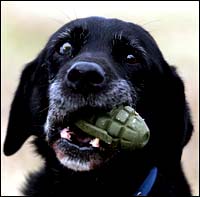  Wire
Services Wire
Services
Weird but True
June
16, 2009
Thanks
but no thanks, Fido.
A
Dog playing fetch in the German town of Erkrath brought its
owner a live Ameriocan grenade left over from World War II.
A
munitions expert defused the Dog's present. |

Wild dogs take Chewbilee Line
STRAY dogs are commuting to and from a city centre
on underground trains in search of food scraps.
By VIRGINIA WHEELER
15
June 2009
MOSCOW -- The clever canines board the Tube each morning.
After a hard day scavenging and begging on the streets, they
hop back on the train and return to the
 Canine
commuter - wild dog waits on the platform Canine
commuter - wild dog waits on the platform
|
suburbs
where they spend the night. Experts studying the dogs say they
even work together to make sure they get off at the right stop
- after learning to judge the length of time they need to spend
on the train.
The mutts choose the quietest carriages at the front and back
of the train. They have also developed tactics to hustle humans
into giving them more food on the streets of Moscow.
Scientists believe the phenomenon began after the Soviet Union
collapsed in the 1990s, and Russia's new capitalists moved industrial
complexes from the city centre to the suburbs.
Dr Andrei Poiarkov, of the Moscow Ecology and Evolution Institute,
said: "These complexes were used by homeless dogs as shelters,
so the dogs had to move together with their houses. Because
the best scavenging for food is in the city centre, the dogs
had to learn how to travel on the subway - to get to the centre
in the morning, then back home in the evening, just like people."
Dr Poiarkov told how the dogs like to play during their daily
commute. He said: "They jump on the train seconds before
the doors shut, risking their tails getting jammed. They do
it for fun. And sometimes they fall asleep and get off at the
wrong stop."
The dogs have learned to use traffic lights to cross the road
safely, said Dr Poiarkov. And they use cunning tactics to obtain
tasty morsels of shawarma, a kebab-like snack popular in Moscow.
They sneak up behind people eating shawarmas - then bark loudly
to shock them into dropping their food.
With children the dogs "play cute" by putting their
heads on youngsters' knees and staring pleadingly into their
eyes to win sympathy - and scraps.
Dr Poiarkov added: "Dogs are surprisingly good psychologists."
The Moscow mutts are not the first animals to use public transport.
In 2006 a Jack Russell in Dunnington, North Yorks, began taking
the bus to his local pub in search of sausages. And two years
ago passengers in Wolverhampton were stunned when a cat called
Macavity started catching the 331 bus to a fish and chip shop. |
 Dog can
seize the day in family emergency
Dog can
seize the day in family emergency
BY CELESTE BUSK
June
11, 2009
Dogs always have been known as man's best friend, but when it
comes to seizure-response dogs for those with epilepsy, these
special canines become invaluable protectors.
The Walker family in north suburban Grayslake -- mom Candace
and children Colin, 11, Carson, 9, and
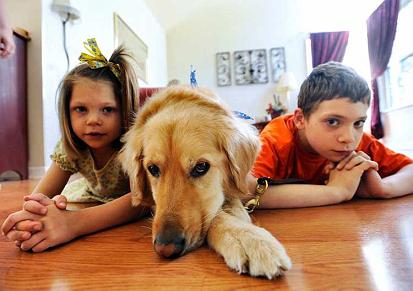 Donut,
a 4 year-old golden retriever "seizure dog"
hangs out with Cailean Walker, 5, and Colin Walker,
11, at the family home in north suburban Grayslake.
Donut,
a 4 year-old golden retriever "seizure dog"
hangs out with Cailean Walker, 5, and Colin Walker,
11, at the family home in north suburban Grayslake.
|
Cailean,
5 -- know this all too well. They own a golden retriever seizure-response
dog, Donut. The 4-year-old Donut helps Colin, who has Dravet
syndrome a progressive childhood disorder characterized by epilepsy.
Before the family acquired Donut in 2007, Candace said she had
her hands full caring for Colin. In addition to the possibility
of hurting himself during a seizure or not getting his medicine
quickly enough, Colin can become disoriented and wander away
from his family, especially at stores.
"Colin had been 'Code Adam' [store term for a missing child]
more times than I can count," Candace said. "Now Donut
is tethered to him when we go out, so he doesn't wander away
any more. Plus, Donut has a harness that carries his seizure
medicine, which also is important."
Candace says Donut also is able to alert her in advance of Colin
having a seizure. "He's trained to alert us by barking.
I think he can pick up the scent of the seizure in advance.
Typically he 'woofs' right before one, but one time he warned
us 45 minutes in advance. Donut also lies down next to Colin
during a seizure," Candace said.
Donut also has picked up on Colin's sister Cailean, who also
has Dravet syndrome. "He watches her, too, and often alerts
us," she said.
Although Candace believes Donut can predict a seizure, experts
from the Epilepsy Foundation of Greater Chicago are cautious
in agreeing.
"Right now, it's only a theory that these dogs can smell
a seizure in advance," said Epilepsy Foundation spokesman
Garett Auriemma. "We call these dogs 'seizure-response
dogs' and caution people when it comes to the concept of an
alert dog. What we think is these dogs form a strong bond with
the owner and learn to recognize signs or things people do before
they have a seizure. So the dog may say, 'Oh, that usually leads
to the thing I need to do, like bark,'" Auriemma said.
"It's very rare for a dog to predict a seizure without
knowing you first."
America's interest in seizure dogs began in the mid-1980s, when
a woman with epilepsy who was taking part in a Washington state
prison project involving dogs discovered that one of the dogs
seemed to know when she was going to have a seizure. The news
media picked up the story, and the phrase "seizure dogs"
was born, according to the national Epilepsy Foundation's Web
site, www.epil epsychicago.org.
Now the term is used to include a variety of activities associated
with epilepsy. Some dogs have been trained to bark or otherwise
alert families when a child has a seizure while playing outside
or in another room, the national foundation said. Some dogs
learn to lie next to someone having a seizure to prevent injury.
Others are able to activate alarm systems.
"The most important thing about these dogs is that they
have definitely saved lives and for many people these dogs are
there literally as a lifeline to take part in life's experiences,"
Auriemma said. "They're incredible dogs."
Despite the increased media attention, seizure-response dogs
are still a rare breed, Auriemma said.
"The cost is a huge factor -- $10,000 to $25,000 -- and
is usually not covered by insurance. That's why it's important
that people who are interested in obtaining these dogs do their
homework and work with [dog training] agencies that are specialized
in placing these dogs with families," said Auriemma, noting
that Epilepsy Foundation of Greater Chicago will give referrals
if requested.
For the Walker family, getting Donut was a major effort. "We
did our research and found 4 Paws for Ability," Candace
said. The nonprofit Xenia, Ohio-based group specializes in training
service dogs. "Part of our requirement to get Donut was
to raise funds and we did a variety of fund-raisers," Candace
said. After six months they'd raise not only enough to get Donut,
but enough to help another child obtain a seizure dog.
Karen Shirk, executive director of 4 Paws for Ability, says
their service dogs are trained for people with a variety of
disabilities besides epilepsy, such as autism and hearing impairment.
"Our dogs receive 500 or more hours of professional dog
training for about a year. We train all kinds of breeds -- golden
retrievers, Labradors, border collies and German shepherds,"
Shirk said. "These dogs absolutely change people's lives.
There's no doubt about that."
As for Donut and the Walkers: "Having Donut is amazing
and having him with me out in public looking after Colin is
a comfort," Candace said. "I'm also free to do more
household things because I know Donut is watching Colin."
For more information on 4 Paws for Ability, call (937) 374-0385
or visit: www.4PawsforAbility.org.
For information on the Epilepsy Foundation of Greater Chicago,
call (312) 939-8622, or visit www.epilepsy chicago.org |

Unleash
planner inside before bringing pet on plane
CABIN OR CARGO? | Learn rules of your specific
carrier
BY SAMANTHA BOMKAMP
June
7, 2009
NEW YORK -- We dress them up. We feed them gourmet foods.
We treat them like family. So when we have to fly, our pets
are often a first-class priority.
Bringing animals on flights has become more common in recent
years, but some airlines now have strict regulations -- and
even stricter prices -- to pack a pooch or carry a cat.
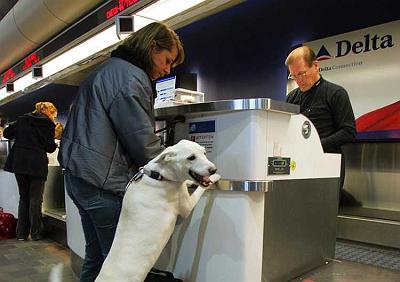
A
half-million pets fly each year, according to statistics
compiled by the U.S. Department of Transportation. (AP)
click
√
on image for full article
|

Alabama
Dog Fighting Bust
45 Dogs Seized, Remains Found
June
5, 2009
On Monday, June 1, a dog fighting operation in Randolph County,
AL, was raided by the state’s 5th  Judicial
Circuit Drug Task Force. The ASPCA dispatched forensic veterinarian
Dr. Melinda Merck and our Mobile Animal Crime Scene Investigation
Unit to collect evidence in the investigation and aid in the
prosecution of the case. Judicial
Circuit Drug Task Force. The ASPCA dispatched forensic veterinarian
Dr. Melinda Merck and our Mobile Animal Crime Scene Investigation
Unit to collect evidence in the investigation and aid in the
prosecution of the case.
Dr. Merck examined 45 dogs who were discovered tied to heavy
chains and living in deplorable conditions on two properties.
She also examined partially buried skeletal remains of a dog
found on site. In addition, controlled substances, illicit
drugs and other paraphernalia related to dog fighting have
been collected into evidence.
“These dogs definitely suffered abuse and inhumane treatment
at the hands of dog fighters,” says Dr. Merck, Senior
Director of Veterinary Forensics for the ASPCA. “So
far, we’ve seen that one is unable to walk, another
who is limping, and many who are injured, some severely.”
As a result of ASPCA participation, two suspects have been
formally charged. William Alsabrook was charged with two counts
of possession of dogs for fighting, and Artis Kyle was charged
with one count of possession of dogs for fighting, two counts
of possession of a controlled substance, one count of possession
of drug paraphernalia and one count of being a felon in possession
of a firearm.
View
video footage of the scene.
Learn
more about the brutal world of dog fighting and what you can
do to help end this cruel “sport.”
|

CANCER RX FOR BOWSER
By TODD VENEZIA
June
4, 2009
Dog lovers rejoice: A new canine-cancer
drug announced yesterday promises to save the lives of countless
pups.
"It's very exciting," said Manhattan veterinary oncologist
Dr. Karen Oberthaler. "It's the first of its kind in veterinary
medicine."
The new drug, Palladia, is the first cancer medicine approved
by the Food and Drug Administration specifically for dogs.
It's designed to kill mast-cell tumors, one of the most common
and deadly forms of canine skin cancer.
It will allow Fido to fight cancer in a manner already available
to humans, by specifically targeting the tumor. It could reduce
the need for dangerous chemo and radiation therapy for dogs
with this kind of cancer.
"It's very targeted," said Oberthaler, who practices
at NYC Veterinary Specialists. "It has a lot less toxicity
[than radiation and chemo], and for our dogs that's huge. It
should really minimize the risk of these things."
The drug is expected to be available to vets in 2010.
Dr. Edwin Brodsky, of the Veterinary Oncology & Hematology
Center in Norwalk, Conn., said this may signal a wave of animal
cancer drugs.
"It's a very important breakthrough in the treatment of
cancer in dogs, and it's something we hope will continue,"
he said. |

ASPCA
Rescues Over 300 Animals from deplorable conditions!
June
2, 2009
On
Tuesday morning, May 19, the ASPCA was on hand in Cazenovia,
WI, to assist in the raid of an animal sanctuary, the Thyme
and Sage Ranch. The ASPCA Forensic Cruelty Investigation and
Disaster Response teams, as well as our Mobile Crime Scene
Investigation (CSI) Unit, are currently working alongside
the Richland County Sheriff’s Department to collect
evidence and evaluate the animals found at the site.
UPDATE
Approximately 374 animals were discovered during the execution
of the search warrant, led by the Richland County Sheriff’s
Department. Most of the animals were housed in deplorable
conditions . On May 21, 2009, Jennifer Petkus, the founder
of the Thyme and Sage Ranch was charged with 11 counts of
misdemeanor animal cruelty and 5 forfeitures. More than 270
animals have been relinquished by Ms. Petkus to animal welfare
groups throughout Wisconsin and will eventually be made available
for adoption. The ASPCA continues to collect evidence and
actively aid the prosecution in building the criminal case.
|
 Couple
to plead guilty in toxic pet food case
Couple
to plead guilty in toxic pet food case
June
3, 2009
KANSAS CITY, Mo. – A Las Vegas-based company and its owners
have agreed to plead guilty in  connection
with tainted pet food in 2007 that may have killed thousands
of dogs and cats . connection
with tainted pet food in 2007 that may have killed thousands
of dogs and cats .
Stephen S. Miller (left) is co-owner of ChemNutra
Inc. An attorney for Miller filed documents last week in federal
court in Kansas City saying Miller had reached a plea agreement
with prosecutors and would plead guilty plea at a hearing June
16.
Miller's wife, Sally Miller , and ChemNutra also planned to
plead guilty. Attorneys did not immediately return calls.
The Millers and ChemNutra were indicted in February 2008 on
charges of selling Chinese-made wheat gluten tainted with the
chemical melamine to pet food makers .
Pet owners reported thousands of dogs and cats becoming ill
or dying after eating the tainted food. |

DOG-O-MATIC
A REAL SPOT CLEANER
By BRUCE GOLDING
May
26, 2009
There are dog walkers, and doggy day care. And now -- canine
fluff 'n' fold.
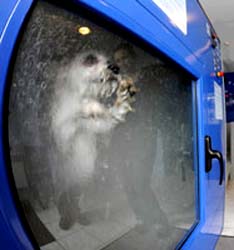
A French entrepreneur has invented an automatic dog-washing
machine that promises to clean and dry dirty pooches in 30
minutes or less.
Romain Jarry, 31, insists his Dog-o-Matic is humane, but this
photo of it at work in his hometown of Saint-Max suggests
something more akin to canine waterboarding.
A wash costs about $20 to $48, depending on the size of your
pet.
After
drawing raves in Saint-Max, Jarry hopes to expand into England.
"The dogs don't seem to get bored," he told Britain's
Daily Mail newspaper. "They just sit there, and they
come out clean."
Photo:
Gamma/ZUMA Press
|

Weird but True
DAVID
L. LEE
May
26, 2009
A Michigan man's decision not to end his terminally ill Bulldog's
life ended up saving his own.
Scott Seymour said the pooch, Brittney, awakened him with her
barking in time for them to escape a burning house in Grand
Rapids.
Brittney was diagnosed with terminal cancer two weeks ago. Seymour
opted for pain-killing meds until death comes naturally. |
The
smelly dog stays -- the anchorwoman goes
 SCOOP & HOWL - commentary
SCOOP & HOWL - commentary
We’ve
been through Co-op
Hell
ourselves and know what it’s like.
We could not remain
in the noxious environs of 15 East 10th Street
with this cadre of megalomaniacs and gossips lording over
us, with their prying and their abuse.
I rather live with
animals than in such "company".
We bought our Dogs
a house on an acre of wooded land, The DOGHOUSE,
where they are happy and safe, where our
Dogs
can be Dogs.
It’s
THEIR house and we serve at THEIR
pleasure.
We
lost an apartment and found a HOME.
Other
than bugs and bears, we suffer no pests...
...and the shoe WILL drop..., on OUR timetable.
~
RC.

|
UPDATE:

DOG
STAYS
BY ODOR OF THE COURT
Janon
Fisher
May
24, 2009

A
Housing Court judge has curbed SOLEDAD
["Loneliness"
in Spanish ] O'BRIEN's attempt to evict a family
from her swanky Chelsea co-op building because their mutt
is messy.
O'Brien, a CNN correspondent, was secretary of the West 26th
Street co-op board when it claimed in a 20-page affidavit
that Steven Lyon's Neapolitan Mastiff, Ugo, violated the terms
of their co-op lease because of his "size, slobbering,
shedding, drooling, gassiness and odors."
She signed a notice ending the Lyons family's lease and began
eviction proceedings in January. Manhattan Housing Court Judge
Arlene Hahn dismissed the case Monday, ruling the dog's owners
were not properly served in the suit.

"The board is trying to evict a family, and it can't
even serve the initial papers correctly," said Michael
Schwartz, the lawyer for the family. "Maybe the board
should be put on a leash."
After
The Post broke the story in January, the backlash against
the TV newswoman was so strong, she was forced to resign from
the board.
"After discussions with neighbors and others, [my husband]
and I have become increasingly concerned about my personal
safety," O'Brien wrote in a Feb. 16 e-mail to the co-op.
Lyons said neighbors welcomed him after he bought his $3 million
apartment in 2003.
But that changed in March 2007, when he obtained Ugo, bred
from an award-winning bloodline, in Turin, Italy. By that
summer, a new board had begun complaining, despite a co-op
agreement allowing pets.
Lyons said he began taking Ugo to a grooming salon three times
a month and spritzing him with an orange-scented deodorizer.
He also offered to use the freight elevator to walk the dog,
but the board was set on eviction.
O'Brien
did not respond to requests for comment.
Jerry Montag, the co-op's lawyer, declined to comment.
OXY MORON MORON
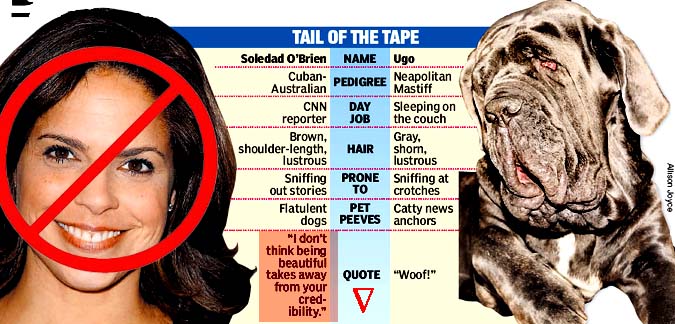
 SCOOP & HOWL - from
the archives
SCOOP & HOWL - from
the archives

RUFF CO-OP WAR
CNN'S O'BRIEN BIDS TO BOOT 'STINKER'
By JANON FISHER
January
18, 2009
GOOD BOY: A Chelsea co-op board has moved to kick
out allegedly "gassy" mastiff Ugo, here
with 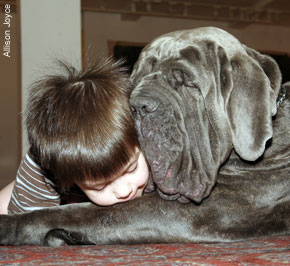 pal
Emory. pal
Emory.
CNN correspondent Soledad
O'Brien wants this dog gone.
The newswoman and other members of a Chelsea co-op
board are trying to evict a beloved family pet from
a swanky loft building because they say the dog is
smelly and slobbers. O'Brien, in a 20-page affidavit,
complained about the pooch's "size, slobbering,
shedding, drooling, gassiness and odors."
"She told me at a shareholder's meeting that
my dog stinks," said Steven Lyons, owner of Ugo,
a good-natured, 150-pound mastiff.
Lyons, an immigration lawyer, lives with his wife
and their three kids in a loft three floors above
the journalist on West 26th Street.
O'Brien, the co-op board's secretary, signed a notice
on Jan. 5 that terminated the family's lease, the
 first
legal step before asking a Housing Court judge to
remove the dog or the family from the building. first
legal step before asking a Housing Court judge to
remove the dog or the family from the building.
"Her behavior has been particularly outrageous,"
Lyons said of O'Brien. His wife, Monica Nelson, said,
"She did get in my face." "What's the
matter? Aren't you talking to me?" she said O'Brien
asked her.
Other board members ridicule Nelson by holding their
noses when they ride the elevator with her - even
when she's not with Ugo.
Lyons said neighbors had welcomed him to the building
after he purchased his $3 million, 4,000-square-foot,
eighth-floor apartment in 2003. But that changed in
March 2007 when he got the Neapolitan Mastiff, bred
from an award-winning bloodline, in Turin, Italy.
By that summer, a newly elected board had begun complaining,
despite a co-op agreement allowing pets and the fact
that several residents own cats.
Lyons said he began taking Ugo to a pet-grooming salon
three times a month and spritzing him with an organic,
orange-scented deodorizer. He also offered to use
the freight elevator to walk the dog, but the board
refused to allow it.
Soon the family will have to defend the dog in Housing
Court. "No family should have to decide between
its own shelter and putting the family pet in a shelter,"
said Michael Schwartz, the family's lawyer.
O'Brien, 42, an anchor and special correspondent for
"CNN Worldwide," declined comment.
RELATED
STORY:
O'BRIEN HAS A HISTORY OF AUTHORITARIAN OVERZEALOUSNESS

CNN's
Soledad O'Brien Calls Russ Feingold "Crazy"
Submitted by Bob Fertik
March
13, 2006
 Monday
morning at 7:15 a.m., CNN American Morning anchor
Soledad O'Brien conducted one of her regular vicious
jihads against a Democrat. Her victim this morning
was Senator Russ Feingold, who has the audacity to propose
censuring George Bush for repeatedly breaking the
law by authorizing warrantless wiretaps of law-abiding
Americans. (CrooksandLiars.com has the video.) Monday
morning at 7:15 a.m., CNN American Morning anchor
Soledad O'Brien conducted one of her regular vicious
jihads against a Democrat. Her victim this morning
was Senator Russ Feingold, who has the audacity to propose
censuring George Bush for repeatedly breaking the
law by authorizing warrantless wiretaps of law-abiding
Americans. (CrooksandLiars.com has the video.)
Feingold's proposal was introduced with full seriousness
and recognition of its gravity. But O'Brien didn't
want to discuss the substance of the proposal - she
just wanted to call Feingold crazy, which she did
repeatedly.
Namecalling is easy and cheap. If I wanted to smear Soledad
O'Brien, I could call her a "fascist."
In fact, I just did - see the image on the left.
|

January
22, 2009
CNN's
Soledad O'Brien vs.Ugo the Dog
CAT
WOMAN SOLEDAD O'BRIEN TRYING TO EVICT MASTIFF
View FOXnews
INTERVIEW.
Go to >
 > Pooch Problem?
> Pooch Problem?
FOX & FRIENDS
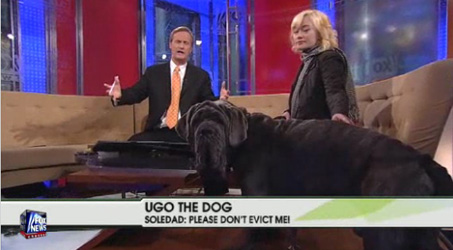

Ugo's Mom

UGO |

ATTORNEY
STEVEN LYONS
Ugo's Dad
|
WRITE
>>>
Soledad
O’Brien
142 W 26th St
New York, NY 10001
Contact CNN >>>
http://www.cnn.com/feedback/forms/form1.html?35
|
|

IN
THE SPOTLIGHT
UPDATES
May 17, 2009 -- The pregnant Beagle from Atlanta
to be euthanised was rescued. All of the
Atlanta rescue groups were called by SOS and Beagles on the Web plus
a huge network
of individuals helped spread the word. The Beagle was picked up by
Douglas County
Animal (‘no kill’) Rescue and is safe to have her pups.
• • •
May 6, 2009 --
The two Beagles found at Alley Pond Park in Queens NY
have been
adopted and have their Forever Home.
GOOD JOB, PAT
HOPPER, ELENA TERRONE AND TINA LEAR

Wash. state woman 1st death under new suicide law
By RACHEL LA CORTE
Associated Press Writer
May
24, 2009
OLYMPIA, Wash. (AP) -- Linda Fleming was diagnosed with terminal
cancer and feared her last days would be filled with pain and
ever-stronger doses of medication that would erode her mind.
The 66-year-old woman with late-stage pancreatic cancer wanted
to be clear-headed at death, so she became the first person
to kill herself under Washington state's new assisted suicide
law, known as "death with dignity."
With family members, her physician and her dog
at her side, Fleming took a deadly dose of prescription
barbiturates and died Thursday night at her home in Sequim,
Wash. |

HERE'S
LATEST POOP-SCOOP ON 'LIBERATED' DUBYA
By TODD VENEZIA, Post Wire Services
May
23, 2009
 Now
that he's no longer commander in chief, George W. Bush's life
has gone to the dogs. Now
that he's no longer commander in chief, George W. Bush's life
has gone to the dogs.
The former president -- talking for the first time about his
post-White House life -- said his new station as a humble citizen
officially set in when he found himself stooping to pick up
pet pup Barney's poop during a walk near his Dallas home.
"And there I was, former president of the United States
of America, with a plastic bag on my hand," he said. "Life
is returning back to normal." The ex-president made his
canine comments in a speech Thursday to scholarship winners
at a high school in tiny Artesia, NM.
"I no longer feel that great sense of responsibility that
I had when I was in the Oval Office. And frankly, it's a liberating
feeling," he told the students.
Photo:
Heil To the Chief, sculpture by

Rodin S. Coane
(click √
for artist page)

DOG SPARED UNKIND CUT
May
23, 2009
A prized German shepherd was spared the cruelest cut yesterday
after the escaped pet's owner won a courtroom dogfight with
a Manhattan animal shelter.
Clyburn Sowell, 50, said he was shocked to learn his pricey
breeding dog, Sampson, and a second pet, pit-bull-mix Papo,
faced mandatory neutering after they were picked up roaming
the streets in their Queens neighborhood Wednesday.
"He's a gentle giant," a weepy Sowell said of Sampson,
who comes from a long line of registered champions. "If
they were to neuter him, that would be like a death sentence
. . . It's a financial disaster."
The distraught dog owner filed emergency court papers when the
Animal Care and Control Center on 110th Street refused to release
his pets without performing the surgery.
Supreme Court Justice Martin Schneier blocked the city from
wielding the knife on Sampson and ordered both dogs released.
Schneier found that city lawyers defaulted by failing to show
up in court.

Weird
but True
By LUKAS I. ALPERT
May
23, 2009
These creatures have no bark and no life, but they may do a
town some good in the hereafter.
The sheriff's department in Saginaw, Mich., is auctioning off
a menagerie of seized taxidermy and vehicles and will use
the proceeds to start a K-9 unit.
On sale are a stuffed elk, a wolf and a coyote. |

Weird but True
TODD
VENEZIA
May
22, 2009
A
66-year-old Pennsylvania man was busted after he admitted to
his relatives that he was having a relationship with the family
dog.
Robert John Ward -- a previously convicted sex offender -- was
jailed after cops performed a human rape-kit exam on the canine
to prove that she had been molested.
• • •
Britain
has opened its first blood bank for dogs.
It takes donations just like a human blood bank, and stores
the blood by type. Unlike a people blood bank, however, doggie
donors get dinner after they do their good deed.

HOUSE-TRAINED
HOME IS VICK 'JAIL'
May
22, 2009
HAMPTON, Va. -- Suspended NFL star Michael Vick arrived at his
Virginia home yesterday after being released from federal prison
to begin home confinement and try to resume his pro football
career.
A four-car caravan pulled into Vick's five-bedroom brick home
at 8:25 a.m. A crowd of onlookers was waiting to see the Kia
Sedona in which Vick rode with his fiancée, Kijafa Frink.
"He's happy to be reunited with his family," said
Chris Garrett, a member of Vick's legal team.
Two probation officers then arrived to outfit Vick, 28, with
an electronic monitoring device.
The quarterback spent 19 months in federal prison for financing
a dogfighting operation. Once released at about 4:30 a.m. Wednesday,
Vick traveled 1,200 miles in about 28 hours to get home, where
he will live with Frink and their two kids. He will spend two
months working a $10-an-hour construction job, and then will
have three years on probation.
His ultimate goal is a return to the NFL, but first, he will
have to convince Commissioner Roger Goodell that he is truly
sorry for his crime.
Former Atlanta Falcon receiver Roddy White says his ex-teammate
should be allowed to return.
"Mike's already paid his dues," White said Wednesday.
"He wants to play football."
Vick
has said he will partner with the Humane Society of the United
States, assisting the animal-rights group in eradicating dogfighting
among urban teens.
|

Wisconsin
Animal Sanctuary Raid: ASPCA Rescues Over 300 Animals from
"Trusted Sanctuary"!
May
22, 2009
On Tuesday morning, May 19, the ASPCA was on hand in Cazenovia,
WI, to assist in the raid of an animal sanctuary, the Thyme
and Sage Ranch. The ASPCA Forensic Cruelty Investigation and
Disaster Response teams, as well as our Mobile Crime Scene
Investigation (CSI) Unit, are currently working alongside
the Richland County Sheriff's Department to collect evidence
and evaluate the animals found at the site.
"We
are just starting to scratch the surface of what appears to
be a horrendous situation," says ASPCA Disaster Response
Team member Sandy Monterose.
Since 2007, the ranch has held the animal control contract
for Richland County, WI, and acted as the county's animal
shelter. The ASPCA became involved in the raid at the request
of the Richland County District Attorney and Dane County Humane
Society, which began investigating the Thyme and Sage Ranch
because of public complaints.
As of now, animals continue to be examined both on the scene
and in the ASPCA Mobile
CSI Unit.
|
 SCOOP & HOWL - from
the archives
Abby
Toll Taped Shiba Inu To Fridge
SCOOP & HOWL - from
the archives
Abby
Toll Taped Shiba Inu To Fridge
Monday,
April 20, 2009
BOULDER, CO -- Police say Abby Toll, an environmental design
major at the University of Colorado, wrapped her boyfriend's
dog Rex, a Shiba Inu, in packing tape and stuck the canine upside
down to a refrigerator because he wouldn't kick the pooch out.
Toll, 20, was arrested Tuesday after authorities say she got
into a fight with her boyfriend Bryan Beck. According to AP
reports, she was charged with felony cruelty, drug possession
and other counts and was freed on $12,500 bond.
Beck, 21, faces lesser charges including a misdemeanor cruelty
count.
Police say Toll used packing tape to bind the legs, snout and
tail of the Japanese breed. She informed police that she stuck
the dog to the refrigerator because she was angry Beck didn't
want to get rid of it.
Rex was taken to a shelter and is being put up for adoption.
|

Family
angry after police shoot dog
By Becky Schlikerman, Staff writer
May
18, 2009
Behind Amber Singleton's Chicago Heights home there's now
a neat, yet ornate, gravesite topped with a headstone bearing
a paw print, a heart and the words "Beloved friend."
Behind that, a flowered wind chime tinkles in the breeze.
Inside the home, the wood floor in the dining room is pocked
with bullet holes.
The floor was marred May 1 when Chicago Heights police shot
and killed Singleton's dog after police responded to a domestic
disturbance at the home. Police shot the 84-pound pit bull
eight times when it escaped from its cage and charged towards
them, police said. But Singleton thinks they used excessive
force and killed "Sin," short for Cinnamon, simply
because he was a large pit bull.
"No sooner did he stop, they shot him," said the
27-year-old office assistant as she wore a memorial T-shirt
with her dog's picture and the dates of his birth and death.
"It's like losing a child."
But the officers did the right thing because they were in
danger of being attacked, Chicago Heights Deputy Chief Michael
Camilli said. He said it's not unusual for the police to shoot
a dog if they feel threatened.
In this case, the incident began early May 1 when Singleton
called police about 4 a.m. because her live-in-boyfriend,
Robert Smith, was arguing and fighting with a relative inside
the house in the 1600 block of Hanover Street.
After police arrived at the home, Sin, one of the couple's
three pit bulls, got out of his cage and charged the officers,
police said. Two officers fired one shot each at the dog and
another fired six shots, police said. Camilli said those eight
shots were necessary.
Singleton said she wishes she hadn't called the police that
morning. "I will never call them," she said. "I
don't trust them." And she said it speaks to the bigger
issue of police relations in the city's crime-ridden East
Side. "This is why people in the neighborhood we live
in don't call (police)."
Camilli, though, stood by his officer's decisions.
|

Chicago police dog found 4 days later
Bear disappeared after spooked by thunder
By Andrew L. Wang | Tribune reporter
May
18, 2009
A
thunderbolt clapped Wednesday night, and Bear the police dog,
apparently spooked by the noise, 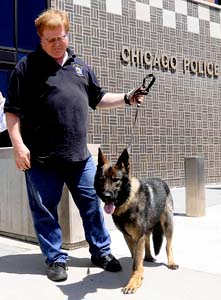 took
off, leaping over a fence and into the night. He wasn't seen
again until Sunday morning, when a man walking to a hardware
store spotted him near a cemetery on the border between Evergreen
Park and Chicago. took
off, leaping over a fence and into the night. He wasn't seen
again until Sunday morning, when a man walking to a hardware
store spotted him near a cemetery on the border between Evergreen
Park and Chicago.
Bear looked up and cocked his head quizzically, Howard Overton
said. "I said, 'That looks like the dog on the news.'
"
Overton flagged down a nearby police car, and a few minutes
later, the officer tracked Bear down. A scan of the microchip
in his neck confirmed his identity.Related links
Firefighters rescue 2 men, 3 puppies
By midday, the 2 1⁄2 -year-old German shepherd
was reunited with his handler, Canine Unit Officer Rick King.
At a news conference Sunday afternoon, Bear, who panted happily
as he soaked up the attention from reporters, appeared to
have suffered few effects from his days away from home.
"He's a little shaggy and a little dirty," King
said. "But otherwise, he seems fine."
King took Bear out into the backyard of his home in the 3800
block of West 109th Street about 10:30 p.m. during a break
in Wednesday's thunderstorms to allow the dog to relieve himself.
Then, rolling thunder startled him, and he suddenly headed
for the corner of the yard, where a neighbor's 5-foot wooden
fence meets King's fence; climbed it; and disappeared.
King said he had slept about five hours since Bear vanished
and had followed up calls of found dogs from as far north
as Montrose Avenue. "It's like your child. Animal lovers
will know what I'm talking about," King said.
King said the dog was most likely hunting small animals in
the wooded areas of the Far Southwest Side.
"He's a little hunter," he said.
Photo:
Bear the Chicago Police Dog is reunited with his partner Rick
King at Area 8 Police Headquarters in Chicago, (David Banks,
Chicago Tribune)
|

Heroes Help Save Canine Cruelty Victims
May
15, 2009
On April 23, ASPCA Humane Law Enforcement Agents arrested Staten
Island resident Tyrone Walker for animal cruelty. Walker, 41,
was charged with two counts of misdemeanor animal cruelty and
two counts of abandoning an animal. If convicted, he faces up
to two years in jail and a $2,000 fine.
On the afternoon of April 2, witnesses near Marcus Garvey Park
in Manhattan saw a man, later identified as Walker, take two
dogs out of his car, tie the dogs to a park fence and drive
away. Concerned passersby called the police and provided the
car’s license plate number and descriptions of the man.
When animal control arrived at the scene, they
discovered that one of the dogs, an elderly male Rottweiler,
was frothing at the mouth and unable to stand. Both dogs were
rushed to the ASPCA Bergh Memorial Animal Hospital.
The Rottweiler, named Shadow, was gravely ill with cancer and
died soon after arrival. The other dog, an 8-year-old Belgian
Shepherd named Savannah, was diagnosed with Lyme disease but
was otherwise fairly healthy. She is currently progressing well,
recovering with the help of ASPCA veterinarians and is not available
for adoption at this time.
ASPCA Agents arrested Walker without incident. Although he initially
denied ownership of the dogs, he later admitted that they had
been given to him by a friend.
This arrest was made possible through the involvement of concerned
citizens who witnessed Walker’s alleged actions and decided
to do something about it. We all are capable of this type of
heroism—please use your voice for those who cannot speak
for themselves, and report
abandonment, neglect and cruelty to animals. |

Where has police dog gone? Chicago canine officer searching
for missing partner
German shepherd ran off after being spooked by
thunder
By Lauren R. Harrison | Tribune Reporter
May
15, 2009
A Chicago police dog named Bear should be given a new moniker:
Houdini, his handler said. The 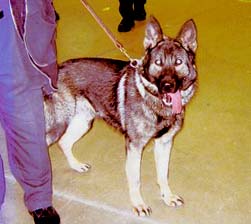 German
shepherd has been missing since Wednesday night after he was
spooked by thunder and climbed a fence near the officer's Southwest
Side home, Canine Unit Officer Rick King said. German
shepherd has been missing since Wednesday night after he was
spooked by thunder and climbed a fence near the officer's Southwest
Side home, Canine Unit Officer Rick King said.
Bear has always been afraid of thunder, but he's not afraid
of gunfire, King said. He took the dog out into the backyard
of his home in the 3800 block of West 109th Street about 10:30
p.m. during a break in Wednesday night's thunderstorms so Bear
could relieve himself, he said.
Then, as Bear started eating, thunder startled him. He suddenly
headed for the corner where a neighbor's 5-foot wooden fence
met King's fence and climbed it, King said.
"He stopped eating and just took off," possibly headed
east, said King, a 22-year veteran of the canine unit. "Whether
he thinks he's running away from the thunder or going to find
it and kill it, I don't know."
Bear was last seen at 103rd Street and Lawndale Avenue on the
St. Xavier University campus, according to an off-duty detective
who spotted him running shortly after 10:30 p.m., King said.
Since the dog left, King has been searching on the Southwest
Side and suburbs, including Alsip, Evergreen Park and Oak Lawn.
He only had two hours of sleep by Thursday morning when he began
searching for the dog again at 8 a.m. About five canine unit
officers were still looking for Bear in the Mt. Greenwood area
Thursday afternoon, King said.
Some of King's past canine-unit dogs have also been afraid of
fireworks, he said. "I've had previous canine dogs that
wouldn't flinch at gunfire but hated fireworks. They distinguish
a difference," he said.
Being unaware of a sound's source probably "freaks them
out," King said. "If they know the source, they're
fine with it."
Whenever a thunderstorm arises, the dog, which was raised on
a farm in Germany, behaves differently, he said. "He's
antsy, paces, chews on things; it's like he wants to get out
[of the house]," said King, who first saw the dog when
he was a year old.
Bear "is a family pet," who happily plays with King's
fiance's collie and "likes to be everybody's friend,"
King said, which is unusual for "alpha male" canine
dogs. "Kids come up, and then he'll lick them or let them
pet him," King said.
King remained hopeful that Bear -- a black-and-tan 2 1⁄2
-year-old who weighs about 74 pounds -- was in good condition
and just couldn't track himself back home because of the bad
weather.
"He's probably running around looking for dogs to play
with, driving his daddy crazy," King said. Bear has an
identification computer chip implanted on the back of his neck,
King said.
His advice for people who spot the playful German shepherd:
"Feed him some cheese or something, and he would love it.
And call the police, and we'll be there fast."
Anyone who finds Bear should call the Chicago Police Canine
Unit at 312-746-7180, King said.
"Bear"
the police dog has been missing since Wednesday night after
he was spooked by thunder and climbed a fence near the officer's
Southwest Side home. (Chicago Police Dept. photo)
Tribune
reporter Liam Ford contributed to this report. |

200 Dogs Begin New Lives Following Puppy Mill Rescue Sign the
Pledge
May
14, 2009
Two hundred cast-off puppy mill dogs from Missouri are safe
after being delivered to local rescue  groups
in the New York area. Best Friends Animal Society, in collaboration
with National Mill Dog Rescue, arranged for the release and
transport of the dogs and after a long but hopeful cross-country
journey over the Mother's Day weekend, they were delivered to
waiting groups here at North Shore Animal League America. groups
in the New York area. Best Friends Animal Society, in collaboration
with National Mill Dog Rescue, arranged for the release and
transport of the dogs and after a long but hopeful cross-country
journey over the Mother's Day weekend, they were delivered to
waiting groups here at North Shore Animal League America.
In addition to North Shore Animal League America, representatives
from four animal welfare organizations were ready and waiting
as the dogs were delivered to the Animal League complex: Animal
Rescue Fund of the Hamptons, Wainscott, N.Y.; Mt. Pleasant Animal
Shelter, East Hanover, N.J.; Noah's Ark Animal Welfare Association,
Ledgewood, N.J.; St. Hubert's Animal Welfare Center, Madison,
N.J.
Among the rescued dogs are adults that were used for breeding,
adolescents and puppies, including various breeds such as Cocker
Spaniels, Chihuahuas, mini Pinchers, Jack Russell terriers and
poodle mixes. Dogs like these, considered used up or unsalable
by large commercial breeders, are typically killed or sold at
mill dog auctions for as little as 25 cents. Instead, these
dogs will get a new chance for happy lives and made available
for adoption from local area rescue groups.
Joanne Yohannan, senior vice president of operations for the
Animal League, said that the rescued animals remaining at the
facility would be given time to settle in, and be fed and hydrated
after their long journey.
"We first must get the dogs feeling safe and comfortable
in their new environment, Ms. Yohannan said. "Then our
staff experts will begin the process of evaluating each animal.
This includes medical examinations, behavioral evaluation to
determine their emotional and psychological status and grooming,
which will help make them feel and look better. These dogs will
experience the nurturing and the warmth of human contact they
have been deprived of all their lives to prepare them for adoption
into the loving homes they deserve."
"Rather than being needlessly killed because they were
no longer wanted by their breeders, some beautiful dogs are
about to begin a new and exciting phase of their lives,"
said Kelli Ohrtman, campaign specialist for Best Friends Animal
Society, which funded the rescue of the dogs to the New York
area through its "Pup My Ride" transportation program.
Teresa Strader, director of National Mill Dog Rescue, based
in Colorado Springs, Colo., said the collaborative nature of
the rescue is a direct indication of the growing network of
rescue organizations across the country with an interest in
putting an end to current commercial dog breeding practices.
"This effort will make a life-changing difference for some
200 dogs and the people lucky enough to adopt them," Strader
said. "But it is estimated that there more than one million
dogs held captive in puppy mills today and we ask people to
never forget the victims left behind."
The rescue and transport of the dogs is part of Best Friends
Animal Society's "Puppies Aren't Products" national
campaign, which also targets the retail end of the puppy mill
industry through informational demonstrations at puppy emporiums.
Launched in Los Angeles last year, the peaceful pet store demonstrations
have succeeded in convincing stores to adopt a humane business
model that relies on the sale of pets from rescue groups and
shelters rather than dogs from puppy mills. The campaign is
being expanded nationally to help unsuspecting consumers become
aware of the cruelty behind many dogs offered for retail sale.
"Puppy mill dogs comprise a significant percentage of the
4-5 million pets that die in American shelters annually,"
said Ohrtman. "The mission of Best Friends Animal Society
is to bring about a time when there are no more homeless pets.
It's what the public wants and the pet trade industry must change
dramatically or it will become a relic of the past."
The Animal League is in the process of evaluating the dogs for
adoption. They will be medically treated and spayed and neutered.
They will also be temperament tested. Within the next two weeks,
about 150 dogs will be ready for adoption.
"Once our staff experts have determined that the dogs are
ready for adoptions we will be eager to find the perfect homes
for each and every one of these wonderful dogs," said Ms.
Yohannan |

New
Chapter in Dog Tale
William J. Gorta
May
14, 2009
A
Queens judge granted visitation rights to a woman fighting
to regain custody of her beloved Yorkie.
Ravely
Arias left Panda, the tug-of-love terrier, with her friend,
Leandro Rohde, in January. She says it was temporary; he claims
it was permanent.
Justice
Valery Brathwaite Nelson said Arias could have unsupervised
visits with the Dog for 13 hours each weekend until the case
is decided.
"We're
very excited," said Arias' lawyer, Lary Hutcher, who
called Panda "the most litigated little animal in the
history of the world."
|

Dog's birthday party to be held at Neiman Marcus
Tiger Lily, a Shih Tzu, is turning 10
By Vikki Ortiz | Tribune reporter
May
14, 2009
Tiger Lily Wayman of Oak Brook will celebrate her 10th birthday
Friday at Neiman Marcus, in a private room adorned with fresh
floral centerpieces, a custom-designed chocolate ganache and
yellow cake, and candy party favors wrapped in gold foil for
her 70 guests.
Tiger Lily is a Dog, by the way.
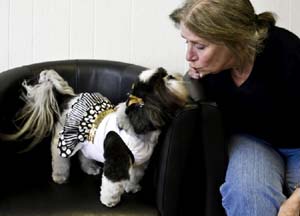
"She's a celebrity," corrects her owner, Pat Wayman,
67, who has set aside a special party dress and Louis Vuitton
collar for the black and white Shih Tzu to wear to her Oscar-themed
party.
The celebration -- which could cost $1,200 -- is a fitting fete
for a Dog who shops regularly with Wayman at Neiman's and other
high-end Oakbrook Center stores.
"The Dog's always very nicely dressed in Juicy Couture
and Burberry," said Carolyn Smith, an employee at Bailey
Banks & Biddle, where Tiger Lily's photo hangs in the back
break room. "She's been a very nice customer, and she knows
all of us."
Wayman bought Tiger Lily after her mother, sister and husband
all died within a short time. After the deaths, and another
tragedy she won't talk about, Wayman took Tiger Lily everywhere
she went. She carries a psychiatric prescription that identifies
Tiger Lily as a service dog that helps prevent panic attacks.
Because she is a service Dog, Tiger Lily is the only canine
allowed at the party, which Wayman says is a way to thank friends
for their support. And, in a struggling economy, people need
a pick-me-up, she said.
"If you can make people, just for one moment, forget ...
this helps," she says.
Photo:
Patricia Wayman solicits a kiss from 10-year-old Tiger Lily
after the dog had her coat trimmed. This Saturday, the dog
will have a birthday party at Nieman Marcus with seventy guests.
(Bill Hogan/Chicago Tribune
|

A SPECIAL CHANCE FOR A HAPPY ENDING!
From Missouri to New York with love …
May
11, 2009.
In a Mother’s Day weekend to remember, Best Friends
rescued 215 dogs from Missouri puppy mills  and
transported them to New York for a new “leash”
on life. and
transported them to New York for a new “leash”
on life.
These dogs, discarded from mills, include older dogs who were
no longer profitable breeders. And they include puppies with
health issues who didn’t quite “make the grade”
in the eyes of the breeder. If they hadn’t been rescued,
these sweeties would most likely have been killed, or sold
at auction for as little as 25 cents.
Partnering with National Mill Dog Rescue, we took Cocker Spaniels,
Chihuahuas, mini Pinchers, Jack Russell terriers and poodle
mixes – all in high demand in the New York/ New Jersey
area – to North Shore Animal League America and other
local partners who will find just the right family for each
of them.
And, of course, a few of the dogs who showed signs of more
severe trauma are happy to be coming back with the Best Friends
crew to the quiet beauty of the Sanctuary in Utah to receive
some much-needed TLC.
The rescue and transport of the dogs is part of Best Friends'
Puppies Aren't Products national campaign. We’re also
targeting the retail end of commercial breeding through peaceful,
educational demonstrations at puppy stores.
If more people knew where the puppies in the pet stores and
on the Internet came from – born to over bred and neglected
mama and papa dogs like many of the ones saved this weekend
– more people would choose to adopt instead of supporting
puppy mills through buying … one giant leap towards
No More Homeless Pets!
The driving force behind all of this is the love and support
from our members around the country. And as this campaign
ramps up around the nation, we will need you more than ever!
Please
consider a special gift to help us end puppy mills.
|

ASPCA Experts Help Secure Puppy Mill Conviction
May
8, 2009.
This past March, Dr. Melinda Merck, ASPCA Senior Director
of Veterinary Forensics, helped secure   an
animal cruelty conviction by testifying in the trial of Kathy
Bauck, operator of Pick of the Litter Kennels. The New York
Mills, MN, breeder sells animals to pet stores and online—and
has at times housed more than 1,300 dogs of at least 32 different
breeds. Bauck was arrested in August 2008 and charged with
several counts of felony animal cruelty, torture and practicing
veterinary medicine without a license. On March 24, after
a 41⁄2-day trial and six hours of deliberation, a jury
cleared Bauck of felony charges but found her guilty of four
misdemeanors (one count of animal cruelty and three counts
of torture). an
animal cruelty conviction by testifying in the trial of Kathy
Bauck, operator of Pick of the Litter Kennels. The New York
Mills, MN, breeder sells animals to pet stores and online—and
has at times housed more than 1,300 dogs of at least 32 different
breeds. Bauck was arrested in August 2008 and charged with
several counts of felony animal cruelty, torture and practicing
veterinary medicine without a license. On March 24, after
a 41⁄2-day trial and six hours of deliberation, a jury
cleared Bauck of felony charges but found her guilty of four
misdemeanors (one count of animal cruelty and three counts
of torture).
In early 2008, a freelance animal cruelty investigator, Jason
Smith, began working at Pick of the Litter to gather evidence
against Bauck. Smith submitted testimony and videos of alleged
abuse to Otter Tail County sheriff’s detectives last
May. The videos included footage of injured, ill and emaciated
dogs, as well as of Bauck dunking dogs in vats of insecticide.
“The veterinarian working with the prosecution contacted
me about one month before the trial started,” recalls
Dr. Merck. “I was asked by the prosecutor to review
all the video and case files and provide expert opinion.”
With a history of complaints and citations against her—including
a 2006 cease-and-desist order from the Minnesota Board of
Veterinary Medicine for performing surgery on animals without
a veterinary license—Bauck is well known to ASPCA investigators.
“Kathy Bauck has been a chronic problem,” states
Bob Baker, ASPCA Anti-Cruelty Initiatives Investigator. “I
visited her facility in 1998 and reported her to the USDA
for violations of the Animal Welfare Act—but as far
as I know, there was no follow-up on the part of USDA.”
At her sentencing hearing last Friday, May 1, Bauck was sentenced
to 90 days in jail, with 20 days to be served right away.
The other 70 days were “stayed,” meaning they
will be served only if she violates her probation. The judge
also sentenced Bauck to 80 hours of community service and
ruled that if she plans to continue participating in operating
the kennel, she must allow unscheduled inspections—and
that inspectors must be allowed entry into ALL areas.
|

Family
Dog Alerts Staten Island Couple To
'Ninja' Burglar
Wednesday,
06 May 2009
NEW YORK (1010 WINS) -- An Emerson Hill couple
was alerted to a burglar by their pint-sized pooch  earlier
this week, but not before the "ninja" made off with
the goods. The couple says the 7-year-old Yorkshire Terrier
began growling and barking Monday night, which tipped them
off to the burglar's presence. earlier
this week, but not before the "ninja" made off with
the goods. The couple says the 7-year-old Yorkshire Terrier
began growling and barking Monday night, which tipped them
off to the burglar's presence.
Russ Irady came face-to-face with the "ninja burglar"
in his hallway.
"I see this guy dressed as a ninja...black mask on with
only his eyes showing...all black outfit...he comes running
down our hallway," Irady said.
Irady said the burglar had no hesitation as he gracefully
jumped from the second floor balcony to the foyer below with
the stolen goods -- a box of expensive watches. "It was
amazing...he just jumped...flew in the air...did a little
roll at the end," Irady said.
Rumors circulated in 2007 and 2008 about another "ninja
burglar" who terrorized Staten Island's Todt Hill section.
Most of those cases were the work of a ring of Albanian suspects,
who have since been deported, according to authorities.
Photo:
"Snickers" the Irady family dog who alerted them
to the "ninja burglar" / Steve Sandberg
|

Weird but True
LEONARD
GREENE
May
4, 2009
She
treated him like a dog, so he stabbed her pooch.
Officials said an Australian man was jealous of the attention
his wife gave to their dog, and threw a knife at the tail-wagging
troublemaker. After the man confessed, an Australian magistrate
sentenced him to community service and anger management counseling.
The dog was euthanized.

HOWL
ABOUT THAT! WOLVES OFF ENDANGERED LIST
May
4, 2009
BILLINGS, Mont. -- Wolves in parts of the Northern Rockies
and the Great Lakes region come off the endangered species
list today, opening them to public hunts in some states for
the first time in decades.
Federal officials say the population of gray wolves in those
areas has recovered and is large enough to survive on its
own. The animals were listed as endangered in 1974, after
they had been wiped out in the lower 48 states by hunting
and government-sponsored poisoning.
"We've exceeded our recovery goals for nine consecutive
years, and we fully expect those trends will continue,"
said Seth Willey, regional recovery coordinator for the US
Fish and Wildlife Service in Denver.
With the delisting, state wildlife agencies will have full
control over the animals. States such as Idaho and Montana
plan to resume hunting the animals this fall, but no hunting
has been proposed in the Great Lakes region.
Ranchers and livestock groups, particularly in the Rockies,
have pushed to strip the endangered status in hopes that hunting
will control the wolf population.
But environmental and animal-rights groups have said they
planned to sue over the delisting, claiming that there are
still not enough wolves to guarantee their survival.
|

Big Dogs Get Fewer Spots in the City’s Public Housing
By MANNY FERNANDEZ
May
3, 2009
For the record, Dobie is perfectly welcome to make his home
in one of New York City’s 178,000 public 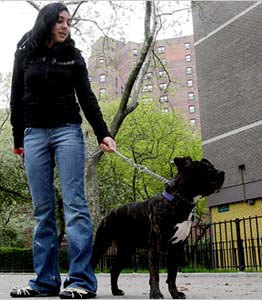 housing
apartments, as he has for years. But others of his kind are
not. housing
apartments, as he has for years. But others of his kind are
not.
Dobie is a miniature Doberman pinscher, all 10 pounds of him.
Margarita Rivera, 61, took Dobie on a walk Saturday morning
around the La Guardia Houses on the Lower East Side of Manhattan.
The day before, a new pet policy took effect for public housing
residents: full-breed or mixed-breed pit bulls, Rottweilers
and Doberman pinschers are banned, as are any dogs expected
to weigh more than 25 pounds when fully grown. The ban applies
to new pets only.
Tenants who currently own a pit bull, Rottweiler or Doberman
pinscher, or a dog that is more than 25 pounds, are allowed
to keep the pet as long as they had previously registered
it with the city’s public housing agency, the New York
City Housing Authority.
Ms. Rivera does not mind the ban. She registered Dobie, her
daughter’s dog, with the management about eight years
ago, and said the dog had never bitten any of her neighbors,
though such a bite would be relatively harmless, since Dobie
had most of his teeth removed when he was neutered. “I
think it’s great,” she said of the ban. “In
my building there’s a pit bull. He looks at Dobie like
he wants to eat him.”
The new policy has stirred passions among dog owners and others
at some of the city’s 340 public housing complexes.
Some residents say the ban is a kind of dog profiling that
unfairly singles out three entire breeds and treats owners
of those dogs as potential problem tenants. Others support
the ban, saying that other tenants fail to control big dogs
both inside and outside the buildings and encourage aggressive
behavior in their pets.
In numerous public housing developments where a gang culture
predominates, an aggressive dog can be a kind of status symbol,
particularly among youths who view their pet as a means of
protection or intimidation.
The three banned species are responsible for a number of vicious
attacks around the country and the New York region. Last month,
a 5-year-old Dutchess County boy was attacked by a pit bull
and required 1,000 stitches. Last year, a police officer shot
and killed a stray pit bull in the Bronx after it attacked
the officer and a pregnant woman selling newspapers. And in
June 1997 at a Brooklyn public housing complex, two pit bulls
mauled a 12-year-old girl, who survived the attack.
At the La Guardia Houses on Saturday, Lilliana Madonia, 17,
said Coco, a pit bull and German shepherd mix, looks more
intimidating than she really is. Coco is a service dog for
Ms. Madonia’s mother, who is in a wheelchair. “She’s
the most loving thing,” said Ms. Madonia, who was taking
Coco on her morning walk. “Sometimes she thinks she’s
a cat.” A man tried to walk by Ms. Madonia at about
that moment, and Coco barked. Then she led Ms. Madonia on
a chase — not after the man, but after a squirrel off
in the distance.
Ms. Madonia said the Housing Authority was unfairly taking
aim at pit bulls like Coco.
“They shouldn’t ban them,” she said. “Dogs
will be dogs. It depends on how they’re brought up and
trained.”
Howard Marder, a spokesman for the Housing Authority, said
in a statement that the policy was modified “to address
the concerns repeatedly raised by our residents and resident
leadership” and does not affect “those individuals
who have demonstrated responsible ownership of dogs and who
have registered their dogs.” Mr. Marder said the decision
to ban the three breeds was based on the agency’s research
and experience, as well as information gathered from other
public housing authorities around the country about their
pet policies. Relations between the agency and dogs have long
been difficult.
When the Harlem River Houses opened in 1937, dogs were barred
from the premises. By the 1960s, tenants in all public housing
complexes were prohibited from owning dogs or cats, except
guide dogs for the blind, because of concerns about cleanliness,
noise and the danger of dog bites. “It’s not that
we aren’t sympathetic,” Gerald J. Carey, the agency’s
general manager, told a reporter for The New York Times in
1964, after an effort to rescind the pet ban had failed in
Albany. “But we have to consider the safety and comfort
of the majority of our tenants, instead of the wishes of a
few.”
In 1994, managers responding to complaints about aggressive
dogs mailed notices to all tenants urging them to get rid
of their dogs, or risk losing the roof over their heads. Mayor
Rudolph W. Giuliani, the proud owner of Goalie, a yellow Labrador,
took exception, and the notices were withdrawn.
It was not until 1998 that Congress gave public housing residents
nationwide a federal right to own pets.
Since 2002, the Housing Authority has allowed tenants to have
either a cat or a dog as long the pet is registered with the
agency.
Photo:
Lilliana Madonia with Coco, a pit bull and German shepherd
mix, at the La Guardia Houses.
Credit: Hiroko Masuike for The New York Times
|

Pit bulls, Dobermans, Rottweilers banned from
public housing
BY Oren Yaniv and Lisa L. Colangelo
DAILY NEWS STAFF WRITERS
Wednesday,
April 29th 2009
Pit bulls are now Public Enemy No.1 at city housing projects.

Starting Friday, the powerful popular breed that's sometimes
trained to be violent is banned from all apartments run by
the city Housing Authority.
"Finally someone is realizing that these potentially
dangerous animals have no place in a confined urban space,"
said City Councilman Peter Vallone (D-Queens), who has unsuccessfully
lobbied state legislators to ban the dogs.
The Housing Authority regulations also bar residents from
owning any dog over 25 pounds. The current policy allows dogs
that weigh up to 40 pounds. In addition, owning Rottweilers
and Doberman pinschers also is banned under the new rules.
Housing Authority residents who already have the breeds will
be able to keep them as long as they register by Friday.
City housing officials said residents urged them to ban the
dogs that they claim are too vicious and threatening. But
dog lovers who have pit bulls and the other targeted pooches
are upset.
"He's my baby," Jose Hernandez, 32, who lives in
the Lillian Wald Houses on the lower East Side, said of his
6-year-old pit bull, Chopper. "These are not bad dogs."
"It all depends on how you teach a dog," said Anthony
Nieves, 37, as he walked his 1-year-old pit bull, Storm, near
his home at the Wald Houses. "My dog is like a puppy,"
Nieves said.
The ASPCA and other groups opposed to the ban have been working
with the city housing agency to ease some of the restrictions.
"We are opposed to breed-specific bans," said Michelle
Villagomez, ASPCA senior manager of advocacy and campaigns.
"And we find the weight restriction is too oppressive.
So many breeds are over 25 pounds. You can get an overweight
beagle that weighs more than 25 pounds."
Photo: Anthony
Nieves, 37, calls his pit bull, Storm, 'my baby' and pans
the New York City Housing Authority's rule banning large and
menacing dog breeds.
Credit: Theodorakis/News
|

Weird but True
LUKAS
ALPERT
April
25, 2009
It
was a coveted medal of canine honor.
A medal awarded legendary "Rip" -- who sniffed out dozens
of trapped victims of The Blitz during World War II -- sold at
a London auction for $35,700.
Rip saved 100 people buried alive in a bombed air-raid shelter.
|

New
pets-only airline aims to make the skies friendlier, comfier
for animal passengers
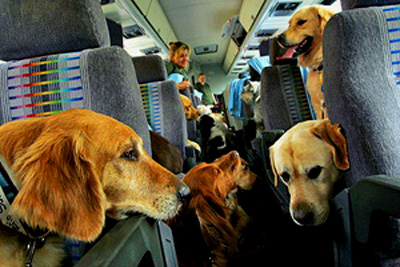 New
airline tries to make skies friendlier for furry travelers New
airline tries to make skies friendlier for furry travelers
By William Hageman | Tribune Reporter
April
23, 2009
Few
tasks are more stressful for a pet owner than having to pack
up little Spanky or Fluffy and put the furry family member
on a plane, knowing the animal is destined to spend the next
few hours in a cargo hold.
Dan Wiesel and Alysa Binder faced that a few years ago when
they and their Jack Russell terrier, Zoe, moved from San Francisco
to Florida. Zoe survived the experience -- she's 17 and going
strong -- but it got Wiesel and Binder thinking.
The
result: Pet
Airways, an airline designed just for pets.
It launches July 14, with flights to and from five cities
(Chicago included), all at an introductory fee of $149 each
way. Beechwood aircraft have been remodeled to hold 50 pet
carriers each, and the animals will fly in relative comfort.
Chicago flights will use Chicago Executive Airport (formerly
Palwaukee Municipal) in Wheeling.
"If you own a pet, you get it," Binder says. "They're
in the main cabin, not cargo. There is always an  attendant
with them. ... There's fresh circulated air, like any passenger
would have. It's well-lit. It's a whole different service
than cargo." attendant
with them. ... There's fresh circulated air, like any passenger
would have. It's well-lit. It's a whole different service
than cargo."
Pet Airways -- at petairways.com
-- even provides pet carriers.
Binder says the announcement of the launch has brought a flood
of reservations and even briefly crashed the company's server
earlier this week.
"And we're flying at night, when skies are calmer and
the animals are calmer," she says. "Everything we're
doing, we're doing around the pets."
Click
√
 to watch commercial
to watch commercial
|

Giving
up pets:
Animals' fortunes fall in tough economy
More owners blame finances for giving up animals
to shelters
By Sara Olkon
Tribune reporter
April
21 2009
When people showed up to give away their dogs and cats at
a local shelter last year,
the main reasons they cited were "no time" and accidental
pet pregnancies. This
year, the No. 1 reason is a lot simpler: no money.

Bruiser,
whose owner put in foster care at PAWS Chicago,
waits to be placed with a temporary family.
Photo: Charles Cherney/Chicago Tribune
Click
√on
image for full article
|

Trustees
Begin to Parcel Leona Helmsley’s Estate
By SAM ROBERTS
April
22, 2009
The first $136 million from the hotelier Leona Helmsley’s
disputed multibillion-dollar estate has been  distributed,
trustees announced on Tuesday, but the bulk went to
medical centers instead of dogs. distributed,
trustees announced on Tuesday, but the bulk went to
medical centers instead of dogs.
Only $1 million of the estate, valued at about $5 billion,
was donated to the care of dogs, which Mrs. Helmsley
had designated as her primary beneficiary.
“This is a trifling
and embarrassingly small amount,”
said Wayne Pacelle, president of the Humane Society
of the United States. “Mrs.
Helmsley’s wishes are clearly being subverted.”
After Mrs. Helmsley’s death in 2007, it was revealed
that she had drafted a mission statement four years
earlier listing two specific priorities for the distribution
of her estate. The first was helping the poor, which
she struck from the document a year later. The second
was to provide for the care of dogs, although she added
“and such other charitable activities as the trustees
shall determine.”
In February, a Manhattan judge ruled that the trustees
had sole discretion in disbursing her assets and that
the entire estate did not have to go to the dogs.
Mrs. Helmsley, whose husband Harry was a real estate
magnate, also left $12 million to her own Maltese, Trouble.
The disclosure that Trouble (above
left) was the largest named beneficiary
in the will prompted death threats against the dog.
Another judge reduced Trouble’s trust fund to
$2 million; the dog’s security costs the estate
$100,000 a year. (The judge also negotiated a $6 million
settlement with two of Mrs. Helmsley’s grandchildren
who were explicitly left out of her will.)
The grants on Tuesday represented a fraction of the
estate.
Mr. Pacelle of the Humane Society said, “We
are extremely disappointed that less than 1 percent
of the allocation announced is going to animal-related
organizations, and only one-tenth of 1 percent is going
to animal welfare organizations." "We
are in touch,” he continued, “with the interested
parties and are hoping to have a satisfactory resolution
— a much larger percentage than 1 percent.”
The biggest beneficiary was a digestive diseases center
at New York-Presbyterian/Weill Cornell Medical Center,
which received $40 million. Mount Sinai Medical Center
received $25 million to create a Helmsley Center to
study the electrical properties of cells and tissues
and $10 million for a Helmsley Inflammatory Bowel Disease
Center.
The $1 million for animal rights and welfare was divided
equally among 10 charities, including the A.S.P.C.A.
and Guide Dogs for the Blind.
An additional 43 grants were distributed to educational,
conservation and anti-poverty programs.
Among about $15 million to health care groups in South
Dakota was $3.5 million for Abbott House Foundation,
which runs a center for victims of sex abuse. The Juvenile
Diabetes Research Foundation received $2.5 million,
and $2 million was given to endow a scholarship at the
Cornell University School of Hotel Administration. The
National Geographic Society received $750,000, and City
Harvest, Citymeals-on-Wheels, Common Ground, the Doe
Fund and South Brooklyn Legal Services each received
$200,000.
The trustees of the Leona M. and Harry B. Helmsley Charitable
Trust are Mrs. Helmsley’s brother, Alvin Rosenthal;
two of her grandsons, Walter and David Panzirer; one
of her lawyers, Sandor Frankel; and her friend John
Codey.
The trustees, in a prepared statement, said, “Throughout
their lives, the Helmsleys were committed to helping
others, through the innovations of medical research.”
They did not address the controversy over dogs.
 SCOOP & HOWL - Comment
SCOOP & HOWL - Comment
Shame
on the trustees for the Leona M. and Harry B. Helmsley
Charitable Trust in not following Mrs. Helmsley’s
wishes!
Why not $1 million each (or 2 or 3) to the ten designated
animal rights charities leaving $126 million still available
for other charities? Do not Guide Dogs benefit humanity
as well? Would a more equitable partition of her estate
in this manner not better serve Leona Helmsley’s
last will and testament more closely?
|
MORE
ON TROUBLE'$ TROUBLE$

HOWL OVER LEONA WILL
DOGS GET THROWN A MERE $1M BONE
LEONARD GREENE
April
22, 2009
Who cut the dogs out?
Trustees for Leona Helmsley's estate yesterday said
they are giving $136 million of the Queen of  Mean's
money to charity -- with only $1 million going to
the canine causes she so loved. Helmsley, 87, who
died in 2007, left barking orders in her will that
funds from the Leona M. and Harry B. Helmsley Charitable
Trust would be used for "purposes related to
the provision of care for dogs." Mean's
money to charity -- with only $1 million going to
the canine causes she so loved. Helmsley, 87, who
died in 2007, left barking orders in her will that
funds from the Leona M. and Harry B. Helmsley Charitable
Trust would be used for "purposes related to
the provision of care for dogs."
That wording of the mission statement, filed in 2004,
ignited a court battle over whether the money could
be used to help beings with fewer than four legs.
Dog lovers were wagging their tails in delight until
February when a judge ruled that the trustees had
sole authority to decide which charities could benefit
from her multibillion-dollar fortune.
The trustees -- Helmsley's brother, two grandchildren,
a close friend and a lawyer -- had been concerned
the directive might keep their charitable giving on
too tight a leash. Helmsley's estate announced its
first round of charitable grants, including a $40
million gift to New York-Presbyterian Hospital/Weill
Cornell Medical Center. The majority goes to New York
City hospitals and other health-care systems across
the country.
Animal-rights groups,
meanwhile, got only a small bite of fortune -- a kibble-sized
$1 million, including $100,000 to the ASPCA.
Wayne Pacelle, chief executive of the Humane Society
of the United States, said the amount of donations
to animal charities -- ranging from the animal-cruelty-prevention
society to groups such as Canine Partners for Life
-- doesn't reflect Helmsley's wishes. "Giving
less than 1 percent of the allocation to dog-related
organizations is a trifling amount and not consistent
with Leona Helmsley's expressed intention," Pacelle
said. "We've been in touch with interested parties
and hope for a constructive resolution."
Critics, the trustees said, are barking up the wrong
tree.
"We are continuing the philanthropic legacy of
Mr. and Mrs. Helmsley," the trustees said in
a statement. "Throughout their lives, the Helmsleys
were committed to helping others, through the innovations
of medical research, responding to those in need during
critical times, and in other areas. We now have the
privilege of continuing their good works by providing
support where it will make a difference."
A spokeswoman for the trust did not
return a call seeking comment as to why the animal-groups
took such a big hit.
Helmsley's fortune after her death had been estimated
at $5 billion to $8 billion. The luxury-hotel queen
callously left $12 million in her will to her tiny
Maltese, Trouble, while freezing out two of her grandchildren.
She directed that when the dog died it would be buried
next to her and her husband. State law bars animals
from being buried in human cemeteries.
With
Post Wire Services
|

Leona Helmsley estate divided for charity,
including
$1M for dogs
BY AMY WESTFELDT Associated Press
April
21, 2009
NEW YORK — Trustees of real estate baroness
Leona Helmsley’s estate say they’re giving
$136  million
to charity — with just $1 million going to the
dogs. million
to charity — with just $1 million going to the
dogs.
Helmsley’s estate announced 53 charitable grants
Tuesday, the bulk of which went to New York City hospitals
and medical research. The largest grant, $40 million,
went to a digestive diseases center at New York-Presbyterian/Weill
Cornell Medical Center, while $35 million went to
start two research facilities in Helmsley’s
name at Mount Sinai Medical Center.
The estate for Helmsley — who died in 2007 at
age 87 — divided $1 million equally to 10 animal
rights charities, including the American Society for
the Prevention of Cruelty to Animals and several groups
that train guide dogs for the blind.
Animal rights groups rejoiced last year at public
reports that Helmsley specified in her will that her
multibillion-dollar hotel and real estate empire should
go entirely to dog-releated charities. The hotel queen’s
will had named her dog, Trouble (pictured
above left with Mrs. Helmsley), as a beneficiary.
But a surrogate court judge ruled in February that
trustees for the Leona M. and Harry B. Helmsley Charitable
Trust had sole authority to decide which charities
benefit from her estate.
“Throughout their lives, the Helmsleys were
committed to helping others through the innovations
of medical research of responding to those in need
during critical times and in other areas,” the
trustees said in a statement Tuesday. “We now
have the privilege of continuing their good works
by providing support where it will make a difference.”
The grants include $25 million to create a Helmsley
Center for Electrophysiology — the study of
electrical properties of cells and tissues —
at Mount Sinai, and $10 million for the Helmsley Inflammatory
Bowel Disease Center. More than $15 million was donated
to health care systems in South Dakota, including
advanced cancer treatment funding at a Mitchell, S.D.,
hospital and hospital pharmacy funding in Sioux Falls,
S.D. The foundation gave several $200,000 donations
to city homeless and poverty programs such as Citymeals-on-Wheels
and Bowery Mission.
Helmsley’s fortune, with much of the holdings
in real estate, had been estimated at $5 billion to
$8 billion after her death.
|
So...,
what are wills for? |

Weird but True
Post
Wire Services
April
20, 2009
A
missing pooch has been found two weeks after surviving the car
accident that killed his owner -- thanks to photos left at the
crash scene.
Neo, a Siberian Husky, was discovered in Snowville, Utah, wearing
a heart-shaped name tag. Searchers were able to identify him
because he was wearing the same tags in photos found in the
wreckage of his tragic owner's car. |

MEET THE BARKERS
NYC'S NUMBER 1 NOISE OFFENDERS
By JAMES FANELLI and SARAH RYLEY
April
19, 2009
Meet the worst dogs in New York: a Jack Russell terrier named
Cavo and his three Pomeranian  cohorts,
Hunter, Peanut and Casey. To their Upper East Side owner,
they are man's best friends, precious pooches who can do no
wrong. To their neighbors, they are the hounds of hell whose
barks drive people bonkers. cohorts,
Hunter, Peanut and Casey. To their Upper East Side owner,
they are man's best friends, precious pooches who can do no
wrong. To their neighbors, they are the hounds of hell whose
barks drive people bonkers.
The clamorous canines make so much noise in their back yard
that their owner, Rob Ryder, according to his account, has
become the most-penalized pet owner under the city's updated
noise code. Neighbors complained so much that a city inspector
slapped Ryder with a $70 violation in March 2008. He said
that he has been fined two more times and that a judge has
threatened to take away his four fidos if he gets one more.
"In the spring and the summer, there are people who stick
their heads out the window screaming at them, 'Shut your dogs
up!' " said Alan Yesner, a financial analyst and a neighbor
of the four furballs. "You're never free of these yapping
dogs."
The tail-wagging tormenters live with Ryder and his family
in the first two floors of a posh four-story brownstone on
East 72nd Street. Ryder lets them out in the brownstone's
back yard starting at 7 a.m. or earlier each day, according
to neighbors.
That
is when a "chorus of dogs erupts," said Yesner,
who lives in an apartment building that abuts the yard. He
and other residents in his building have lodged complaints
through the city's 311 hot line, have written letters to Ryder
and have even spoken to Ryder's wife. But despite the complaints
and fines, the unapologetic dog owner just shrugs it off.
"Give me a break! Everybody in this city owns dogs,"
Ryder, 38, told The Post as his dogs barked continuously.
"This is Manhattan. Move to Minnesota if you want quietness."
Loud pets became a punishable violation in July 2007. Under
the city's updated noise code, animals are not allowed to
make unreasonable noise for 10 minutes or longer between 7
a.m. and 10 p.m. The time shortens to five minutes between
10 p.m. and 7 a.m.
Since the rule was instated, 13,557 dog-noise complaints have
been lodged through 311, and 236 complaints have been filed
for other loud pets, the Department of Environmental Protection
says. City records show 71 violations -- 18 in Manhattan alone
-- have been handed out to owners of loud animals for a total
of $7,650 in fines. According to the DEP, pet owners are given
warnings and chances to correct the problem before fines are
issued. Fines have ranged from $70 to $525.
Photo:
RUFF & TOUGH: Rob Ryder, who owns three Pomeranians and
a terrier, says neighbors annoyed by the dogs' barks should
"move to Minnesota" if they want quiet.
 SCOOP & HOWL - Letter
to the Editors of The
NYPost
SCOOP & HOWL - Letter
to the Editors of The
NYPost
Re MEET THE BARKERS,
April 19, 2009
Our problem
was the co-op board (an oxymoron, if there ever was one, for
that private fiefdom so often populated by know-nothings,
do-nothings and be-nothings who can’t seem to aspire
to anything higher than minding other people’s business)
in Manhattan, where we lived.
Our solution
was the opposite to what Rob Ryder recommends:
we bought our Dogs (two Schnauzers and a Beagle) a house in
an acre of wooded land in “the upper elevations of the
Hudson Valley, north and west of the City”. We dubbed
it The DOGHOUSE.
What started as a weekend escape from the abuses and harassment
of the co-op board soon became home. The weekends just got
longer, then permanent.
We also found a practical solution
to the barking problem: citronella
bark collars, which you can get online from
websites such as petguys.com and petedge.com for about $75,
at NYC pet supply stores for around $125. Spread the word.
I’m at that place in the woods. Everything I need is
here with me: wife, dogs, studio and, once I hit “Send”,
it's back to Bach, Brahms, Beethoven, Britten, Borodin, Bruckner,
Bruch, Berlioz, Bizet, Bernstein, Bellini, Boccherini; Bob,
Beer, Bourbon and Book. No boobtube. No babies, no brats.
No bosses, no busybodies, no bark collars, no bunglers, no
boards; no burglars, no bums. Other than bugs, beavers and
bears, NO PESTS. My Dogs are Dogs and I paint Dogs.
What more could I want?
ST. BERNARD DE CLAIRVAUX: “Who loves me loves my Dog.”
May the Dogs be with you!
ROBERT COANE
Scoop & Howl
From-The-DOGHOUSE.com
|

The
Bo Peep Show
By Sheryl Gay Stolberg
April
15, 2009
He may be the leader of the free world, but he still has to
walk the dog.
“We all have to take turns walking the dog,’’
President Obama declared Tuesday, as Bo Obama , the  newest
– and only four-legged — occupant of the White
House, made his much-anticipated Washington debut. Then again,
the president had his two young daughters with him. What else
could any self-respecting father and new dog owner say? “We’re
trying to be responsible dog owners,’’ he later
confessed. newest
– and only four-legged — occupant of the White
House, made his much-anticipated Washington debut. Then again,
the president had his two young daughters with him. What else
could any self-respecting father and new dog owner say? “We’re
trying to be responsible dog owners,’’ he later
confessed.
In this city of jaded journalists, about 100 members of the
Fourth Estate turned out to watch the Obamas — President
Barack, First Lady Michelle and First Daughters Malia and
Sasha – scamper around the South Lawn with Bo and entertain
dog-related questions.
This we now know as a result:
Bo has not yet had any accidents in the presidential mansion.
“We’re trying to keep her from having accidents,’’
Mrs. Obama said, mistakenly using the female pronoun even
though Bo is a boy. (No offense intended, Bo, but with your
curly black hair, white front paws and carefully-groomed tail,
you do kind of look like a girl.)
Bo, a gift to the Obamas from Senator Edward M. Kennedy Jr.,
is a Portuguese Water Dog . The president allowed that Porties,
as they are called, like to eat tomatoes.
“Michelle’s garden is in danger,’’
Mr. Obama declared. Not to worry, Mrs. Obama said –
the garden doesn’t have any tomatoes.
Here, Sasha Obama, 7, weighed in, changing the subject. “He
doesn’t know how to swim!’’ she exclaimed.
(Water dog or not, Bo will apparently require swimming lessons.)
Bo joins a long line of presidential pooches , the most recent
being Barney, President George W. Bush’s dog, who once
bit a reporter. (For the record, some say Barney was provoked.)
Barney was allowed in the Oval Office. Will Bo have similar
privileges?
“Of course,’’ Mr. Obama replied. Will he
sleep in a bed? “Not in my bed,’’ the president
said.
Photo:
Doug Mils/The New York Times
|

"When
a shepherd goes to kill a Wolf, and
takes his Dog along to see the sport,
he should take care to avoid mistakes. The Dog
has certain relationships to the Wolf
the shepherd may have forgotten.”
ROBERT M. PIRSIG
American
writer and philosopher
(b.1928)

Editorial
Observer
Science,
Mythology, Hatred, and the Fate of the Gray Wolf
By VERLYN KLINKENBORG
April
13, 2009
For the past few weeks, I’ve been trying to find a way
to accept the decision by Ken Salazar, the new  secretary
of the interior, to remove the gray wolf from the endangered
species list in Idaho and Montana. secretary
of the interior, to remove the gray wolf from the endangered
species list in Idaho and Montana.
It was a relief to have a sensible conversation with newly
appointed interior officials after eight years of hearing
almost nothing but distortion and duplicity from the top figures
in the department. It was also a relief to hear them say,
in describing the way they reached this decision, that they
were simply following the guidance of career scientists. And
yet I still can’t accept it.
The reintroduction of wolves in the Rocky Mountain West has
been an overwhelming success. It began with 65 wolves in 1995
and 1996, and the population has now reached approximately
1,600 across the region, with about a hundred breeding pairs.
The numerical standards of the original recovery plan have
been more than met, and there is new evidence, according to
Interior Department scientists, that enough intermingling
is taking place among separate populations to ensure a healthy
genetic diversity.
Unfortunately, very little has been done to change the behavior
of humans — who drove wolves to the brink of extinction.
The
way the wolf has been delisted, this time, is a reminder that
what we are really doing when we protect endangered and threatened
species is managing our own species.
Under
the proposed delisting for Idaho and Montana (wolves in Wyoming
will remain on the endangered list), the wolf will be protected
by state management plans that more or less acknowledge the
wolf’s right to exist.
C. L. Otter, the Republican governor of Idaho, has pledged
“to continue our policy of responsibly managing wolves
for a viable, sustainable population that can coexist with
our ungulate herds, our livestock and our people.” The
very first step in “responsibly managing” wolves
will be a wolf hunt. And Mr. Otter’s idea of coexistence
between wolves and humans doesn’t bear examination.
He has said he’d be the first in line for a wolf hunting
license, and he has also said he favors reducing the wolf
population in Idaho to 100, way below the current level of
more than 800 and well below the number required by the state
management plan.
When it comes to wolves, federal law has been protecting what
is, fundamentally, a mythic species. And when it ceases protecting
them, they will be exposed to the worst aspects of that myth
— a deep, ancestral hostility to wolves based on ...
nothing.
Wolves do not kill humans. They are responsible for a minuscule
number of livestock deaths in the West — less than domestic
dogs — and there are federal and state programs specifically
designed to compensate ranchers who lose stock to wolves.
To
hunters, killing wolves is both an end in itself and a way
of reducing their predation on elk and deer. And it is more
than that. Killing a wolf is also a way of participating in
the myth of the West. That myth nearly drove the species to
extinction.
I
would be happy to see wolves taken off the endangered species
list if they were not hunted. It is that simple. Their reintroduction
has been an unequivocal boon for the ecosystem — the
return of a top predator to a system that is biologically
unbalanced without it. There is more than enough game for
wolves and humans to share. There are adequate protections
for ranchers. There is every good reason to try genuine coexistence.
No
one shoots a wolf to keep from going hungry.
So
far the political pressure in the West is too great to allow
this. And that, in the end, is the trouble with Mr. Salazar’s
decision. It may indeed have been based on the science, and
on the numbers called for in the recovery plan. But that plan
surely needs revaluation, and in any case the administration
clearly was not eager to defend it. The announcement was made
on a Friday (like so many Bush-era decisions) and without
much warning to environmental groups. Several of those groups
have now filed suit to block that delisting.
Mr. Salazar — a Coloradan and a rancher — now
faces the very difficult task of making certain that Idaho
and Montana adhere to the letter of their management plans.
As
for the wolves, they have been brought back only to be killed
again.
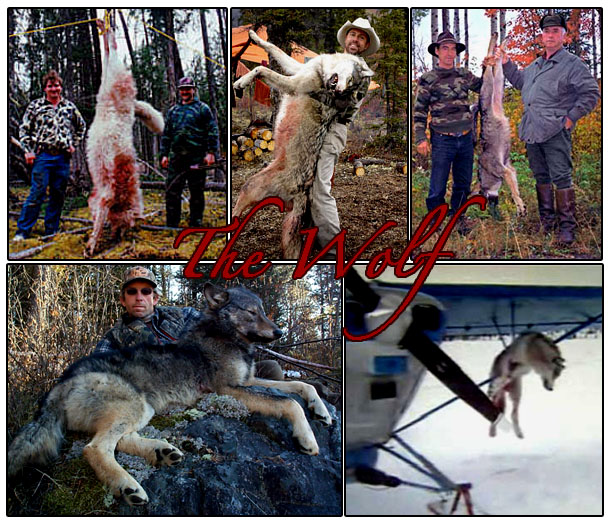
Its Closest
Relatives
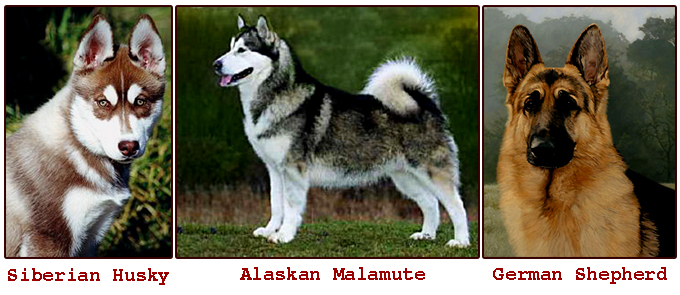
|

A victory for canine victims of violence
By Sandy Miller
April
13, 2009
Their loyal nature, their eagerness to please, are the very
qualities that make pit bulls easy prey for dog 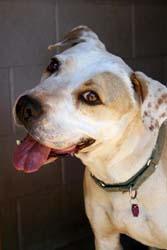 fighters.
And now, Best Friends Animal Society and other animal welfare
groups have joined forces to help future canine victims of
this organized crime. fighters.
And now, Best Friends Animal Society and other animal welfare
groups have joined forces to help future canine victims of
this organized crime.
On April 8, representatives from Best Friends, Bad Rap, ASPCA,
National Animal Control Association, Maddie’s Fund,
Nevada Humane Society, Spartanburg Humane Society and the
Humane Society of the United States met in Las Vegas to address
the matter of dogs seized as a result of cruelty investigations
into animal fighting rings. The meeting was in response to
concerns expressed by Best Friends last December regarding
HSUS’ policies related to animals confiscated in dog
fighting busts. The meeting was in the planning stages before
Superior Court Judge Ed Wilson Jr. ruled that 145 pit bulls,
including approximately 70 puppies, confiscated from Wildside
Kennels in Wilkes County, North Carolina, would be euthanized
without evaluation to determine suitability for placement.
Some very positive news came out of that meeting room in Las
Vegas. The HSUS now has a new policy that recommends that
all dogs be professionally evaluated, according to agreed
upon standards, to determine whether they are suitable candidates
for adoption. The new policy states that dogs deemed suitable
for placement should be offered as appropriate to adopters
or to approved rescue organizations. The HSUS plans to update
its law enforcement training manual and other materials to
reflect the change in policy.
Now, the future victims of dog fighting will get a second
chance at life.
“Last year, these dogs would have been summarily killed,”
said Julie Castle, director of Best Friends Community Programs
and Services. “We had only one way to go with this policy,
as killing was the only option being recommended. We’re
very pleased, but recognize we have a lot of details to hammer
out.”
Donna Reynolds, executive director of the San Francisco-based
Bad Rap, said it took a lot of energy and many lives to get
to this historic moment in the breed’s history.
“The HSUS decision to support the groups that assist
the victims of cruelty raids is a long time coming,”
Reynolds said. “But the battle isn't over by any means.
We have a lot of work to do to create realistic, widely accepted
policies that will benefit the thousands of yearly victims,
and many challenges to having those protocols implemented.
The meeting in Las Vegas was a big first step, and the dogs
are counting on us to stay on course for the long haul.”
And stay the course is just what all the organizations, including
the HSUS, intend to do. They agreed to form a working group
to develop future protocols for cooperation in addressing
needs of dogs seized in raids, such as how to assist with
the housing of fighting dogs, how to conduct professional
evaluations and how to screen potential adopters.
“This is a very positive first step in addressing the
collective concerns related to dogs rescued from dog fighting/cruelty
cases,” said Best Friends founder Francis Battista.
Wayne Pacelle, president and chief executive officer of the
HSUS, agreed. “I have long felt that pit bulls are the
most victimized of dogs, and this new collaboration is another
piece of our effort to turn that around,” Pacelle said.
The groups agreed that all dogs should be treated as individuals,
and that they’re the true victims of the organized crime
of dog fighting.
Ed Fritz, a campaign specialist who heads up “Pit Bulls:
Saving America’s Dog,” one of four Best Friends
campaigns aimed at reaching the goal of No More Homeless Pets,
called the HSUS’ new policy and the recent collaboration
“a great step forward.”
“This change in policy removes a large obstacle to reforming
the image of these dogs, which in turn will save lives and
bring us closer to no more homeless pets,” Fritz said.
“It won’t happen overnight, but it is a significant
step.”
Photo
by Terrah Johnson
|
WELCOME,
BO[BAMA]!!!

Hey, Bo Puppy! Obamas Finally Choose
By R.M. Schneiderman
April
12, 2009
President Obama might have initially expressed interest in
selecting a mutt to serve as the nation’s first dog,
but when it came down to it, a puppy with Kennedy connections
reportedly got the nod. As reported in The Washington Post
on Sunday, the Portuguese water dog was a gift from Senator
Edward M. Kennedy, who owns two of the breed.
Mr. Obama’s
daughters reportedly named the puppy Bo:
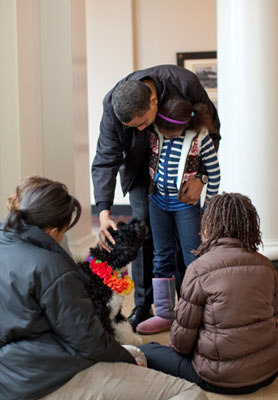 Malia
and Sasha chose the name, because their cousins have a cat
named Bo and because first lady Michelle Obama’s father
was nicknamed Diddley, a source said. (Get it? Bo …
Diddley?) Malia
and Sasha chose the name, because their cousins have a cat
named Bo and because first lady Michelle Obama’s father
was nicknamed Diddley, a source said. (Get it? Bo …
Diddley?)
The Post described the dog as “a handsome little guy”
with “tuxedo-black fur … a white chest, white
paws and a rakish white goatee.”
Senator Kennedy offered the 6-month-old canine to the Obama
girls after its previous family
could not take care of it, according to an article
in The Los Angeles Times .
As is the case with many secrets in Washington, the Obamas
were unable to conceal Bo’s identity until the official
announcement, which was scheduled for Tuesday. And now the
buzz on this seemingly slow news day is who first broke the
news about Bo.
A Web site called firstdogcharlie.com posted a picture of
a Portuguese water dog on Saturday morning, saying its original
name was Charlie, The Post wrote. TMZ.com linked to the picture,
and eventually The Post received its tip from an anonymous
source inside the White House. Soon thereafter, the blogosphere
was abuzz with clever (and not-so-clever ) plays on words.
Before
deciding to give the dog a home, the Obamas arranged a meeting
between Bo and the girls, The Post reported:
Bo charmed the first family, a source who was there said.
He sat when the girls sat, stood when the girls stood. He
made no toileting errors and did not gnaw on the furniture.
Bo has, after all, been receiving lessons in good behavior
from the Kennedys’ dog trainers. These lessons have
been taking place at a secret, undisclosed location outside
Washington.
Bo, though
he was raised elsewhere, already has a keen sense of who’s
in charge inside the Beltway. 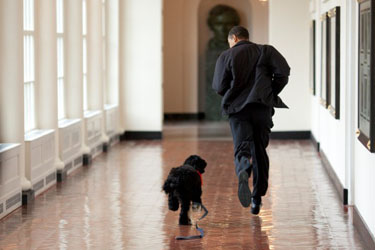 When
the president walked across the room during the visit, Bo
followed obediently. When
the president walked across the room during the visit, Bo
followed obediently.
In November, Mr. Obama announced that he and his wife, Michelle
, would purchase a puppy for their daughters.
In January, the president said that he had narrowed his choices
down to a Portuguese water dog and a Labradoodle, in part
because Malia is allergic to dogs. Portuguese water dogs,
or porties, as they are often called, “are considered
to be hypoallergenic because they are single-coated,”
according to the Web site of The Portuguese Water Dog Club
of America : “Hypoallergenic dog breeds (single-coated
or hairless) will still produce allergens, but because of
their coat type will typically produce less than others.”
An
earlier version of this post erroneously said the puppy was
previously owned by Senator Edward M. Kennedy. The Portuguese
water dog was a gift from the Massachusetts Democrat, who
owns two of the breed, though he did not own Bo.
Photos:
Pete Souza/The White House, via Reuters
|

One
Obama Search Ends With a Puppy Named Bo[bama]
By HELENE COOPER
April
12, 2009
In
spite of its title, what is this article about, Dog
or God
?
Click
√
 to find out
to find out
|
 LEASH
TUG OF LOVE 'TINKLE' SHOCKER
LEASH
TUG OF LOVE 'TINKLE' SHOCKER
By WILLIAM J. GORTA
April
10, 2009
The Queens woman who claims a dog-sitter stole her Yorkie is
an absentee owner who barely housetrained the 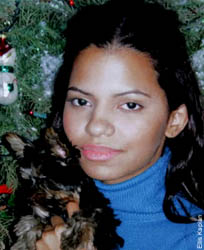 pet
-- and recommended swatting the tiny terrier when he tinkled
inside, according to court documents. pet
-- and recommended swatting the tiny terrier when he tinkled
inside, according to court documents.
Poor little Panda the pooch was so terrified of getting whacked
for whizzing, he took to hiding underneath the bed every time
he had an accident, dog-sitter Leandro Rohde claims in an affidavit
filed in Queens Supreme Court.
Panda arrived at Rohde's tony home on East 86th Street near
Fifth Avenue in January with his coat full of knots and missing
crucial vaccinations, Rohde claimed. Panda missed a time-critical
rabies vaccination, says Rohde, who provided a copy of a $680
veterinarian's bill. In addition to those bills, Rohde bought
Panda health insurance and registered it with the city, said
Rohde's lawyer, Michael Posner.
"If he's trying to say I abused the dog, he's thoroughly
wrong," alleged owner Ravely Arias said yesterday.
Last month, Arias asked a judge to order Rohde to give Panda
back. Arias said Rohde agreed to shelter the dog until her workload
decreased.
Rohde said Arias gave Panda to him permanently because the pooch
interfered with her social life, and her newfound ardor is spurred
only by her reunion with the boyfriend who bought her the dog. |

Manhattan
Man Arrested for Beating Dog and Girlfriend
April
10, 2009
Early last week, ASPCA Humane Law Enforcement Special Agent
Debbie Koch arrested Manhattan 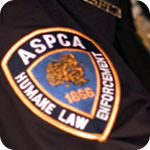 resident
Richard Smith, 24, on multiple charges related to domestic
abuse. Smith allegedly assaulted his 21-year-old girlfriend
and severely beat a two-year-old Shiba Inu belonging to the
girlfriend’s sister. Multiple attacks on the dog allegedly
occurred in the last few months. resident
Richard Smith, 24, on multiple charges related to domestic
abuse. Smith allegedly assaulted his 21-year-old girlfriend
and severely beat a two-year-old Shiba Inu belonging to the
girlfriend’s sister. Multiple attacks on the dog allegedly
occurred in the last few months.
“As we have seen in the past, the brutality associated
with domestic violence all too often affects other members
of the household, including pets,” says Joe Pentangelo,
Assistant Director, ASPCA Humane Law Enforcement.
The dog, named Michigan, was brought to the ASPCA’s
Bergh Memorial Animal Hospital (BMAH) on March 25 in a state
of distress. ASPCA veterinarians discovered that she had sustained
12 fractured ribs and suffered from trauma. Michigan is currently
recovering at BMAH and will be reunited with her owner.
Smith was charged with one count of aggravated animal cruelty
and assault. If convicted, he faces up to two years in jail
and a $2,000 fine.
If you know of an animal who is being hurt, please report
it—those who assault animals often abuse the people
in their lives, too. To report animal cruelty in New York
City, contact the ASPCA’s anonymous tip line at (877)
THE-ASPCA. Visit our Report Cruelty FAQ to learn how to report
cruelty elsewhere.
Click
√
on ASPCA Badge for Report
Cruelty FAQ
|

Seder Fare for Pets That Keep Kosher
By ANDREW ADAM NEWMAN
April
9, 2009
WHEN Robert Uri Heller, a psychologist and professor at the
Adler School of Professional Psychology, 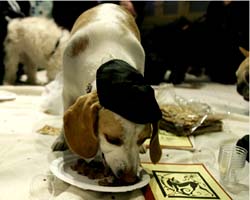 leads
a Passover Seder in Chicago on Saturday, some of the rituals
symbolizing Jews’ exodus from Egypt may be lost on the
yarmulke-wearing guests. Those guests will, after all, be
dogs. leads
a Passover Seder in Chicago on Saturday, some of the rituals
symbolizing Jews’ exodus from Egypt may be lost on the
yarmulke-wearing guests. Those guests will, after all, be
dogs.
The Seder, which will be conducted at a pet store, Wigglyville,
is being sponsored by Evanger’s Dog and Cat Food Company
to promote its kosher varieties, which have been endorsed
by the Chicago Rabbinical Council.
Dr. Heller, who keeps kosher and feeds Evanger’s to
Lilly, his wheaten terrier, has led Seders for dogs at pet
stores in the past, “much to the chagrin” of many
at his synagogue, he says.
“They say, ‘How could you do it for dogs, isn’t
it sacrilegious?’ ” Dr. Heller said. “And
my answer is, ‘We’re having fun.’ ”
• • •
Alice
Lerman, who owns Barker & Meowsky, a Chicago pet store
billed as “a paw firm,” said that Evanger’s
is also favored by non-Jews “who perceive kosher as
being another group of checkpoints, so that the protein sources
are maybe better checked than for nonkosher food.”
But there is a certain kitsch factor, too.
Ms. Lerman, who grew up in an Orthodox home and keeps kosher
still, does a brisk business in quadruped Judaica in her store.
She sells yarmulkes and tallits (prayer shawls) for dogs as
well as plush toys by a company called Chewish Pets, including
a bagel and a fish embroidered with the word “lox.”
The store supplies such items, and Evanger’s food, to
increasingly popular Bark Mitzvahs, a cheeky canine rite of
passage where, as documented in videos of the celebrations
posted on YouTube , some guests utter a congratulatory “Muzzle
Tov.”
Click
√
on NYTimes
logo for full article
Photo:
Joshua Lott/Chicago Tribune
Ella, a year-old beagle, savored a kosher dog food dinner
at a Passover Seder for dogs in 2005 at Soggy Paws, a dog
wash in Chicago. Kosher pet food sales rise in the week before
the holiday.
|
 DOGGONE
SHAME
DOGGONE
SHAME
DEAF GAL'S BELOVED YORKIE STOLEN
By JOE MOLLICA
April
8, 2009
They stole her late grandmother's diamond wedding ring, but
that wasn't the most precious item burglars took from  a
deaf woman in Queens. They pinched her best friend -- her dog,
Pinky (left). a
deaf woman in Queens. They pinched her best friend -- her dog,
Pinky (left).
"Please bring her back," 20-year-old Desiré
Tangert pleaded yesterday. "I love her and miss her."
The teacup Yorkie has been missing since March 19.
That's when Tangert's dad, Henry, received a call from his brother
saying thieves had broken into their Ozone Park home. Henry
rushed home from his construction job to find his back door
kicked in.
"The whole place was dumped over, top to bottom. They got
everything," he said, including computers, a special TV
for the deaf, and the diamond ring his mother, who died last
year, had given to Desiré. The ring had belonged to the
girl's great grandmother before that. "It could have been
100 years old. It was an antique that had been passed down for
generations," Henry said.
In all, the thieves got away with approximately $25,000 worth
of goods -- and Pinky, the adorable 1-year-old who Desiré
had taught to respond to sign language.
"When Desiré found out, she broke right down. She
crumbled," the dad said.
Communicating with a Post reporter through handwritten notes,
aspiring pastry chef Desiré said, "It feels painful.
I'm heartbroken. Why would somebody steal my dog? We had a very
special relationship. I feel like she's my daughter. She acts
like such a human. She would always sleep with me. Wherever
I was she would follow me. She was loving and playful and friendly
and smart."
The dog also "seemed to know I was deaf," and quickly
learned Desiré's signing. "I taught her all kinds
of things. I taught her how to sit down and stand up give kisses,
high-five and even how to separate colors. She was a very smart
and special dog," Desiré said.
The family plastered their neighborhood with hundreds of fliers
offering up a $1,000, no-questions-asked reward for the dog
soon after the theft, but to no avail.
"I'm very angry at whoever stole my dog. I want them to
bring Pinky home. Please bring her back," she said. |

A TINY PUP IN A CUP!
Rita Delfiner
April
7, 2009
An itsy-bitsy British pup who is only one-third the size of
a guinea pig may have a chance to collar the  title
of world's smallest dog. title
of world's smallest dog.
The 2-week-old Chihuahua-Jack Russell mix named Tom Thumb
can sit in a teacup, weighs about 3 ounces and is less than
4 inches from the tip of his nose to the end of his tail,
according to London's Daily Mail.
Owner Archie Thomson is convinced Tom is not likely to grow
much more. "He's perfectly proportioned, but absolutely
miniscule," said Thomson, of West Dunbartonshire in Scotland.
"Judging by the size of his paws and head, I'd be surprised
if he grew much bigger than an inch or two more."
• • •
Weird
but True
By
ANDY GELLER
April
7, 2009
It's
a bad thing when a Dog turns up his nose at your paintings,
especially if it's a drug sniffing Dog.
A
man was taken into custody in Arizona after customs agents
found 90 pounds of pot hidden in the frames of six large paintings
in hsi vehicle.
Agents
picked t5he vehicle for a routine inspection at the border
crossing in Douglas, Arizona, and their Doog showed an immediate
interest in the paintings. An X-ray revealed pot in the frames.
|

Dog
overboard found four months later
Mon Apr 6,
2009
SYDNEY (AFP) – A pet dog that fell overboard in rough
seas off Australia has been reunited with its 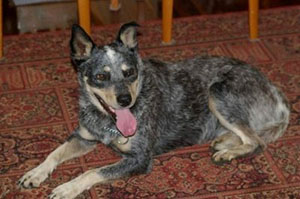 owners
after surviving alone on an island for four months, reports
said. owners
after surviving alone on an island for four months, reports
said.
Sophie Tucker , apparently named after a late US entertainer,
fell overboard as Jan Griffith and her family sailed through
choppy waters off the northeast Queensland coast in November.
The dog was believed to have drowned and Griffith said the
family was devastated.
But out of sight of the family, Sophie Tucker was swimming
doggedly and finally made it to St Bees Island, five nautical
miles away, and began the sort of life popularised by the
TV reality show "Survivor."
She was returned to her family last week when Griffith contacted
rangers who had captured a dog that had been living off feral
goats on the largely uninhabited island, in the faint hope
it might be their long-lost pet. When the Griffiths met the
rangers' boat bringing the dog to the mainland they found
that it was indeed Sophie Tucker on board. "We called
the dog and she started whimpering and banging the cage and
they let her out and she just about flattened us," Griffith
told the national AAP news agency. "She wriggled around
like a mad thing."
Griffith said that when the dog was first spotted on the island
she had been in poor condition. "And then all of a sudden
she started to look good and it was when the rangers had found
baby goat carcasses so she'd started eating baby goats,"
she said.
Sophie Tucker, a member of the Australian cattle dog breed
, had been quick to readjust to the comforts of home, complete
with airconditioning, Griffiths said.
"She surprised us all. She was a house dog and look what
she's done, she's swum over five nautical miles, she's managed
to live off the land all on her own," Griffiths said.
"We wish she could talk, we truly do."
Photo:
Cattle dog Sophie Tucker, a pet dog that fell overboard in
rough seas off Australia
AFP/Jan Griffith
|

Dispute
[over
a Dog urinating]
Led
to Shootings in Pittsburgh
April
6, 2009
 PITTSBURGH
(AP) — A 911 call that summoned two police officers
to a home where they were ambushed, and where a third was
later killed during a four-hour siege, was precipitated by
a fight between the gunman and his mother over a Dog urinating
in the house.... PITTSBURGH
(AP) — A 911 call that summoned two police officers
to a home where they were ambushed, and where a third was
later killed during a four-hour siege, was precipitated by
a fight between the gunman and his mother over a Dog urinating
in the house....
Click
√
on AP logo
for full article
Suspect
Richard Poplawski
|
 SCOOP
& HOWL QUOTE SCOOP
& HOWL QUOTE
"Being
nice to the staff is second only to being nice to Dogs as
a pinnacle of civilization."
~
A.A. GILL:
LARGER THAN LIFE IN LONDON - Did the Obama Magic Travel Well?

OP-ED
5 April 2009
Click
√
on NYTimes
logo for full article
Click
√
on Inkwell
& Quill
for Canine
Quotes
|

Dogs Do Look Like Owners
By Robert Roy Britt
03 April
2009
People can guess pretty successfully what breed of dog a person
might own just by looking at the owner,  a
new study finds. a
new study finds.
A group of 70 people who do not own dogs were asked to match
photos of 41 dog owners to three possible breeds — Labrador,
poodle or Staffordshire bull terrier. They matched the owners
to the dogs more than half the time. Yet given three choices,
they should have been right only about a third of the time.
"This suggests that certain breeds of dogs are associated
with particular kinds of people," said study leader Lance
Workman, a psychologist at Bath Spa University in the UK.
It's no secret that people are obsessed with pets. Two-thirds
of American households have at least one, and dogs are the
top choice (though by sheer numbers, fish win out). And dog
owners are particularly so, suggests a study in 2007 that
found when a pet goes missing, dog owners contact and visit
shelters much sooner than cat owners.
The analysis runs deep: Those who don't own dogs used stereotypes
to match the dogs to their owners, Workman figures. "These
stereotypes persisted into judgments of the dog owners' personalities:
non dog owners considered the owners of each breed to share
certain personality traits, such as level of conscientiousness
and emotional stability."
The real connection is only skin deep, however.
"But when we tested the dog owners' personalities, we
found no strong links between any particular personality trait
and choice of dog breed, so any shared qualities are only
skin deep," Workman said.
A similar phenomenon happens among couples. People tend to
be attracted to those who have personalities similar to their
own, according to a study done in 2006. And as time goes on,
similarities in appearance grow, explaining why some older
couples look alike.
The canine findings were presented yesterday at the British
Psychological Society Annual Conference in Brighton.
Photo:
Schnauzer Rodin, Robert Coane, Schnauzer Frida
Credit: C. F. Coane / From-The-DOGHOUSE.com
|
 Bolivia
Bans Military Use of Animals
Bolivia
Bans Military Use of Animals
April
2, 2009
After less than a month of PETA campaigning, the Bolivian minister
of defense went on that country's national television to announce
an historic ban on all animal abuse in military training exercises,
stating that the Bolivian government is issuing Resolution 217
to prohibit all acts of violence, exploitation, and mistreatment
that provokes the death of animals. Not only has Bolivia beaten
the U.S. military to the punch , this ban is also Bolivia's
first animal protection regulation ever.
This news comes as a direct result of PETA's and PETA Germany's
campaigns, which were launched after horrific video footage
was uncovered showing the Bolivian military's mutilation and
killing of dogs in combat-training exercises . More than 20,000
supporters joined in the effort, including a leading Bolivian
congresswoman, Ximena Flores Castro, who talked with PETA and
then met with the defense minister in order to get the resolution
on the books.
Resolution 217 puts an end to military training exercises in
which dogs were mercilessly stabbed to death as they screamed
in pain. Not one more animal—dog or otherwise—will
have to suffer such a miserable fate at the hands of the Bolivian
military. The resolution also includes sanctions for those who
violate the regulation. |

Pets Feel the Recession, Too
By Christine Haughney
April
2, 2009
It wasn’t long ago that one way the wealthy flashed
their fortunes was by decking their dogs in Burberry 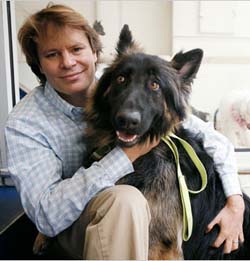 collars
and sending them for spa services. Now even the city’s
wealthiest dog owners have cut their budgets and sometimes
abandoned their dogs entirely. collars
and sending them for spa services. Now even the city’s
wealthiest dog owners have cut their budgets and sometimes
abandoned their dogs entirely.
John Ziegler, co-founder of the Manhattan doggie gym with
six locations called Biscuits and Bath , said he had never
seen so many dogs abandoned by owners who had just spent thousands
of dollars on them.
He pointed out Gracie, a Cavalier King Charles spaniel, whose
owner spent about $2,000 to buy her and $700 a month on unlimited
day care. When Gracie’s owner lost her Wall Street job
and returned to Chicago to live with her parents, she asked
the Biscuits and Bath staff to help Gracie find a home.
Fortunately, Gracie was adopted by the owners of the spaniel
she used to nap with.

Peanut
|
Now
Mr. Ziegler is seeking homes for a Chihuahua named
Peanut and a poodle named Coco whose owners have asked
for help adopting them since they can’t afford
them. A third dog, a terrier mix from Midtown, was
recently abandoned because her owner didn’t
want to spend about $500 on training to stop her barking.
Mr.
Ziegler calls these pups victims of
“greed and mismanagement of wealth.”
|

Coco
|
It’s
happening to dogs all over Manhattan. Jennifer Bristol, director
of operations at the private shelter Animal Haven downtown,
said that she was seeing more surrenders of pure-bred dogs
that typically cost owners more than $1,000. In one recent
week, she received a Pekingese, a Bulldog and a Shih-Tzu,
all by owners who “definitely had means,” she
said.
Wealthy pet owners who are holding onto their dogs are cutting
back. At the Sutton Dog Parlour , the owner, Marcia Habib,
has watched demand shrink by half for day care, grooming and
$15 bags of dog food. Owners also have started to stretch
out their dog’s grooming services to every eight weeks
from every four weeks, leaving the pets less catwalk-ready
for their Park Avenue strolls.
“They look ragged,” she said. But the owners apologize:
“I’m sorry my dog is a mess. But I don’t
have a job.’ ”
Photo
top left: John Ziegler, owner of the pet spa Biscuits and
Bath, with Bully, a 3-year-old German shepherd who found a
home with one of Mr. Ziegler’s employees.
Damon Winter/The New York Times
Photos of Peanut and Coco: John Ziegler
|

'HOP-ALONG' CASSIDY GETS LEG UP IN LIFE
BX. DOG'S LIMB A GIANT STEP FOR PROSTHETIC
SCIENCE
By RITA DELFINER
March
31, 2009
It gives one paws -- or, at least, paw.
Bronx pooch Cassidy had just three legs to stand on until
he got a fourth, thanks to a cutting-edge 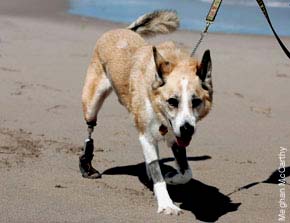 technique
that made him a walking miracle. technique
that made him a walking miracle.
The German-shepherd mix -- well, OK, mutt -- has become one
of the few animals in the world to receive a permanent prosthetic
limb, and is a trailblazer whose surgical experience could
help humans.
The dog, who lost his right rear leg below the knee joint,
had an "osseointegration" procedure in which a titanium
implant was attached to the tibia, a leg bone. A removable,
C-shaped foot made of titanium, carbon fiber and rubber screws
onto the prosthesis.
"The implant is permanent and goes into the bone like
a dental implant in humans, and then the bone and the implant
fuse," said Steve Posovsky, 61, a retired dentist from
Long Island who with his wife, Susan, adopted Cassidy in August
2005, when the dog faced euthanasia.
Posovsky was watching a morning news program that showed "this
dog that had been found in The Bronx with his leg cut off
wandering the streets who was about 21⁄2 years old.
"When I saw him on TV, I had to get him," said Posovsky,
who lives most of the year in Florida. "He was 30 pounds
underweight. He limped along. He had almost no hair,"
recalled Posovsky, who said that before his surgery, Cassidy
"would walk for 10 minutes and have to plop down and
need a rest. Now, he can walk for hours."
After taking in Cassidy, he and his wife contacted Dr. Denis
Marcellin-Little, a surgeon with the North Carolina State
University College of Veterinary Medicine in Raleigh and had
a removable prosthesis made. Cassidy "kicked off"
the leg, so they decided to go with a permanent one. Last
August, the permanent prosthesis was implanted, and last month,
the final version of the foot was perfected.
"What is being assessed and being designed for Cassidy
may improve our knowledge and may ultimately help in what
is being done for people," he said.
Meanwhile, Cassidy "is very happy," Posovsky said.
"He walks on the beach with me every day with his new
leg. When he's running I take his leg off. I'm a nervous father."
• • •
E.
SIDE DOG OF WAR
GAL & PAL IN YORKIE TUG-O'-LOVE
By WILLIAM J. GORTA and ERIN CALABRESE
March
31, 2009
An Upper East Side man set off a canine custody clash when
he refused to return a tiny terrier he was  watching
for a harried friend. The friend, Ravely Arias, of Douglaston,
Queens, claims in a lawsuit that Leandro Rohde fell in love
with her Yorkshire terrier and now refuses to give it back. watching
for a harried friend. The friend, Ravely Arias, of Douglaston,
Queens, claims in a lawsuit that Leandro Rohde fell in love
with her Yorkshire terrier and now refuses to give it back.
Arias said she had a taxing schedule as a community-outreach
worker and the hours left her unable to care for Panda, the
2-year-old Yorkie. So in January, she leaned on Rohde to look
after Panda until her hours became more manageable.
"I did it for the best [interest] of the dog at that
time, but then I realized that I missed him and that I never
should have given him up," Arias told The Post yesterday.
"He's adorable. I miss his face. He was a very loving
dog. I miss the companionship, especially living alone."
Arias recently got a new job with more reasonable hours and
went to retrieve her pet, only to find Rohde now claimed Panda
as his own, she said. Arias said Rohde told her, "You
gave him to me, and he's mine."
"It's my dog and I never said he was yours," Arias
recalled replying.
She said she understands Rohde's predicament. "The guy
fell in love with him, and I feel bad," Arias said yesterday.
"I was even thinking I could go to an animal shelter
and see if they have one like Panda that I could bring him."
Instead, she's bringing Rohde to Queens Supreme Court to force
him to return Panda, who has been living in the lap of luxury
on East 86th Street near Fifth Avenue. Arias, who is representing
herself, said in court papers that she needed to get back
her "only companion."
Rohde's only reason for keeping the dog is that he "has
taken a liking to the animal," the papers say. But Rhodes,
a director of marketing for New York Life, told The Post that
Arias gave him the dog because Panda was putting a crimp in
her social life. When she got back together with a boyfriend
who gave her the pup, she decided she wanted the dog back,
he claimed.
"The only thing she asked was that she could visit him
on Sundays," Rhodes said. "She never said it was
temporary. I'm not a dog hotel."
|

The family dog
Why we treat our pets like royalty
By Michael Schaffer
March
29, 2009
BACK
IN NOVEMBER 2007, Utah's Deseret News wrote up a five-year-old
Shih Tzu whose wardrobe included a pink mohair sweater and
a fur-trimmed parka. The same month, the Arizona Republic
reported on the growing popularity of puppy Tupperware parties.
And in South Carolina, the Greenville News highlighted an
increasingly common sight on local sidewalks: pet strollers.
Such conveyances might have proved popular at the six Dallas-area
malls that announced preholiday "pet nights," where
animals could sit for a picture with Santa.
Gilded-age indulgences that ended when recession officially
arrived a month later? Hardly. According to the American Pet
Products Association, the pet industry - which includes everything
from old-fashioned kibble to new-age veterinary acupuncture
- grew by $2 billion in 2008. For 2009, the association predicts
$45 billion in sales. Fifteen years ago, that number was $17
billion. "We're as recession-resistant as any industry
I can think of," declares Bob Vetere, the association's
president.
A century ago, the pioneering economist Thorstein Veblen lampooned
the house pet as the ultimate emblem of conspicuous consumption,
an "item of expense" with "no industrial purpose."
Veblen's dim view isn't so out of place among today's cynics,
either. Candidates for our era's canine Marie Antoinette might
include Trouble, the beloved Maltese who was willed $12 million
by hotelier Leona Helmsley. From $5,000 Swiss chalet doghouses
to $1,200 leashes inlaid with Swarovski crystal, critics have
plenty of excesses to mock.
But for most of America's 69 million pet-owning households,
the changing treatment of pets isn't a function of money.
It's a reflection of a century's worth of deeper changes.
The move from farm to city has meant many people no longer
experience agriculture's sometimes harsh, utilitarian model
of human-animal interaction. The evolution of the middle class
means more people can afford an animal that doesn't have to
work for its food - or become ours. Most of all, modern pet
ownership has been transformed by our evolution in recent
decades into a less connected, lonelier society. Four-legged
companionship matters more than ever.
To scholars who study the human-animal bond as well as marketers
who profit from it, those broad changes have given rise to
the phenomenon of "humanization," the modern tendency
to see domestic animals less as beasts than as junior members
of the family. And right along with that evolutionary promotion
comes a new set of perceived responsibilities on the part
of owners. Bring on the pet-food nutritonists, veterinary
dermatologists, and professional dog groomers: Yesteryear's
consumer excess has become, in the favored phrase of pet-goods
vendors, today's "fur baby."
Today's pet owners "view their pets as full-fledged members
of the family, with regard to which they would no more take
lightly any serious cutbacks on spending than they would for
their kids," concluded a March market report from the
consumer-research group Packaged Facts. A 2001 survey for
the American Animal Hospital Association revealed that 83
percent of pet owners call themselves their animal's "mommy"
or "daddy."
Click
√
on Boston
Globe logo for full article
|

Well-Regarded
New Jersey High School to Use Drug-Sniffing Dogs
By TINA KELLEY
March
28, 2009
MILLBURN, N.J. — The high school here, which was named
the state’s best by a respected magazine last year,
plans to begin using dogs to search for drugs on campus this
spring. Millburn, an affluent New Jersey suburb, joins a nationwide
trend.
“We seek to discourage illegal substances from being
brought into school and to show unequivocal support for those
students who do ‘just say no,’ ” the
principal of Millburn High, William S. Miron, and the district
superintendent, Richard Brodow, wrote in an e-mail message
to parents and students Friday afternoon. “I willingly
risk student trust if it saves a single life."
In stepping up searches for drugs, Millburn will join scores
of schools across New Jersey and the country. About 1,000
districts have introduced random tests for marijuana, cocaine,
amphetamines and an assortment of other narcotics since the
United States Supreme Court ruled in 2002 that schools could
test students participating in extracurricular activities.
A growing number also test for alcohol. Locally, West Essex
Regional High School in North Caldwell, N.J., about 10 miles
from Millburn, had two visits by canine patrols this year,
neither netting any drugs.
The New York Civil Liberties Union has called police dog searches
“incompatible with nurturing environments that are supposed
to be conducive to adolescent education,” and argued
that school districts must create a careful balance between
school safety and student rights....
Click
√
on NYTimes
logo for full article
|
 FROM FROM

CDC: Fido and Fluffy behind 86,000 falls a
year
By MIKE STOBBE
AP Medical Writer
March
26, 2009
ATLANTA — Watch out for Fluffy and Fido! Cats and dogs
are a factor in more than 86,000 serious falls each year,
according to the first government study of pet-related tumbles.
Such incidents are relatively rare, accounting for just about
1 percent of injuries from falls. The vast majority cause
only minor injuries, according to the Centers for Disease
Control and Prevention. But they are a disproportionate hazard
for senior citizens, said CDC officials. They advise older
people to improve lighting, remove pet toys and use obedience
training.
"There are many benefits to pet ownership. But they also
can be a hazard," said Judy Stevens, a CDC epidemiologist
who co-authored the study.
Stevens, an injury researcher, said she got the idea for the
study after getting asked at conferences about falls caused
by pets. The report was released Thursday and is being published
in the CDC's Morbidity and Mortality Weekly Report.
Researchers looked at emergency department reports for 66
U.S. hospitals for 2001 through 2006. They checked patient
charts for mentions of dogs and cats involved in nonfatal
injuries. From that, they concluded that about 3 out of every
10,000 people annually suffer fall-related injuries from cats
or dogs that are serious enough to send someone to the hospital.
The rate was nearly twice as high for people 75 and older.
And women were two times more likely to be injured than men.
Most were quickly treated and released, but nearly 10 percent
involved broken bones, internal injuries or other conditions
that required hospitalization, the researchers found.
Cats mainly caused injuries by tripping people — a phenomenon
well understood by cat owners who have affectionate felines
that rub against their shins and ankles during the morning
walk to the coffee pot.
Dogs were blamed in most of the pet-caused injuries. They
tripped people, startled them and pushed or pulled them off
balance during a walk. Or they ran away and their owners toppled
chasing after them. Their dog toys also caused tumbles.
"A lot of these statistics show the owner does not have
complete control of dog," said Lisa Peterson, a spokeswoman
for the American Kennel Club, which runs a purebred dog registry
and promotes responsible dog ownership.
Obedience training can help. Also, reducing the number of
dog toys and storing them each night could help. And people
who might get knocked over could consider getting already-trained
dogs or smaller dogs, she said.
|

Rowayton woman saved in fire by dog
By John Nickerson
Staff Writer
March
26, 2009
NORWALK--A
Rowayton woman was saved by her dog when her kitchen caught
fire while she was sleeping early Thursday. Calli, a 2-year-old
German shepherd mix Priscilla Ryan had rescued from a shelter,
nudged her awake as flames ravaged her kitchen.
"I was sound asleep, and she came over to my bed, and
her nose was right where my face was. This wet nose woke me
up and she was whimpering" Ryan, the homeowner, said.
"We all would have died." Ryan's Shih Tzu, Ariel,
was asleep next to her and was not awakened by the fire.
Rowayton Volunteer Fire Department Chief Ed Carlson said the
blaze, which gutted the kitchen in the woman's Burchard Lane
home, could have claimed her life if it wasn't for the dog's
response. The house did not have a working fire alarm.
Firefighters were called to the single family cape at 4:34
a.m., Carlson said. When the volunteers arrived, Norwalk firefighters
had knocked down the fire, Carlson said. The blaze was brought
under control in about 20 minutes.
Carlson said the fire was accidental. Ryan had left a plastic
package of vegetables boiling on her stove at about midnight,
the water boiled off and the plastic caught fire, touching
off a cabinet over the stove, Carlson said.
After Calli woke Ryan and she discovered the fire, she and
the dogs escaped the burning house, Carlson said. Ryan and
Calli suffered no injuries, but Ariel was treated by firefighters
with oxygen and taken to the vetrinarian later for breathing
problems.
"The big dog, she will probably get a steak." as
a reward, Ryan said.
The fire destroyed the kitchen and caused smoke damage throughout
the first and second floor, said Carlson; he had no estimate
for repairs to the home.
The house was posted unfit for occupancy and Ryan will be
staying with relatives in Rowayton, Carlson said. Ryan said
she has lived in the house for 36 years.
The first floor had no fire alarm and the second-floor fire
alarm had its battery disconnected, Carlson said.
"I cannot stress enough how important fire alarms are,
and they should be checked and maintained properly,"
Carlson said.
|

Fido makes friends, and so does his owner
Dog parks provide places to
run free
BY CELESTE BUSK
March
26, 2009
For the unassuming, a city dog park is merely a gravel or
concrete fenced-in park. But for thousands of 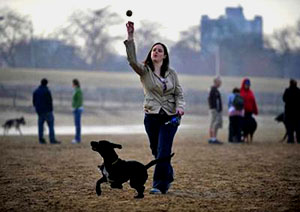 Windy
City canines, these parks are paradise. That's because the
Chicago Park District's dog parks are leash-free and give
canines a year-round chance to do what they were born to do
-- run free, and with other dogs, no less. Windy
City canines, these parks are paradise. That's because the
Chicago Park District's dog parks are leash-free and give
canines a year-round chance to do what they were born to do
-- run free, and with other dogs, no less.
Chicago's doggie parks Share photos of your partner and pet(s)
Share YOUR cutest dog photos!
Some dog parks provide extra bonuses, such as drinking fountains
specially sized for dogs (those are turned on in mid-April).
The Wicker Park dog park, 1425 N. Damen, features a doggie
wading pool brought to the park by community residents.
"More and more people are getting dogs rather than having
children," said Janis Taylor, planning coordinator for
the Chicago Park District, which operates 14 dogs parks and
a dog beach. "It's congested in the downtown area, and
some people don't have a backyard. Dogs need a place to get
exercise and play, so the dog parks become very popular, especially
during the warm months," Taylor said.
Bonding with other people is a big dog park attraction. "It's
a good opportunity for people to socialize and form bonds
that bring the community together," Taylor said.
For dog walker Lexie Antonio, getting to the dog park is a
way to meet and greet other people. "It's basically a
chance to network," said Antonio, 33. "If I have
my way, I'm going to figure out some way to make a party out
of it this summer."
The humans aren't the only ones socializing. "I've met
many people here and so has Jovie," said Christine Bainbridge.
The dog park at 653 N. Kingsbury is a daily ritual for her
and her 3-year-old Shih Tzu. "His favorite friend is
a Pekinese named Henry. They roly-poly and have a great old
time."
Since Wiggly Field -- the city's first dog park -- opened
in the Lincoln Park neighborhood in 1997, the number of parks
has grown to 14. Two more are scheduled to open in late 2010.
Ben Jablonski, 28, often takes his 5-year-old yellow Lab,
Janie, to the Hamlin Park dog park. Recently, Janie was attacked
by another dog and suffered injuries that required two surgeries.
Still, Jablonski says he's sold on dog parks, and he and Janie
have both already returned. However, he says dog owners heading
to the park need to exercise caution.
"The main thing is to pay attention. If someone approaches
the park with a dog that is acting aggressively outside of
the fenced area, I would ask that person not to enter,"
Jablonski said, something dog owners are allowed to do under
park regulations.
RULES FOR PARK LARK
The Chicago Park District has specific rules
for its dog parks, including:
* Dogs must have city dog license tags and be fully vaccinated.
Misdemeanor penalty fines can be as high as $1,000.
* If your dog bites or injures someone, you're legally responsible.
* Dogs with a known history of, or who exhibit, dangerous
behavior are prohibited.
* Owners must remain with their dogs at the park and dogs
must be watched at all times.
* Dog owners are required to clean up their pet's waste. Failure
can result in a fine up to $500.
* Children under 12 can enter the park only when accompanied
by an adult.
* Only three dogs per person allowed.
* Puppies must be older than four months and female dogs in
heat are prohibited.
Photo:
Sara Comer plays catch with her 1-year-old Labrador retriever
mix, Lucy, at the Montrose Dog Beach. Chicago has 14 dog parks
and one dog beach. (Dom Najolia/Sun-Times)
|

Michael Vick leaves federal prison in Kansas
By LARRY O'DELL
Associated
Press Writer
March
25, 2009
RICHMOND, Va. – Suspended NFL star Michael Vick has
left a federal lockup in Kansas, apparently  bound
for Virginia to appear at a bankruptcy hearing next week. bound
for Virginia to appear at a bankruptcy hearing next week.
The U.S. Bureau of Prisons Web site showed Wednesday that
Vick was no longer at the federal penitentiary in Leavenworth,
Kan. It listed his status as "in transit."
It was not clear when he left, or where he was. But two weeks
ago, U.S. Bankruptcy Judge Frank Santoro demanded that Vick
to testify at an April 2 hearing in Newport News about whether
his Chapter 11 bankruptcy plan should be confirmed. Another
judge issued a court order directing federal marshals to bring
the former Atlanta Falcons quarterback to Virginia for the
hearing.
Bureau of Prisons spokeswoman Victoria Joseph said bureau
policy prohibits disclosure of the prisoner's destination
until after he arrives. Vick's attorneys did not immediately
return phone messages left by The Associated Press.
Vick is serving 23 months for bankrolling a dogfighting conspiracy.
He is eligible to move into home confinement no earlier than
May 21 and is scheduled to be released from custody on July
20.
Vick will likely be kept in a southeastern Virginia jail until
the hearing, but it wasn't known which one. Newport News Sheriff
Gabe Morgan said he had not been notified that Vick would
be staying in the city jail, but it was possible Vick and
federal marshals would show up unannounced.
The judge overseeing Vick's bankruptcy case rejected the idea
of allowing testimony by video hookup, saying he needed Vick
in the courtroom so he could assess his demeanor and credibility.
Vick's plan for paying his creditors is based largely on his
intention to resume his NFL career. Vick was suspended indefinitely
after his 2007 indictment, and NFL Commissioner Roger Goodell
has said he will review Vick's status after he is released.
The Falcons still hold the contract rights to Vick but have
said they will try to trade him. Vick's bankruptcy plan would
allow him to keep the first $750,000 of his annual pay. After
that, a percentage would go to his creditors based on a sliding
scale.
Photo:
JUSTICE, Bronze and glass sculpture by Rodin S. Coane, 2008
Click
√  to view the VICKTORY MEMORIAL
WORKS by Rodin S. Coane
to view the VICKTORY MEMORIAL
WORKS by Rodin S. Coane
|

Needy Seattle area dogs receiving kibble windfall
March
25, 2009
SEATTLE — A mountain of dog food has proven a bit of a
headache for the Port of Seattle. Port officials bought 12.7
tons of kibble in June to test new baggage conveyor systems
at Seattle-Tacoma International Airport. In October, the 1,600
bags were stored in a warehouse, with snowstorms keeping it
there longer than anticipated.
On Tuesday, port officials voted to donate the dog food to two
animal shelters, but it was too much for the outlets in Seattle
and King County to store. So the shelters are passing on most
of it to food banks for the dogs of people in need. |

Cops seize Chihuahuas from alleged puppy mill
By Sara Olkon |Tribune reporter
March
25, 2009
Almost 70 puppies were found Tuesday living in a West Englewood
residence, some in filthy bird cages, officials 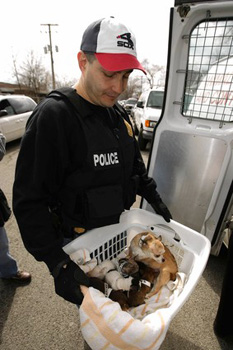 said.
"I couldn't believe it: the chaos, the noise, the smell,"
Cook County Sheriff Tom Dart said outside the small home while
holding two shivering Chihuahua puppies. Dart, who took part
in the raid, garnered national attention last fall after he
briefly suspended evictions for mortgage foreclosures in the
county. Earlier this month, the sheriff sued Craigslist.com
for allegedly facilitating prostitution. said.
"I couldn't believe it: the chaos, the noise, the smell,"
Cook County Sheriff Tom Dart said outside the small home while
holding two shivering Chihuahua puppies. Dart, who took part
in the raid, garnered national attention last fall after he
briefly suspended evictions for mortgage foreclosures in the
county. Earlier this month, the sheriff sued Craigslist.com
for allegedly facilitating prostitution.
In a news conference Tuesday outside the residence in the
6400 block of South Bell Avenue, Dart carried the tiny dogs
out in cages for cameramen to photograph. The dogs—mainly
Chihuahuas, but also a Yorkshire terrier, Pomeranians and
a pug mix—yipped and yelped during the procession but
did not look underfed or ill.
Dart said the animals would be checked out by a veterinarian
at Chicago Animal Care and Control and would likely be available
for adoption in coming days. For information on adoption,
call 312-747-1406. Demetria Newell, 38, of the Bell Avenue
address, was charged with 67 misdemeanor counts of animal
cruelty, while another resident, David Hayes, 37, was charged
with felony possession of marijuana, authorities said. Dart
said the puppies were being sold for $475 apiece at the alleged
puppy mill.
Underneath a neon dog sign outside the house was a placard
that read: "Warning: This is a 15th Ward Block Club Watch
Area and we know our police."
Officials
removed 67 puppies, some crammed into bird cages during a
raid at a home in the 6400 block of South Bell Avenue on Chicago's
South Side.
Tribune photo by Terrence Antonio James
|

Iditarod ends, critics seek inquiry into dog
deaths
By Yereth Rosen
Tue
Mar 24, 2009
ANCHORAGE, Alaska (Reuters) - Timothy Hunt of Michigan was the
final musher to cross the finish line of the Iditarod Trail
Sled Dog Race on Tuesday morning, bringing to a close the 1,100-mile
(1,800-km) event, which came under fire for an unusually high
number of dog deaths.
Hunt of Marquette, Michigan, was the 52nd musher to complete
Alaska's most popular sporting event, finishing in 15 days,
14 hours, 6 minutes and 22 seconds, nearly six full days after
Lance Mackey claimed his third victory in the Anchorage to Nome
race. Since he was the last musher to finish, Hunt received
the "Red Lantern" award -- a reference to the red
light at the back of a long train -- meant to signify perseverance.
Amid the Iditarod celebrations and honors, some animal rights
activists raised questions about the number of dog deaths. Iditarod
spokesman Chas St. George said, "We've had five deaths
associated with the race this year, and that's five too many.
The goal is zero fatalities."
Preliminary investigations show that two of the dogs died from
pulmonary edemas, or fluid in the lungs, associated with heart
abnormalities, St. George said. The cause of death for the three
other cases is unknown, he said.
Typically, one or two dogs die during the running of the Iditarod.
A sixth Iditarod dog died in a post-competition aircraft incident.
The race has stringent dog-care protocols, which were improved
for this year's race with the use of tracking devices that allowed
mushers to summon aid if needed, St. George said.
People for the Ethical Treatment of Animals, a longtime critic
of the race, said the Iditarod's investigations were not good
enough and asked the Alaska State Troopers to launch a criminal
inquiry. "The Iditarod is more than a thousand miles of
torment for these dogs," PETA Director Debbie Leahy said
in a statement. "Every year, dogs suffer serious injuries
and death. The five dogs who paid for this race with their lives
deserve justice. And that means holding these mushers accountable
under Alaska's very clear cruelty-to-animals law."
The state's police agency said no investigation is planned,
unless the race's organizer requests it. "Unless the Iditarod
Trail Committee indicates some concern over the treatment or
cause of death of these animals, we do not generally investigate
those particular events," it said in a statement. "If
someone within the Iditarod Trail Committee or from the public
has evidence of behavior that is beyond normal practices of
mushing activities, we will gladly look into these acts." |
 DOG-POOP
FINE NOT DOING SQUAT
DOG-POOP
FINE NOT DOING SQUAT
By SALLY GOLDENBERG
March
24, 2009
New Yorkers are in for some more crappy news. The city is on
pace to issue roughly the same number of tickets this year as
it did last for dog walkers neglecting to scoop up canine poop
despite more than doubling the fine from $100 to $250.
The Department of Sanitation handed out an average of 56 tickets
per month between Jan. 1, 2008, and Nov. 6, 2008, when the fine
was $100, records show. Since the $250 penalty was put in place
Nov. 7, 2008, the department has issued an average of 54 monthly
violations, department statistics show.
"Once or twice, I don't pick it up, but I try to because
it bugs me, too, when people don't pick up. It's gross,"
dog walker Rina Windasari said in Central Park yesterday. Windasari,
who has been walking dogs five days a week for the past two
years, said she sees as much pooch poop in the park as she did
before the city raised the fine.
Another dog walker in the park, Christine Bera, agreed the piles
of canine waste are as prevalent as ever.
"I don't like stepping in it and then I have it all over
my shoes. It's disgusting," Bera said, lamenting that she
tossed out two pairs of Steve Madden boots because of poop.
Sanitation spokesman Matt Lipani said flatly, "There is
absolutely no correlation between the amount of canine-waste
summonses the department writes, or the cost of the summonses,
and whether or not dog owners pick up after their dogs."
The city issued 561 tickets at $100 each during a 10-month period
last year, and has handed out 215 violations since the $250
fine went into effect. |
 FROM FROM

Mean dogs stand guard at Idaho prison
By REBECCA BOONE
March
24, 2009
BOISE, Idaho — Nobody has broken out of the Idaho State
Correctional Institution in more than 20 years. Prison officials
like to think a hard-bitten corps of sentries with names like
Cookie, Bongo and Chi Chi has had something to do with that.
The institution is the only state prison in the U.S. to use
snarling, snapping sentry dogs to patrol its  perimeter.
In a program begun in 1986, 24 mean dogs — mostly German
shepherds, rottweilers and Belgian malinois, with a few boxers
and pit bulls — roam the space between the inner and
outer chain-link fences 24 hours a day, ferociously defending
their territory. Get too close to the fence and they will
bare their teeth, bark and lunge. Set foot in their space
and they will attack. perimeter.
In a program begun in 1986, 24 mean dogs — mostly German
shepherds, rottweilers and Belgian malinois, with a few boxers
and pit bulls — roam the space between the inner and
outer chain-link fences 24 hours a day, ferociously defending
their territory. Get too close to the fence and they will
bare their teeth, bark and lunge. Set foot in their space
and they will attack.
The animals themselves are former death row inmates —
dogs that were deemed too dangerous to be pets and would have
been destroyed at the local pound if they had not been given
a reprieve and assigned to prison duty. "We're basically
giving them a second chance at a good, healthy life,"
said Corrections Officer Michael Amos, who heads the sentry
dog program. "Those same instincts that make them a bad
pet make them good sentries."
Prison officials say the canines save on manpower and are
more reliable during power outages than electrical security
systems and more effective in the fog and the dark than the
humans posted in the lookout towers. They also seem to have
a powerful deterrent effect.
No one has escaped from the 1,500-inmate medium-security prison
since the dogs were brought in. No one has even tried to get
past the fences since the early 1990s.
"The average offender has no problem engaging in a fight
with a correctional officer — they're used to fighting
with humans. But they don't want to mess with a 100-pound
rottweiler who has an attitude and who wants to bite the snot
out of them for climbing that fence," said James Closson,
a dog trainer in Boise who arranged the donation of some overaggressive
dogs to the prison when the sentry program was new.
Over the years, the dogs have bitten handlers, badly mauling
a staff member who in the late 1990s entered the kennel without
first making sure all the animals were caged. But no inmates
locked up at the prison have been bitten, authorities said.
Dogs were once widely used as sentries in the U.S., particularly
after World War II, when canines that had been trained by
the military were pressed into civilian service. The practice
fell out of favor during the civil rights era as police dogs
became associated with racist and repressive law enforcement,
said Chris Byrne, owner of Stonehill Kennel and Unlimited
Dogs, which provides police dogs to the New York Police Department.
Many prisons continue to use dogs for tracking escaped inmates
or sniffing out drugs or other contraband, but not as sentries.
"Most facilities have gone to electronic motion detectors
or electrical fencing," said Jay Christensen, deputy
warden of security at the Idaho prison. "But technology
can be circumvented. We had a guy at the Idaho Maximum Security
Institution get through a motion detector system a few years
back" by moving so slowly that the sensors didn't pick
him up. "The dogs are much more dependable and the cost
is really low," he said.
In
the early 1990s, three inmates at ISCI tried to escape through
the one portion of the fence that wasn't guarded by dogs at
the time, Christensen said. The guards in the towers could
not see them in the dark, but a dog along a nearby section
of the fence sounded the alarm by barking. The ruckus alerted
the nearest tower guard, who fired a shot, hitting one of
the convicts, Christensen said. The two others were so frightened
by the shot that they gave up, and all three were recaptured,
he said. Officials promptly reconfigured the fence so that
there were no sections without dogs, he said.
Angus Love, executive director of the Pennsylvania Institutional
Law Project, an inmate advocacy group, said he knows of no
complaints about the use of prison sentry dogs.
The dogs work two days on and one day off. On their days off,
they are returned to their kennel, where their handlers groom
them, play ball and tug-of-war with them, or, in the summer,
let them splash in a plastic kiddie pool. The handlers have
to be alert at all times because of the danger of getting
bitten.
Adam Goldfarb, a spokesman for the Humane Society of the United
States, said that the Idaho prison appeared to be handling
the dogs well, but that he had mixed feelings about the program.
"We love the thoughts behind it, of taking dogs who would
otherwise be euthanized and finding a way to work with them
and give them a kind of purpose to their life," Goldfarb
said. "But we'd have concerns of the dogs being harmed
in some way, if an inmate could throw or poke something through
the fence that could harm the dogs. And I'm not sure what
kind of life that is for a dog. When people have dogs in their
home, we would certainly discourage them from leaving the
dog on a chain or in a pen for most of their life."
The program, with 36 dogs in all, costs less than $100,000
a year, including food and veterinary care, Christensen said.
He worries that one day, officials will come up with the $300,000
or more he estimated it would cost to replace the animals
with electric fences or motion detectors.
"Is this K-9 program going to survive for ever and ever?
Probably not," he said. "But I tell you, I do not
want to be the deputy warden of security who takes these dogs
off the perimeter. I consider that a risk to the public."
|
 President
Obama to Leno: dog was 'campaign promise' and will arrive in
April
President
Obama to Leno: dog was 'campaign promise' and will arrive in
April
Helena Sung
March
20, 2009
After
talking at length about the economy and AIG's bonuses, Leno
changed topics and his questions  turned
more personal--asking the President about bowling, basketball,
and his pick for the Final Four. Then Leno had one last question--about
the much anticipated First Dog. turned
more personal--asking the President about bowling, basketball,
and his pick for the Final Four. Then Leno had one last question--about
the much anticipated First Dog.
"When is the dog coming? I keep hearing about the dog.
When was the dog supposed to be there by?" Leno asked.
"I thought it was as soon as you moved in."
"Listen," Obama said with mock seriousness. "This
is Washington. That was a campaign promise.
"Oh, wow," Leno shouted, as the audience laughed
and cheered and Obama broke out into a huge grin.
"I'm teasing," Obama said. "The dog will be
there shortly. We have been laying the groundwork. I've got
to go to the NATO summit. When I get back, the dog will be
in place."
"Wow,'' Leno babbled. "It's, what, a Portuguese
water head?''
"It's not that,'' Obama laughed. "It's not a "water
head."
"Whatever they are,'' Leno said, "I don't know what
they are.''
"That sounds like a scary dog,'' Obama joked. "Sort
of dripping around the house.''
"I don't know what it is,'' Leno confessed.
"We're going to get a dog that is -- that I think the
girls will have a great time,'' the president said. "I
think I'm going to have a lot of fun with it. You know, they
say if you want a friend in Washington, get a dog.'' (Actually,
it was President Harry S. Truman who said that; he gave his
dog Feller away, so we hope Obama doesn't do that.)
Click
√
here >  for
more from Helena Sung
at Pet
News Examiner for
more from Helena Sung
at Pet
News Examiner
|

Sago
Palm Plant Kills Puppy
March
20, 2009
It’s hard to believe a houseplant could harm a
tough cookie like the Woytek family’s Lab mix, Amber.
A survivor of Hurricane Ike, the young pup was diagnosed with
distemper in the months after her adoption from the Houston
SPCA in September 2008. But according to Laurie Woytek, Amber
defeated the often fatal virus—and went on to form a
tight bond with her canine “sister” and partner-in-crime,
Scout, a one-year-old Rhodesian ridgeback mix.
Early last month, Laurie discovered that Amber had eaten parts
of a sago palm plant. Sago palm—with its dark green
leaves and hairy trunk—has become a popular houseplant
in recent years, but unbeknownst to many green-thumbed pet
parents, it’s also highly toxic to cats and dogs.
Immediately ill, Amber was hospitalized at a nearby emergency
clinic. Says Laurie, “I was very scared, but thought,
‘She's tough—she'll make it through.’”
After several days in the hospital, the emergency veterinarian
delivered the heartbreaking news to the Woyteks—Amber
had developed jaundice and life-threatening liver failure.
“We took Amber to our regular veterinarian to discuss
our options with him,” explains Laurie. “She suffered
seizures in the car on the way, and we ultimately made the
very difficult, yet humane decision to let her go.”
Sadly, Amber’s story is all too common. Since 2003,
the ASPCA has seen an increase by more than 200 percent of
sago palm and cycad poisonings, and 50 to 75 percent of those
ingestions resulted in fatalities. According to Dr. Sharon
Gwaltney-Brant, veterinary toxicologist and vice president
of the ASPCA Animal Poison Control Center, all parts of the
plant are toxic, not just the seeds or nuts, and common signs
of ingestion include vomiting, diarrhea, weakness, depression,
seizures and liver failure.
Before the Woytek family said their final goodbyes to Amber,
they took her home to see her best buddy, Scout. “As
Amber lay still on the floor, Scout kept nudging her as if
to say, ‘C’mon, get up,’” Laurie says.
“They weren’t just 'sissies'—as we referred
to them—they were best friends.”
“It was the hardest thing I've ever had to do,”
reflects Laurie. “Amber is truly missed and will forever
be in our hearts. She was our little princess.”
In memory of Amber the ASPCA reminds
all pet parents to stay informed about protecting pets from
accidental poisonings. Please read our poison prevention
tips online. See links below.
Sago
Palm
• Additional
Common Names: Coontie Palm, Cardboard Palm, cycads and zamias
• Scientific Name: Cycas revoluta, zamia species
• Family: Cycadaceae
• Toxicity: Toxic to Cats, Toxic to Dogs, Toxic
to Horses
• Toxic Principles: Cycasin
•Clinical Signs: Vomiting, melena, icterus, increased
thirst, hemorrhagic gastroenteritis, bruising, coagulopathy,
liver damage, liver failure, death.

Related
Links
What
To Do If Your Pet Is Poisoned
Don’t panic—these tips can help save your pet.
17
Common Poisonous Plants
Learn to recognize dangerous household plants.
Animal
Poison Control FAQ
Common questions that can save your pet’s life.
|

Video Exposes Military's Stabbing of Dogs
The Bolivian military performs barbaric exercises
on dogs.
March
19, 2009
PETA has received horrific torture videos that show live dogs
who scream in pain while being stabbed and killed during combat-training
exercises conducted by soldiers in the Bolivian military.
The soldiers state that their instructors received training
from the U.S. military in how to conduct these exercises,
and the training partnership is corroborated by a written
agreement signed by the two countries.
Watch
this video now and learn how you can help stop this!
WARNING:
EXTREMELY GRAPHIC!
http://getactive.peta.org/campaign/bolivia_military?c=weekly_enews
|

Weird
but True
By
LUKAS I. ALPERT
March
19, 2009
An
Apex, NC, couple thoughtthey had been robbed when $4000 in
cash disappeared from their house. They discovered the truth
only when mom took the Dog out for a walk and discovered bits
of cash in its poop.
Kelly
Davis washed the pieces off and hopes there is enough of the
money left to bring it to the bank.
|

One
of Oprah Winfrey's puppies succumbs to virus
By William Hageman | Tribune staff reporter
March
18, 2009
One
of two puppies adopted by Oprah Winfrey this month has died.

Winfrey adopted an 8-week-old blond cocker spaniel from PAWS
Chicago and introduced the puppy, named Sadie, to her TV audience
on her March 6 show. She also brought out three of Sadie's
littermates, one of whom she subsequently adopted and named
Ivan. Several days later, Ivan became ill with the highly
contagious parvovirus. A spokeswoman for Winfrey's Harpo Productions
confirmed Tuesday that Ivan died late last week. Sadie, too,
was infected, but has stabilized for the first time since
she began receiving treatment last Thursday. The spokeswoman
said "she's holding her own for now."
Winfrey, in a statement to the Tribune, said, "I'm saddened
by his passing, though we only had him for a weekend. I remain
hopeful that Sadie will pull through."
Puppies, whose immune systems are not yet fully developed,
are most susceptible to parvovirus, which is transmitted through
fecal matter and vomit of infected dogs. It can be brought
into a puppy's environment on someone's shoes or clothes or
even on the tires of their car. It's extremely hardy and can
survive in the environment for up to nine months. A pet owner
doesn't know a dog is infected until the symptoms develop.
"It's a devastating disease when it hits," says
Kathleen Heneghan, past president of the Chicago Veterinary
Medical Association.
Symptoms include bloody vomiting and/or diarrhea, which can
lead to extreme fluid loss and dehydration until shock and
death result. Also, bacteria can invade the animal's entire
body, resulting in the formation of septic toxins and death.
It is not a threat to humans. With early and intensive treatment
the survival rate is nearly 80 percent.
In a statement released late Tuesday, PAWS said: "Our
thoughts and prayers are with Oprah Winfrey on the loss of
Ivan, and we are hopeful that Sadie makes a full recovery.
"
At PAWS Chicago, all of our animals receive excellent medical
care. We take stringent precautions to prevent life-threatening
diseases, including parvovirus. Our medical protocols are
best in class in the industry and the steps we take prior
to adoption include administering all required vaccinations,
diagnostic testing, multiple veterinary checks and a 14-day
isolation period for puppies.
"Of the 501 puppies that PAWS Chicago took in during
2008, 99.2 percent either did not contract parvovirus or were
cured of the disease.
"We remain committed to staying at the forefront of excellent
shelter practices."
Winfrey has worked with and supported PAWS in the past, most
notably during a series of shows last year about puppy mills
and pet overpopulation. She also has funded a pet room at
the facility.
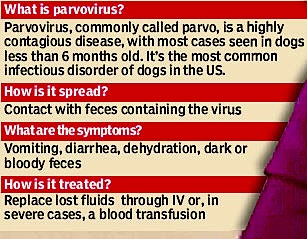
Heneghan says that until a puppy has completed its shots,
it's best to avoid areas where they might come in contact
with the virus: the beach, puppy play dates, dog parks and
so on. "You have to treat a puppy like a brand-new baby,"
she says. "They're not fully protected until they're
4 months of age."
Heneghan also said that the best insurance for a pet owner
is to develop a strong relationship with a vet.
"Make sure the puppy is checked out from Day 1. That
way, if something does change and it becomes ill, you've already
got someone you trust who you can bring the pet to."
Photo:
Oprah Winfrey shows off her cocker spaniel puppy, Sadie /
New York Post
|

Editorial
Equine Alternative
Published:
March 17, 2009
Early this month, a team of archaeologists reported evidence
that horses were domesticated perhaps a  millennium
earlier than had previously been thought. The site was where
northern Kazakhstan is now, the culture was called Botai and
the date was around 3500 B.C. The Botai did not just herd horses
for meat. Scientists found bit-wear marks on Botai horses’
teeth — a clear sign the animals were being ridden. They
also found evidence on pottery fragments that “very likely”
came from mare’s milk fat — a sign that the horses
were being milked. millennium
earlier than had previously been thought. The site was where
northern Kazakhstan is now, the culture was called Botai and
the date was around 3500 B.C. The Botai did not just herd horses
for meat. Scientists found bit-wear marks on Botai horses’
teeth — a clear sign the animals were being ridden. They
also found evidence on pottery fragments that “very likely”
came from mare’s milk fat — a sign that the horses
were being milked.
This
discovery pushes back the date for a hugely important technological
change in human existence. But it’s also a reminder
that domestication isn’t just the conquering of one
species by another. It’s the willing collaboration between
two species, a sharing of benefits. There is something
in the equine nature — genetic or social — that
allowed it to partner with humans, just as there was in the
character of Dogs.
You might also say that there is something in human nature
that allowed us to seek out this partnership. Among all the
animal species on this planet, humans have domesticated only
a handful. And that fact gives rise to a thought-experiment.
What if that genetic or social something had been missing
in horses? What if they had remained resolutely wild, refusing
the domestic kinship humans tried to impose upon them?
It is not a far-fetched notion. But what it suggests is an
alternative history of human development, one in which we
could have moved no faster over land than our own foot-pace.
How that would have retarded the spread and integration of
language, culture, civilization is hard to calculate. It is
safe to say that without domesticated horses, we could not
have begun to be who we are today.
|

The Mayor's Alliance for NYC's Animals works to end euthanization
in shelters by 2015!
Patricia Flaherty
NY Animal Advocate Examiner
March
16, 2009
New Yorkers understand the quick passing of time – and,
the Mayor’s Alliance for NYC’s Animals, understands
how the New York minute negatively affects the unadopted animals
in New York shelters.
Every year, over 40,000 animals enter the New York City animal
shelter system. In 2008, it is projected that 16,340 were
euthanized simply because there was no room to keep them and
no homes to be found for them. But, with the ingenuity and
passion employed by people like Jane Hoffman, now President
and Chair of the Board of the Mayor’s Alliance for NYC’s
Animals, The Mayor's Alliance for NYC’s Animals, Inc.
was founded in 2002 and is dedicated to ending the euthanization
problem....
Click
√
on Mayor's
Alliance logo above for full article
Click
√
here for more from Patricia Flaherty, Ny
Animal Advocate Examiner
for more from Patricia Flaherty, Ny
Animal Advocate Examiner
|

Disheartened
by inhumane treatment of animals? Judge Judy helps us stay hopeful!
Patricia Flaherty
NY Animal Advocate Examiner
March
16, 2009
.
Some
days the task of reaching humane treatment of animals seems overwhelming,
and it is easy to get 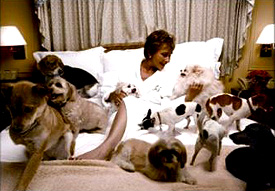 disheartened.
Whenever I feel overwhelmed with sadness for the animals
and begin to lose hope about bringing a stop to animal abuse,
however, I remind myself of Judge Judy 's comments during her
interview highlighted in Jana Kohl's book A Rare Breed of
Love: disheartened.
Whenever I feel overwhelmed with sadness for the animals
and begin to lose hope about bringing a stop to animal abuse,
however, I remind myself of Judge Judy 's comments during her
interview highlighted in Jana Kohl's book A Rare Breed of
Love:
Question: How did you become concerned about
animal welfare?
Judge Judy: Finding an abandoned
and malnourished puppy some forty years ago. It's only a
small step from animal abuse to people abuse.
Question: What have you learned from
sharing your life with animals?
Judge Judy: You always get more unconditional
love than you give.
Question: What would the public be
surprised to see or hear that you do when you are alone with your
dogs?
Judge Judy: I cook for my babies
-- beg them for kisses -- and spoil them rotten.
Question: If a puppy mill owner were
standing before you in your courtroom on charges of animal cruelty,
what would you say to him or her? What do you think is a
just and appropriate sentence for such crimes?
Judge Judy: I would say that there
must be a special place in hell reserved for people who torture
animals. Until you get there, you'll deal with me.
Click
√
here for more from Patricia Flaherty, Ny Animal
Advocate Examiner
for more from Patricia Flaherty, Ny Animal
Advocate Examiner
Click
√
on
Judge Judy image above for details of Jana Kohl's A Rare Breed
of Love
Photo
from Jana Kohl's novel A Rare Breed of Love available on Amazon.com.
Pictured is Judge Judith Sheindlin with rescue dogs Zorra, Happy,
Lulu, Roscoe, Jasper, Reggie, Pico, Billy Bean, Tatum and
Baby |

Rabies
Deaths From Dog Bites Could Be Eliminated Globally
Adapted from materials provided by McMaster University
March
16, 2009
Someone in the developing world – particularly in rural
Africa - dies from a rabid dog bite every 10 minutes. But
global elimination of this horrific disease appears to be
possible, according to a team which includes scientists from
McMaster University, Britain and the United States.
In a paper in the current issue of PLoS Biology, they report
their analysis of data on rabies transmission in two districts
of rural Tanzania (Serengeti and Ngorongoro) and suggest that
with "sustained, international commitment, global elimination
of rabies from domestic dog populations, the most dangerous
vector to humans, is a realistic goal."
Jonathan Dushoff, an assistant professor of biology at McMaster
University, and a member of the Michael G. DeGroote Institute
for Infectious Disease Research, analyzed the data. "The
paper provides important evidence that the elimination of
canine rabies may be possible."
Rabies is an acute viral encephalitis that is spread through
the saliva of infected animals. Human rabies deaths from domestic
dogs are rare in North America, but the disease causes over
24,000 deaths a year in Africa, mostly in poor rural communities
and, most often, in children. Globally, 55,000 people die
annually from canine rabies....
Click
√
on Science
Daily
logo for full article
|

In
Hard-Bitten Baghdad, Tough Tactics on Strays
Newly Calm City Now Finds Dogs a Threat
By SAM DAGHER
March
15, 2009
BAGHDAD — While human beings in Iraq were killing each
other in huge numbers, they ignored the  dogs,
which in turn multiplied at an alarming rate. Now stray dogs
are such a menace that municipal workers are hunting them
down, slaughtering some 10,000 in Baghdad just since December. dogs,
which in turn multiplied at an alarming rate. Now stray dogs
are such a menace that municipal workers are hunting them
down, slaughtering some 10,000 in Baghdad just since December.
This is not exactly good news, but it does seem a measure
of progress that Iraqis have the luxury of worrying about
dogs at all.
“Give us clean water instead of killing dogs!”
Hussein Ali, 62, yelled recently at a group of veterinary
employees enticing a pack of strays with meat laced with strychnine.
“The dogs are not harming us, it is the water.”
Many Iraqis still lack the most basic of services, like sewage
systems and potable water.
One of the dog control officers, out poisoning dogs on a crisp
and clear winter morning, explained that he was only doing
his part, unglamorous maybe, to make life here better. “Iraq
has many problems,” he said. “We are here on a
mission to kill stray dogs.”
With fewer bombs going off and hardly any bodies being dumped
anymore, the dogs are perhaps the biggest problem on the filthy
and rubble-strewn streets of Baghdad. Packs of strays scare
schoolchildren and people who get up at dawn to go to work.
They gather at open-air butcher shops where customers choose
their meat from flocks of live sheep.
Some people believe that the dogs spread disease, not a difficult
case to make in a society that generally
shuns dogs as pets, believing them to be contrary to Islamic
edicts on personal cleanliness.
Thus a relative peace has changed priorities, and not just
in Baghdad. The holy Shiite city of Karbala was so overwhelmed
with stray dogs last year that officials there offered 6,000
dinars ($5.30) for each animal caught and handed over to the
municipality. The dogs were shot and buried en masse.
Here in the capital, a program began late last year in which
the national Ministry of Agriculture’s veterinary services
teamed up with the municipality, the police and even the army
in some of the tougher neighborhoods to tackle the problem.
Mostly the dogs are killed with rotten raw meat laced with
strychnine, a poison used in pesticides and against rodents.
In some cases, particularly around the city’s sprawling
garbage dumps, the dogs are instead shot. By the time this
campaign is over this month, perhaps 20,000 dogs will have
been exterminated, said Shaker Fraiyeh of the ministry’s
veterinary services company.
“Our work may be against animal rights, but there is
a more important issue, public health,” said Dr. Fraiyeh,
a veterinarian in his 30s.
Click
√
on NYTimes
logo for full article
Photo:
Jehad Nga for The New York Times
A stray peered out from a pile of corrugated metal in Baghdad,
where feral packs have surged.
|

LA Pet Store Embraces Humane Model
Grand Opening of Woof Worx features animal
shelter rescued pups
By Lisa Dulyea, Best Friends staff
March
16, 2009
Best Friends Los Angeles Programs (BFLA) hosted an event March
13 to celebrate the grand opening  of
the first rescued pets store resulting from A Puppy-Store-Free
LA . of
the first rescued pets store resulting from A Puppy-Store-Free
LA .
Eight months ago, Best Friends LA launched A-Puppy-Store-Free
LA to stop pet stores from selling puppies because, sadly,
that doggie in the window comes from a puppy mill. Not only
is this a heartbreaking situation for the dogs being forced
to breed in deplorable conditions, but for the new pet parents,
as well.
A puppy purchased from a pet store can cost up to $1,500.
More often than not, these sweet new additions have congenital
disorders and may die with in the first two years of life
due to inbreeding and unhealthy living situations. Few families
can afford the thousands of dollars on unexpected vet bills
and many puppies are surrendered to shelters, where they are
euthanized or wait in vain for a new home. Most never get
that second chance.
Best Friends has been hard at work to find an alternative,
and collaborated with Woof Worx (formerly Pets of Bel Air)
on the idea to sell wonderful, healthy, purebred puppies that
come from local shelters. For a mere fraction of what it would
cost at a traditional pet store, people can adopt one (or
more) of these dogs, support a business that’s doing
the right thing, and save a life.
Jamie Katz, owner of Woof Worx, proudly opened the doors last
weekend to over 150 supporters of this new concept. Veggie
hors d’oeuvres and wine were served at the beautiful,
high-end pet store in the heart of Bel Air.
Available dogs were there to celebrate their new lives, as
well. This is not a typical store where puppies are kept in
cramped confinement on newspaper or plastic flooring. Think
of it as an indoor dog park. The puppies had toys, individual
soft beds, even an indoor pet potty. A comfy couch is in the
puppy room for anyone who wants to get acquainted with their
potential new family member or just be covered with puppy
kisses.
“We are so thrilled to be partnering with Jamie Katz,
the owner of this beautiful store, and to support her in her
efforts,” says Elizabeth Oreck , BFLA manager. “We
truly believe that traditional pet stores that sell dogs from
puppy mills will soon be a thing of the past, and that a store
like Woof Worx will become a national model for cities all
across the country.
“This is not only a great way to showcase rescued animals
who need homes, and to help lower the number of dogs and cats
in our drastically overcrowded shelters, but an opportunity
to educate the public about animal welfare issues. And we
are so grateful to Jamie for taking that leap and being willing
to show the rest of the country that a successful pet store
can be modeled on compassion rather than cruelty.”
Katz was an employee of Pets of Bel Air when BFLA began its
peaceful protests. “I always knew in my heart that selling
puppies this way was wrong,” she says. “I’m
a huge animal lover and advocate of animal welfare.”
Katz acquired the store when the original owner of Pets of
Bel Air lost his lease, due in part to Best Friends’
protests.
Jennifer Krause, puppy mill campaign coordinator, thanked
all the volunteers, supporters and Jamie. “This is a
huge victory, and we couldn’t have done without them.
Jamie just gets it.”
Woof
Worx
2924 N Beverly Glen Circle
Los Angeles, CA 90077
Phone: 310-474-1211
E-mail: jamie@woofworx.com
Photo:
Patrons check out the newly opened Woof Worx by Roberto Valenzuela
of Beverly Hills
|

Weird
but True
By
LUKAS I. ALPERT
March
14, 2009
He's claiming his fraternity hazing has left him in a permanent
haze.
A 21-year-old man charged in a hit-and-run car crash in Kansas
City says posttraumatic stress disorder from a frat hazing,
where he was tied up and left in
a dog cage, has hindered his ability to make proper
decisions.
His lawyer says the defendant makes bad choices under stress.
COMMENT:
So what about caged Dogs?
|
 SCOOP & HOWL - EDITORIAL
SCOOP & HOWL - EDITORIAL
OPINION
March 13, 2009
We
regret and strenuously object to the charges against Muntada
al-Zaidi, the Iraqi journalist who hurled
his shoes at President George W. Bush during a news conference,
and his conviction on those.
We at The
DOGHOUSE insist he be charged with the more serious
bias crime of BLASPHEMY under universal Caninite
law for equating  DOGS
to George W. Bush, an insult to Canines everywhere. "This
is a gift from the Iraqis; this is the farewell kiss, you
Dog!”
shouted al-Zeidi as he miserably missed his target. Lousy
'gift'. DOGS
to George W. Bush, an insult to Canines everywhere. "This
is a gift from the Iraqis; this is the farewell kiss, you
Dog!”
shouted al-Zeidi as he miserably missed his target. Lousy
'gift'.
May
he share a bunk with Bernie Madoff for 150 years!
LET
JUSTICE BE DONE!

From-The-DOGHOUSE.com
• • •

Iraqi Shoe Thrower Gets Three Years
RIYADH MOHAMMED and ANWAR J. ALI
Published:
March 13, 2009
BAGHDAD — An Iraqi journalist who gained acclaim for
hurling his shoes at President George W. Bush during a news
conference here in December was sentenced to three years in
jail on Thursday as distraught family members and supporters
wept outside the courtroom.
Click
√
on NYTimes
logo for full article
• • •
 /AP /AP
SHOE HURLER TO COOL HEELS
March
13, 2009
BAGHDAD - The Iraqi journalist who threw his shoes at then-President
George W. Bush was convicted yesterday of assaulting a foreign
leader and sentenced to three years in prison - provoking
outrage among many Muslims who consider him a hero.
Muntadhar al-Zeidi's bold act last December electrified many
across the Middle East who saw it as a fitting protest against
a president widely reviled for his policies in the region.
Zeidi, 30, pleaded not guilty to the assault charge, telling
the three-judge panel, "What I did was a natural response
to the occupation."
Defense lawyers said he shouted, "Long live Iraq!"
once the sentence had been imposed. Some of his relativescollapsed
upon learning of the sentence and had to be helped out of
the courthouse.
• •
•

To
Make Female Hearts Flutter in Iraq, Throw a Shoe
By ABEER MOHAMMED and ALISSA J. RUBIN
Published:
March 13, 2009
BAGHDAD — What does it take for an Iraqi woman to fall
in love with a man?
In parks and dress shops, in university halls and on picnics,
Iraqi women are still smitten — three months and one
new American president later — by the shoe thrower,
Muntader al-Zaidi.
His conviction and sentencing for three years on Thursday,
only burnished his image as someone who lives out the dream
of the common man and in doing so becomes gallant and desirable.
Zainab Mahdi, a 19-year-old student sporting a red baseball
cap, swung on a swing set in a riverside park on Friday as
she spoke admiringly of Mr. Zaidi. “Every Iraqi wanted
to beat Bush,” she said. “Muntader made our wishes
comes true.” Her sister, Hanan Mahdi, 22, who was standing
next to the swing set, spoke with passion in her voice. “Muntader
make us proud of ourselves as Iraqis,” she said. “We
were in Syria when he hurled his shoes at Bush, and we noticed
the change in the way Syrian people treated us,” she
said. “They treated us in a better way.”
Mr. Zaidi, whom Iraqi girls call informally by his first name,
captured nearly everyone’s imagination here when he
threw his shoes at President George W. Bush during a Dec.
14 news conference with the Iraqi prime minister, Nuri Kamal
al-Maliki. While Iraqi men have been divided over Mr. Zaidi’s
gesture, it was hard to find a woman who wholeheartedly disapproved
of him. In conversations with 20 women over the last several
days, most expressed strikingly positive sentiments about
him and much anger about the three years he must serve behind
bars. “Zaidi restored Iraqi women’s dignity, which
 was
stolen” since the 2003 American invasion, said Um Baneen,
31, a homemaker who said it was President Bush, not Mr. Zaidi,
who deserved three years in prison. “No one dared to
face Bush in the whole world, only Muntader al-Zaidi.” was
stolen” since the 2003 American invasion, said Um Baneen,
31, a homemaker who said it was President Bush, not Mr. Zaidi,
who deserved three years in prison. “No one dared to
face Bush in the whole world, only Muntader al-Zaidi.”
Atiyaf Mahmoud, 19, a student in her first year of medical
school said, “I love Zaidi. I saw him in my dreams twice,
the last one was after the trial, he was released and I went
to congratulate him and shake his hand.”
“I was so excited in that sweet dream,” she said.
“I wish to have that dream again.”
Shoe sculpture honoring Muntader al-Zaidi in Tikrit
|

Dog Sledding in Montana’s Wilderness
By GREG BREINING
Published: March 13, 2009
DOG sledding
is an exercise in changed states, of chaos turning to order.
One moment dogs were 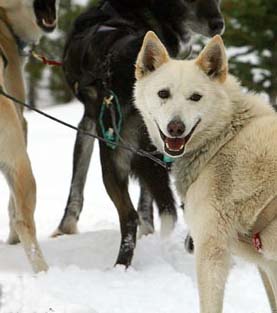 barking,
yapping, whining, snarling, scrapping, jumping, biting and
all the other things dogs do. The next moment they were straining
at the gang line, and with a burst of acceleration, all turned
silent but for the hiss of the runners on the snow and the
sound of my own exhilarated breathing. barking,
yapping, whining, snarling, scrapping, jumping, biting and
all the other things dogs do. The next moment they were straining
at the gang line, and with a burst of acceleration, all turned
silent but for the hiss of the runners on the snow and the
sound of my own exhilarated breathing.
We were mushing in southern Montana earlier this winter in
the Beartooth Mountains, near Yellowstone National Park ,
where long, gliding downhills followed laborious uphills.
As we crested a small hill, the valley opened, and brilliant
Pilot Peak burst into view in stark relief against a black
snow cloud. “This is why I do this,” Jason Matthews
said, standing on the sled runner next to me. “This
is why I’m out here.”
Mr. Matthews, sled-dog racer and guide, runs Yellowstone Dog
Sled Adventures of Immigrant, Mont. Like many sled-dog outfitters
— there are dozens of small businesses that run trips
across North America , from Alaska to the Rockies to Maine
— Mr. Matthews is peddling the romance of age-old wilderness
travel amid stunning scenery, and the intense experience of
working closely with trained, selectively bred dogs.
Dog sledding is an exhilarating and nostalgic way to travel
through wild country — quieter than snowmobiles, faster
than skis or snowshoes. To join a tour requires no experience,
though it does take a bit of effort. And this pristine region
on the Montana- Wyoming border is one of the most breathtaking
spots, literally and figuratively, to do it
Click
√
on NYTimes
logo for full article
and Audio
Slide Show
Photo
credit: Part of the Pack, Jim Wilson/The New York Times
|

A Family Again
by Cathy Scott
March 11,
2009
Renee Clark always held out hope that she’d see Bebe
again. Two long years later, her wish has come  true.
Bebe, a Chihuahua stolen from a car, was reunited with Clark
and partner Carlton Robbins on March 10. true.
Bebe, a Chihuahua stolen from a car, was reunited with Clark
and partner Carlton Robbins on March 10.
When Bebe saw the couple for the first time after all those
months, she immediately ran to Robbins. “Boy, did she
remember him,” Clark says. “She gave him licks
all over his nose and ears.” Then, three-year-old Bebe
ran to Clark. Bebe jumped like a bouncing ball, two feet off
the ground, with excitement, says Jameson Yu, a staffer with
Best Friends Los Angeles Programs who drove Bebe from a Northern
Utah shelter, where she had been left, to her real family
in California.
The dog was stolen after Clark left Bebe in her car to run
into a Los Angeles shelter to pick up a companion dog she’d
just adopted. When she got back to her car, she found that
a thief had pried open a car window, and Bebe was gone.
For three months, Clark posted flyers, ran “lost”
ads in newspapers, regularly checked the local animal shelters
and reported her stolen with a microchip company. It was that
implanted microchip that brought her home again. A Humane
Society of Utah employee called the microchip company after
a woman dropped off Bebe at the shelter. The woman told shelter
employees that she and her husband had had a new baby and
could not keep the dog. She also told them a family member
had given the dog to them.
In Bebe’s absence, Clark and Robbins adopted two shelter
dogs: a German shepherd and a Chihuahua named Luke. “Luke
and Bebe are going to get along great,” Clark says.
She got her as a puppy and had a difficult time adjusting
to life without her. She still has Bebe’s dog tag, T-shirts,
sweaters and toys. “I kept everything, just in case,”
she says. “I can’t tell you how traumatic it was
losing her. She used to sleep next to my ear when she was
as small as a mouse.”
When Bebe went missing, the couple lived in the Eagle Rock
suburb of Los Angeles. Today, they live in Acton, not far
from Magic Mountain, on 2-1/2 acres. “We have doggie
doors and a large fenced in area to protect our dogs from
wildlife,” Clark says. “Bebe’s going to
love life here.”
Now that Bebe’s back, Clark’s not taking any chances.
“I won’t leave her alone in a car again,”
she says, “not even for a moment.
Above:
Bebe back home with Carlton Robbins and Renee Clark
Photo by Jameson Yu
|

Editorial
Mr. Salazar’s Repair Mission
Published:
March 11, 2009
We ... urge [Ken Salazar, the new secretary of the interior]
not to forget the wolf.
The Interior Department’s scientists say that wolf populations
are healthy enough, and state protections strong enough, to
take the animal off the endangered species list in Montana
and Idaho. We do not share their confidence in the states.
De-listing allows for some hunting, and hunters in both places
are itching to start firing away. Mr. Salazar should be ready
to restore protections the instant the long-term survival
of the species seems at risk.
Click
√
on NYTimes
logo for full Editorial
|

Man
wounded, his dog killed in upper West Side push-in robbery
By Jonathan Lemire
Wednesday,
March 11th 2009
A trio of armed robbers burst into an upper West Side apartment
Tuesday with guns blazing, wounding one man and killing his
dog, police said.
The pit bull was hit by three bullets fired at point-blank
range when the home invaders pushed their way into the apartment
inthe Amsterdam Houses near W. 64th St., police said.
The dog, named Nayna, died instantly. The canine's owner,
a 31-year-old man, was shot once in the leg and was taken
to St.Luke's Hospital , where he was in stable condition after
the 11:45 a.m. shooting, police said.
Investigators believe the three men targeted the eighth-floor
apartment believing its occupant had drugs or drug money inside,
police sources said. It was not immediately known if they
took anything before fleeing the housing project, which is
located just a block from Lincoln Center .
The men have not been located, police said. Investigators
were reviewing video from several surveillance cameras late
Tuesday
|

Bashur, dog of war, may be princess in disguise
Her family knows Bashur is special, but dog
rescued from Iraq
might have pedigree too
By Carolyn Starks | Tribune reporter
March
11, 2009
John Fenzel never doubted that Bashur was special, but it
took a customer at his car dealership to help 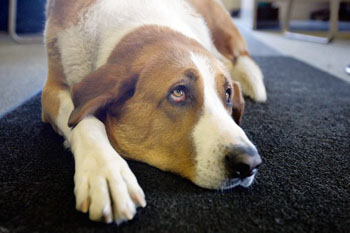 him
discover the bloodlines in the adorable mutt sent home from
war-torn Iraq by his paratrooper son. him
discover the bloodlines in the adorable mutt sent home from
war-torn Iraq by his paratrooper son.
Bashur was just a few days old when she was found along a
roadside in 2003 by U.S. soldiers on their way to Kirkuk.
They scooped her up into their Humvee, and soon she won their
hearts with her relentless affection and will to survive.
As profiled in the Tribune on April, 23, 2004, Fenzel's son,
Lt. Col. Mike Fenzel, became her unofficial guardian, helping
Bashur survive efforts to eliminate feral dogs on the military
base. She was struck by vehicles twice, suffering a crushed
paw the second time, but recovered with the help of Fenzel,
then a major, and an army medic.
Mike Fenzel realized he couldn't keep Bashur in Iraq and had
her shipped to his father in Sleepy Hollow. John Fenzel has
pampered her, all the while shrugging off comments that she
was nothing more than a wild dog.
Then
one day in 2006, Pam Odgers took her truck for repairs at
Fenzel's Chrysler dealership in Hampshire. While waiting,
she turned her attention to Bashur, who was sprawled across
the floor, her reddish and white coat resembling a large area
rug.
"He showed me a puppy picture of Bashur, and I knew what
she was but I couldn't come up with the name until we got
on the Internet," said Odgers, a dog trainer. "The
minute I saw a picture of the breed I knew it was her."
Odgers started tapping furiously on Fenzel's computer, researching
Bashur's unique look—amber-colored hound eyes, a thick
tail that curled up over her back, triangular pendant ears
and large size: 35 inches tall, 135 pounds and 47 inches long.
"She pointed to a picture and everything matched perfectly,"
John Fenzel said. "Nobody knew what she was—her
veterinarian, nobody. Finally, we put it all together."
They decided that Bashur is an Anatolian shepherd, an American
Kennel Club registered breed valued around the world as a
loyal and trustworthy livestock guardian. The Anatolian originates
from the ancient land with the general boundaries of what
is now Turkey and is used to help Turkish shepherds protect
their flocks from wild animals.
"I just got a kick out of it," Fenzel said. "She
really is a treasure."
The behaviors that were at once exacerbating and endearing
suddenly made sense. Bashur obsessively watches the car lot
and her yard at home in Sleepy Hollow, barking at any animals
she senses nearby.
Fenzel walks Bashur every morning before dawn, even in subzero
winter temperatures. She rides with him to the dealership
in a pickup truck, sitting on the seat, her paws on the floor
and her head resting on the dashboard.
"She's the princess here," said sales manager Jerry
Gargo with a smirk.
Indeed, Bashur is professionally groomed every three months.
Every day after lunch, Fenzel walks Bashur in a cemetery where
his father is buried. Bashur knows the routine: She stops
and sits at the grave site while Fenzel talks to his father.
At home, Bashur has the run of a large yard but at night she
sleeps at the top of the steps, standing guard while Fenzel
and his wife sleep.
"She's as loyal as they come," he said. "She's
not a very affectionate dog, but she's constantly with you."
The last time Bashur saw Mike Fenzel, now stationed in California,
was two years ago during his brief visit home. He walked in
the door and said, "Hi buddy!" and Bashur ran up
to him, tail wagging, as if no time had passed.
Tribune
photo by Stacey Wescott
|

Vick's Former Home Fails to Sell at Auction
March 10,
2009
BUFORD,
Ga. – Michael Vick's house is still available. No one
made an offer on the luxury home in  suburban
Atlanta at an auction Tuesday. A minimum bid of $3.2 million
was required, but only two parties showed up and neither brought
the $160,000 payment that was needed just to start the auction. suburban
Atlanta at an auction Tuesday. A minimum bid of $3.2 million
was required, but only two parties showed up and neither brought
the $160,000 payment that was needed just to start the auction.
Sterling Realty Services president Narender Reddy said there
is no market for the eight-bedroom, 11-bath home at that price
in light of the economy. The whole process lasted less than
an hour. Now, a bankruptcy judge must decide the next step
for Vick's house.
The former star quarterback for the Atlanta Falcons is serving
a nearly two-year sentence after pleading guilty to running
a dogfighting ring.
|

Tools That Leave Wildlife Unbothered Widen Research Horizons
By JIM ROBBINS
Published:
March 9, 2009
• • • In Bhutan, for example,
biologists are gathering scat to study snow leopards, which
are extraordinarily difficult to see, let alone trap. The
problem is that there are a lot of different types of scat
on the ground that cannot be differentiated visually. Out
of 100 fecal samples gathered, often only 2 belong to a snow
leopard. Lab testing to find those two samples is expensive.
The scat is shipped to Bozeman, where Dr. Parker is training
a dog, a Belgian Malinois named Pepin, to tell snow leopard
scat from other types. Once Pepin’s sniff test weeds
out the false samples, the right scat can be sent to a lab.
Because of technological advances, a fragment of DNA found
in scat can identify the species and sex of the animal that
produced it. By collecting numerous samples across a territory,
critical migration corridors can be identified as well as
the abundance of a species. Stress hormones in the sample
may be an indicator of the animal’s health. Diet and
parasites can be assessed.
• • •
Click
√
on NYTimes
logo for full article
|

Chicago Alderman Ed Burke proposes pet sterilization again
By Hal Dardick |Tribune reporter
March 10,
2009
A controversial proposal to require most dog and cat owners
in Chicago to sterilize their animals  resurfaced
Monday, and the ordinance's chief sponsor is confident it could
pass. Ald. Ed Burke (14th) has softened some provisions. A third
offense for failing to neuter or spay a pet before it's 6 months
old would now trigger a $100-a-month fine, compared to a single
$500 fine, impoundment and sterilization under the original. resurfaced
Monday, and the ordinance's chief sponsor is confident it could
pass. Ald. Ed Burke (14th) has softened some provisions. A third
offense for failing to neuter or spay a pet before it's 6 months
old would now trigger a $100-a-month fine, compared to a single
$500 fine, impoundment and sterilization under the original.
The new measure says veterinarians would not be required to
report non-sterilized animals. And it no longer requires breeders
to immunize pets before sale and later report the name, address
and phone number of each buyer.
"I've been encouraged by the response of the members of
the City Council, who I think now are prepared to support this,"
said Burke, who expected a committee vote Thursday.
The Illinois Kennel Club and Chicago Veterinary Medical Association
continue to oppose the ordinance, the latter saying sterilization
decisions were best left to pet owners and veterinarians and
could deter critical medical care.
When Burke and Ald. Ginger Rugai (19th) introduced the ordinance
last year, TV personality Bob Barker backed the measure, saying
it would reduce the numbers of euthanized strays.
It also would reduce dog fighting and attacks on humans, Burke
said. The Humane Society of the United States and PAWS Chicago
have backed him. |
 From
Newsday
From
Newsday
Martha Stewart's chow chow dies in propane blast
March
9, 2009
Martha
Stewart's chow puppy was one of 17 dogs killed in a propane
explosion at an eastern 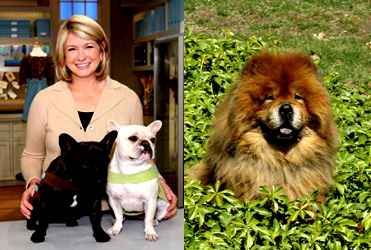 Pennsylvania
kennel. Pennsylvania
kennel.
The domestic maven wrote on her blog that she was "deeply
saddened" by the death of her dog, Ghengis Khan, in Friday's
blast at Pazzazz Pet Boarding, a kennel in the Pocono Mountains
that breeds and trains show dogs. Fifteen dogs were killed
in the explosion, and two more died over the weekend.Related
links
The kennel was getting a propane delivery when the tank ignited,
setting the pens on fire and injuring the driver, Timothy
Kleinhagen, of Summit Hill. Though badly burned, Kleinhagen
managed to toss a cairn terrier over the kennel fence to safety.
He was listed in critical condition Monday at Lehigh Valley
Hospital.
"That man is a hero," said the kennel's co-owner,
Karen Tracy. "My heart goes out to his family."
Genghis Khan was a grandson of Stewart's previous chow, Paw
Paw, which died last April at age 12. Stewart announced on
her blog in December that she was adopting Genghis Khan, then
7 weeks old, calling him "very cute and square."
She said she expected him to be "conquering his new territory
in my home soon, with great charm and prowess. I'm also confident
that Sharkey and Francesca (Stewart's French bulldogs) will
be enamored with him."
It wasn't immediately clear how much time Genghis Khan had
spent at Stewart's Westchester County, N.Y., estate.
Stewart also sent condolences to Tracy, who breeds and trains
dogs that compete in shows throughout the country, including
Westminster. Many of the dead dogs belonged to Tracy and her
mother, Jean Ahner, who live on the property in Franklin Township,
Carbon County, about 75 miles north of Philadelphia.
"My heart goes out to Karen Tracy and I am hoping for
a speedy recovery for those (both pets and humans) injured
in this terrible event," Stewart wrote.
Officials have said a spark or static electricity may have
started the blaze, which remains under investigation but is
considered accidental. AmeriGas Propane Inc., which owned
the truck that Kleinhagen was driving, has declined to comment.
Photos:
Martha Stewart with Sharkey and Francesca
(left); Paw Paw (right)
|
 The
Atlanta Journal-Constitution The
Atlanta Journal-Constitution
Tragic antifreeze death inspires Georgia legislation
to save pets
By SANDRA ECKSTEIN
Sunday,
March 08, 2009
Becky Davis knew the moment she saw her dogs that something
was wrong. “I could look in their eyes and see they
were in trouble,” the Jefferson woman said.
Then she found the chicken and potatoes in her yard, soaked
in antifreeze. Someone had deliberately  poisoned
her two 8-year-old dogs, Chief and Rebel. poisoned
her two 8-year-old dogs, Chief and Rebel.
Although she got them to a veterinarian within an hour of
the poisoning, the vets were able to save only Rebel, and
he has permanent kidney and brain damage. She lost her German
shepherd, Chief.
Police never discovered who killed her dog, but the poisoning
spurred Davis to action.
“I sent e-mails to everyone, including the Humane Society
of the United States, the ASPCA and my elected officials,
including Tommy Benton,” Davis said.
It was Rep. Benton (R-Jefferson), who responded, saying if
she sent him some research on the topic, he’d look into
introducing a bill on the issue.
The result is House bill 219, which would require antifreeze
sold in Georgia to have a bittering agent added to it. The
main ingredient in almost all antifreeze is ethylene glycol,
which has a sweet taste and smell that often attracts animals
and children. Only a teaspoon can kill a pet or small child.
Benton said the bill will require an additive that would make
antifreeze taste bitter, and it would add only about 2-3 cents
to the cost of a gallon of antifreeze. He said antifreeze
manufacturers have told him they support the bill.
Cheryl McAuliffe, the state representative for the HSUS, said
her organization supports the bill, which is similar to legislation
passed in at least six other states.
“I get calls frequently from people saying my pet has
been antifreezed,” McAuliffe said. “This solution
is so simple and inexpensive, and it protects people as well
as animals.”
The bill was still pending in a house committee last week,
and Benton said he was hopeful it would be voted on in time
to get it to a full vote in both the House and Senate this
year.
Davis, who is approaching the first anniversary of the poisonings
this month, said she’ll continue to push the bill.
“I’d rather spend that 2 cents than $7,000 and
still lose my dog,” Davis said. “I think anybody
would.”
|

Gray Wolf Will Lose Protection in Part of U.S.
By JIM ROBBINS
Published:
March 6, 2009
HELENA, Mont. — In a blow to environmental groups and
a boost for ranchers, the Obama  administration
announced Friday that it would take the gray wolf off the endangered
species list in Montana and Idaho, though it left the predator
under federal protection in Wyoming. administration
announced Friday that it would take the gray wolf off the endangered
species list in Montana and Idaho, though it left the predator
under federal protection in Wyoming.
The gray wolf will remain on the federal endangered species
list in Wyoming.
The
delisting allows Montana and Idaho to assume complete management
of the animal, which will include a hunting season in both
states. The move also delists wolves in the western Great
Lakes and parts of Oregon, Utah and Washington.
The new policy was announced by the Bush administration in
January, but its adoption was delayed so the incoming Obama
administration could assess it.
“The recovery of the gray wolf throughout significant
portions of its historic range is one of the great success
stories of the Endangered Species Act,” Interior Secretary
Ken Salazar said. “Today, we have more than 5,500 wolves,
including more than 1,600 in the Rockies.”
Jenny Harbine, a lawyer with Earthjustice in Bozeman, Mont.,
which has sued to keep the federal protections, said, “We’re
disappointed.” She added, “Idaho has shown an
eagerness to kill as many wolves as possible, and they are
drawing up plans for killing wolves as we speak.”
In 2007, Gov. C. L. Otter of Idaho said he favored reducing
the number of wolves there to 100 from more than 800. He also
said he would be the first to buy a wolf hunting license.
Officially, however, Idaho has agreed in its state plan to
maintain a population of 500 wolves. Montana has agreed to
keep 400 wolves. If the number of animals falls below 150
total and 15 breeding pairs for three years in a row, the
wolf will be relisted in that state.
Environmentalists sued last year to stop the delisting under
the Bush administration. They argued that without protection,
wolf numbers were not great enough to assure connectivity
between animals in different regions of the northern Rockies,
which is crucial to assuring long-term survival.
A federal judge agreed, issuing a temporary injunction to
stop the delisting. The Fish and Wildlife Service then dropped
its proposal for more study. “We now have information
that wolves routinely move back and forth between recovery
areas,” said Ed Bangs, the agency’s recovery coordinator
in Helena, Mont. “We’ve resolved that issue.”
Environmentalists say they will take the issue back to court.
While state wolf management plans in Idaho and Montana assure
protection, federal officials say, the one in Wyoming falls
short, so the wolf will remain listed there. Yet in most of
Wyoming, the wolf is designated as a predator and could be
shot on sight if it were to be delisted. Controversy erupted
last year when people chased wolves down on snowmobiles and
killed them from planes.
Photo
credit: Agence France-Presse — Getty Images
|
 Inhumane
dog cull in Bali
Dena
Jones
Inhumane
dog cull in Bali
Dena
Jones
U.S. Programs Director
March
6, 2009
Authorities on the island of Bali, Indonesia, are killing dogs
in the street. In a kneejerk reaction to six  suspected
human rabies fatalities, the government has started culling
dogs in a misguided attempt to stop the spread of the disease. suspected
human rabies fatalities, the government has started culling
dogs in a misguided attempt to stop the spread of the disease.
So far over 1,000 dogs have died - many are being poisoned with
strychnine, which leaves the animals fully conscious while they
suffer convulsions and eventually suffocate.
As a tourist hot spot Bali cannot afford to lose its 'rabies-free'
status. However, the Balinese government's response to this
suspected outbreak is ineffective as well as inhumane - a dog
cull does not attack the root cause of the disease and cannot
safeguard human health. |

Speeder
found in stolen car with stolen items, Dog
March
6, 2009
KENNER, La. (AP) -- First of all, police said he was speeding.
Second, the 18-year-old wasn't wearing a seat belt and was
driving on a suspended license. But that was the least of
his troubles. According to police, when the man was pulled
over on Tuesday they found a marijuana cigarette. Then they
found out the car he was driving was reported stolen. Then
they found $27,000 worth of stolen goods in the car.
And when officers asked about the small dog on the front seat,
the man could not tell them anything about it. But a call
to the veterinarian listed on the dog's tag led to its owner,
who said the pet had been stolen during a home burglary.
Detectives were unsure if the suspect remained in jail Friday.
Information
from: The Times-Picayune via 1010wins
|

New Way to Treat your Pet's Arthritis
Thurs.,
March. 5, 2009
Little Rock, AR -- Imagine watching your dog become crippled
-- with no relief from drugs or surgery. Well, there's a new
procedure that uses the dog's own fat cells to help with arthritis.
Hundreds of dogs who have osteoarthritis have undergone this
procedure. And according to the company that developed the
stem cell therapy, 80 percent showed improvement after the
procedure. But it is still experimental and expensive.
One
doctor, however, doesn't see any controversy with using stem
cells. "This is taken from the own dog and it's treating
its own disease, so there's no problem there, it's not like
a Jurassic Park thing where you take some embryonic stem cells
and go and create a new human." Human clinical trials
using this same type of stem cell technology are also underway
for several diseases.
|
 Oprah
Adopts a Puppy
Oprah
Adopts a Puppy
By William Hageman | Tribune staff reporter
March
4, 2009.
After examining the problems of puppy mills and pet overpopulation
on her show last spring, Oprah Winfrey vowed that her next dog
would come from a shelter.
She made good on the promise over the weekend visited the PAWS
Chicago facility on Clybourn Avenue and took home a female cocker
spaniel puppy.
Winfrey, who had previously sponsored a dog room at the state-of-the-art
no-kill shelter, stopped by Saturday to look at available dogs.
She was drawn to the litter of cocker spaniels--the same breed
as Sophie, her 13-year-old pet who died last year.
Winfrey returned Sunday with Steadman Graham, and they adopted
the goldenish cocker, Sadie. |

Weird
but True
Leonard Greene
March
3 , 2009
A
German politician is proposing a high-tech solution to th
pooch-poop problem.
Officials
would use DNA testing to match the offending Canine with the
offending excrement, which would be on file in a doggie-doody
database.
|

YO
QUIERO 500G FOR YAPPY CHIHUAHUAS
By DAREH GREGORIAN
February
27, 2009
Ay-yi-yi, Chihuahuas! An Upper West Side woman has filed a
$500,000 lawsuit charging that her  downstair's
yappy little dogs are driving her loco. downstair's
yappy little dogs are driving her loco.
In papers filed in Manhattan Supreme Court, lawyer Paulette
Taylor says Theodore Henderson's two Chihuahuas "bark
in a manner that is offensive, constant, continuous and incessant."
The mighty miniatures are loud enough to be heard outside
of Henderson's apartment and inside hers - and she can't take
it anymore.
Taylor, 62, says in the suit that the dogs have her so stressed
that she can't sleep. The suit adds that Henderson "may
even be guilty of inciting his Chihuahuas to bark."
Taylor has complained to Henderson and to the management of
their building at 382 Central Park West for well over a year,
but they've done nothing, said her lawyer, Jacqueline Bukowski.
"We're asking for a restraining order against the dogs,"
Bukowski said, or "some sort of soundproofing" to
block the barking from coming into Taylor's apartment, which
is directly above Henderson's.
Henderson could not be reached for comment. A lawyer for the
building's management company, Maxwell-Kates Inc., said he
had not been served with a copy of the suit and couldn't comment
on it.
The suit seeks $500,000 from Henderson, Maxwell-Kates and
the building's owners for Taylor's "emotional and physical
distress."
*
* *

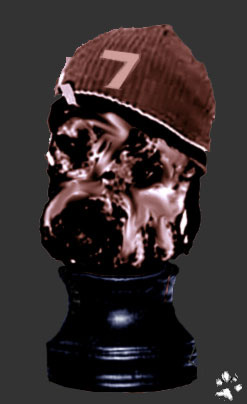 VICK
GOING TO HIS DOG HOUSE VICK
GOING TO HIS DOG HOUSE
THROWN
A BONE: Michael Vick will spend the final two months of his
term under home confinement.
By CLEMENTE LISI
February
27, 2009
Former NFL quarterback Michael Vick is getting a pass. A government
official told The Associated Press yesterday that Vick would
be allowed to finish his prison sentence at home because there
is no room at a halfway house for him.
He is currently serving a 23-month term at the federal lock-up
in Leavenworth, Kan., after pleading guilty in 2007 to bankrolling
a dog-fighting operation in Virginia known as Bad Newz Kennels.
The former Atlanta Falcons quarterback was sentenced in December
2007 and was due to be released July 20, 2009.
Click
√
on NYPost
logo for full article
|

Bedbugs Can’t Hide From Ruby and Pasha
By JAMES BARRON
February
26, 2009
Michael F. Morin says he has cutting-edge technology in the
fight against that growing scourge of city  life,
bedbugs. His
cutting-edge technology is: dogs. Two of them, Ruby and Pasha. life,
bedbugs. His
cutting-edge technology is: dogs. Two of them, Ruby and Pasha.
Ruby is a Beagle. Pasha is a Basenji “and maybe part
terrier,” said Donald Frey, Mr. Morin’s partner
in a four-month-old company that dispatches them to root out
the speck-sized parasites in apartments and schools. And also
four-star hotels (and three- and two-star ones) that worry
about being mentioned in the same breath as “fleabag.”
Alas, a bedbug-free place is not necessarily flea-free. Ruby
and Pasha have a nose for Cimex lectularius, the common bedbug,
and only Cimex lectularius, Mr. Morin said. Fleas are different.
Ruby and Pasha act mild mannered and well behaved, not like
fang-baring attack dogs that want to sink their teeth into
whatever is close by. When Ruby and Pasha smell a bedbug,
they don’t lap it up; they simply sit down.
They savor the moment, hoping for a doggie treat, while Mr.
Morin and Mr. Frey do some bird-dogging of their own. It is
up to the two men to figure out where, exactly, the unsavoriness
that got the Dogs’ attention is coming from —
on a pipe near the ceiling, or in a book on a shelf, for example.
“Our dogs have found bedbugs in suitcases in the lobby
as people were coming in” in hotels, Mr. Frey said.
Nosing around in guest rooms, Ruby and Pasha have discovered
them in items every hotel room has — Bibles and telephone
books. Ruby and Pasha have padded through apartment houses
and schools, too, and have picked up the scent in gym bags
and in children’s books.
Officially, Mr. Morin and Mr. Frey pride themselves on confidentiality,
and Ruby and Pasha will never tell where they found the infesters.
But Mr. Morin let slip that one building where Ruby and Pasha
have made the rounds is home to a couple of well-known television
personalities and a famous actor. They have also visited what
Mr. Morin called “a big, big university on the West
Side — I think you can put two and two together.”
Ruby and Pasha’s blood lust for bloodsuckers is acquired.
They were trained to sniff for bedbugs the way other dogs
are trained to sniff for bombs, drugs or missing people. Ruby
and Pasha have joined a small contingent of bedbug-sniffing
dogs....
They have
yet to find bedbugs on each other.
Click
√
on Image
above for full article
Photo:
Hiroko Masuike for The New York Times
Pasha, left, and Ruby, the investigative team in Bedbug Finders
of Stratford, Conn., sniff out bedbugs. Not fleas, just bedbugs.
|

University
of Michigan stops operating on Dogs
Associated Press
February
27, 2009
ANN
ARBOR, Mich. - The University of Michigan has announced it
no longer will operate on live dogs from animal shelters to
teach surgeons lifesaving techniques.
The Detroit News and Detroit Free Press reported Thursday
the university's Health System said its Graduate Medical Education
Committee decided to use only simulators, such as mannequins
with human organs.
The Physicians Committee for Responsible Medicine sought to
end the practice. The animal-welfare group filed a complaint
with the U.S. Department of Agriculture and erected protest
billboards.
The Ann Arbor News reports the group won't pursue the federal
complaint.
The group has lobbied to end such practices at other schools.
|

Michelle Obama: First dog arriving in April
February
25, 2009
WASHINGTON (AP) — This isn't just another wag-the-tail
story: The Obamas are getting a dog in  April
and are looking for a rescue Portuguese Water Dog. April
and are looking for a rescue Portuguese Water Dog.
First lady Michelle Obama tells People magazine that the target
date for the arrival of the family pet is after her daughters'
spring break trip in April, though 7-year-old Sasha is convinced
the dog is coming April 1.
"So Sasha says 'April 1st.' I said, 'April.' She says,
'April 1st.' It's like, April!" said Mrs. Obama.
The Obama girls — Sasha and 10-year-old Malia —
attend the private Sidwell Friends school, which has spring
break March 20-29 and a day off for students on April 13.
The family wants a rescue Portuguese Water Dog who is the
appropriate age and match.
"Temperamentally they're supposed to be pretty good,"
Mrs. Obama said. "From the size perspective, they're
sort of middle of the road — it's not small, but it's
not a huge dog. And the folks that we know who own them have
raved about them. So that's where we're leaning."
The first couple and their daughters have been going back
and forth on possible names. Among the two Mrs. Obama mentioned
— and nixed — were Frank and Moose.
""Oh, the names are really bad. I don't even want
to mention it, because there are names floating around and
they're bad," she said. "You listen and you go —
like, I think, Frank was one of them. Frank! Moose was another
one of them. Moose. I said, well, what if the dog isn't a
moose? Moose. I'm like, no, come on, let's work with the names
a little bit."
Barack Obama and his wife had promised their daughters that
they would get a dog after the election, and the selection
of the first pet has been eagerly awaited not only by the
children but by the nation's dog lovers.
In the interview, the first lady discussed the family's daily
routine in the White House, her efforts to keep things normal
for her children and a recent girls' night in. 
She said on Feb. 19, when the president traveled to Canada,
she invited secretaries and policymakers to the White House
for popcorn and a screening of the movie, "He's Just
Not That Into You."
She said she and her husband rise at 5:30 a.m., exercise in
the White House gym and typically have breakfast together.
The White House chefs cook "mean waffles and grits,"
she said.
"We have dinner as a family together every night, and
Barack, when he's not traveling, tucks the girls in,"
she said. "We haven't had that time together for (years),
so that explains a lot why we all feel so good in this space."
The interview with Mrs. Obama appears in Friday's editions
of People. The first lady, dressed in a sleeveless, bright
pink lace dress, is on the magazine's cover.
Photos:
Portuguese Water Dog (top left) / The Obamas with daughters
Malia, left, and Sasha (above right).
Click
√
 for Michelle Obama's Interview
for Michelle Obama's Interview
Click
√
 to vote for or sugest your favourite name
to vote for or sugest your favourite name
|
 
Manhattan
Court: Helmsley Fortune Can Go to More than Dogs
Wednesday, 25 February 2009 3:30PM
NEW YORK (AP) -- Real estate baroness Leona Helmsley's
multibillion-dollar fortune can go to more  than
just the dogs. than
just the dogs.
In a ruling announced Wednesday, a Manhattan judge said trustees
managing Helmsley's estate can distribute her funds to a broad
range of charities.
Helmlsey died in August 2007. She left instructions in one
of the documents relating to her charitable trust that money
be donated to help care for dogs, as well as other charities.
Manhattan Surrogate Court Judge Troy Webber ruled that trustees
of the Leona M. and Harry B. Helmsley Charitable Trust have
sole discretion for which charities should get the Helmsley
fortune.
Trust spokesman Howard Rubenstein says the trustees will announce
the first grants from the foundation next month.
|

SLIP US A MICKEY!
BIZARRO ROURKE ROCKS THE RED CARPET
By MACKENZIE DAWSON
February
24, 2009
HEY, Mickey, you're so fine/You're so fine you blow our minds
wearing sunglasses indoors and a  necklace
with a picture of your dead Chihuahua on it. necklace
with a picture of your dead Chihuahua on it.
White suit by Jean Paul Gautier, who "did [him] a solid"
by whipping up something last minute? Yes.
• • •
He's like Hollywood's crazy old Uncle Bob now, and that's
a good thing. Because everyone needs a crazy old Uncle Bob,
especially in these tough economic times.
And because the person who shows up on the red carpet wearing
a necklace with a picture of his dead Chihuahua on it wins
at life.
Photo:
Wireimage.com
|

New
pot-cop pup on a high
February
21, 2009
SAN
DIEGO -- Not bad for a first day on the job.
The
U.S. Customs and Border Protection Agency says a drug-sniffing
patrol Dog on its first night on duty Tuesday helped its handler
find a 477-pound load of marijuana.
The
agency said the drugs were found in nine duffel bags off a
remote stretch of highway in Jacumba, about 75 miles east
of San Diego.
The
precocious pooch was described as a 2-year-old male German
Shepherd.
Agents
two suspects who allegedly brought the drugs accross the border.
The
marijuana is estimated to have a street value of about $380,000.
|
 News
Alert:
Economic
Forecast: One Million Pets May Lose Homes News
Alert:
Economic
Forecast: One Million Pets May Lose Homes
February
20, 2009
The current U.S. financial crisis has the potential to grow
into a serious animal welfare issue, warns Executive Vice President
of ASPCA Programs, Dr. Stephen Zawistowski. As households across
the country are caught in the economic downturn, an estimated
500,000 to one million cats and dogs are at risk of becoming
homeless.
“According to national financial estimates, approximately
one in 171 homes in the U.S. is in danger of foreclosure due
to the subprime mortgage crisis,” Zawistowski observes.
“Considering that approximately 63 percent of U.S. households
have at least one pet, hundreds of thousands are in danger of
being abandoned or relinquished to animal shelters.”
To avoid or ease the heartbreak of losing an animal
companion due to economic hardship, the ASPCA urges pet
owners who are faced with foreclosure to think of alternatives
ahead of time:
• See if friends, family
or neighbors can provide temporary foster care for their pet
until they get back on their feet.
• If they are moving
into a rental property, get written permission in advance that
pets are allowed.
• Contact the local
animal shelter, humane society or rescue group before they
move. If a shelter agrees to take the pet, they should provide
medical records, behavior information and anything else that
might help the pet find a new home.
“Everyone is being affected by the current economic crisis
in some way,” says ASPCA President & CEO Ed Sayres.
“Community animal shelters and rescue groups across the
country may soon be seeing an increase in homeless pets or a
decrease in the donations they rely on.”
We urge ASPCA News Alert readers to help in any way
that you can:
• Adopt a homeless pet.
• Donate used blankets, towels
or even tennis balls to your local animal shelter.
• Foster adoptable animals
until they find their forever homes.
• Help community members
who may be struggling to take care of their pets.
For more information on pets in the economic crisis, please
visit our pressroom. |
 West
Milford Ice Unit Rescues Dog from Belchers Creek
West
Milford Ice Unit Rescues Dog from Belchers Creek
February
19, 2009
West
Milford, NY -- The West Milford Police Special Operations
Unit rescued a Dog that fell through 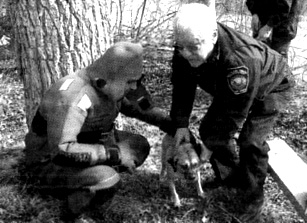 the
Belchers Creek last ice last Wednesday afternoon. The officers
were trining in recovery and ice rescue when they were called
to the scene to rescue Snickers, a two-year-old brown Puggle. the
Belchers Creek last ice last Wednesday afternoon. The officers
were trining in recovery and ice rescue when they were called
to the scene to rescue Snickers, a two-year-old brown Puggle.
Police
received a 12:22 pm report that a Dog fell through the ice
on Belchers Creek. The Dog's owner, Heather Chapman of Prescott
Ave., pointed out Snickers, who was treading water. Officer
James DeVore responded.
The Special Operations
Unit was training at Moosehead Marina on Greenwood Lake using
dry dive suits and ice rescue suits. The unit is traind in
underwater recovery and ice rescue.
Officer Greg Post, with the assistance
of Sgt. Tom Celano, Offiter Joe Nevin and Officer George Richnavsky,
was able to enter the creek and retrieve Snickers from the
water about 15 minutes after the Dog fell through. Greenwood
Forest Fire Co. assisted..
Animal Control Officer Beverly Lubji
transported Snickers to the Greenwood Lake Animal Hospital
for evaluation. The Dog was uninjured but suffering from hypothermia.
According to police, Snickers is expected to fully recover.
Because of the number of lakes in
West Milford, emergency services departments throughout the
community carry ice rescue apparatus and train in ice recovery.
Photo:
WM Police Officer Gregory Post (left) and WM Fire Inspector
Fred Stewart pet Snickers after the Dog was rescued from Belchers
Creek last week.
|

Weird
but True
Lukas Alpert
February
19, 2009
A
baby boy in India was married to a neighbour's Dog after the
child grew a tooth out of his upper gum which members of his
tribe believe is a bad omes making him prone to attacks from
wild animals.
"It
will overcome any curse that might fall on the child as well
a on us," said his father.
|

MICKEY'S 'TAIL' OF TRAGEDY
LOVED CHIHUAHUA DEAD AT 17
By DAVID K. L I
February
19, 2009
Mickey Rourke's favorite pooch - which the actor called the
love of his life - died this week after seeing  her
master go from Hollywood has-been to Oscar front- runner. her
master go from Hollywood has-been to Oscar front- runner.
Loki the Chihuahua passed away at age 17 on Monday, a week before
Rourke's scheduled appearance at the Academy Awards in Los An
geles, where he might pick up the Oscar for Best Actor for his
role in "The Wrestler."
A downcast Rourke had lunch yesterday at Nello on Madison Avenue,
where he ran into fellow actor James Woods and they commiserated
about Rourke's loss, according to The Hampton Sheet magazine.
"She was my life," Rourke was overheard telling Woods
about the pet.
Rourke - the toast of Tinsel town for his off-the-mats perform
ance as a washed-up grappler - showed Woods a chain worn around
his waist. On it is a pen dant with Loki's picture.
"Mickey is heartbroken," Woods told the magazine.
In a prepared statement, the dog- loving actor said he's thankful
for Loki's 17 years: "Loki is deeply missed but with me
in spirit. I am very blessed she fell asleep peace fully in
my arms."
Rourke, 56, is one of Hollywood's best-known dog lovers, and
worked with People for the Ethical Treatment of Animals this
year in a campaign urging spaying and neutering.
The small brown Chihuahua was a frequent Rourke travel partner,
and in recent months, the Hollywood hell-raiser said he wanted
her by his side as much as possible, knowing the aging pooch's
days were numbered.
"You could see he had genuine love for Loki, a kind of
love you don't always see between two people," said PETA
special-projects manager Michelle Cho, who teamed with Rourke
in a 2007 campaign against puppy mills in Florida.
Restaurant operator and Rourke pal Nello Balan said Loki came
into the actor's life on the downside of his career, but loved
her master unconditionally.
"She followed his ups and down, like a member of the family,"
Balan said.
"She loved my carpaccio," Balan added. "The only
time she'd bark is when she'd be defensive of Mickey, especially
when girls came around. She'd bark then."
Rourke is considered a favorite to go home with an Oscar Sunday,
having won the British Academy and Golden Globe awards - where
he thanked his dogs "present and the ones that aren't here
anymore."
Rourke has explained that his fondness for small dogs is tied
directly to their longer life spans. He admitted falling into
deep depression in 2002 when Loki's dad, Beau Jack, died. |
 MICKEY
ROURKE'S CHIHUAHUA DIES IN HIS ARMS
MICKEY
ROURKE'S CHIHUAHUA DIES IN HIS ARMS
February
18, 2009
 Mickey Rourke is headed to the Academy Awards both as a nominee
and a grieving pet owner after the death of his 17-year-old
Chihuahua, Loki.
Mickey Rourke is headed to the Academy Awards both as a nominee
and a grieving pet owner after the death of his 17-year-old
Chihuahua, Loki.
A representative for Rourke, Judy Woloshen, said the actor's
beloved dog died Monday night.
Says Rourke: "Loki is deeply missed but with me in spirit.
I feel very blessed that she fell asleep peacefully in my arms."
Rourke, who's having a career comeback with his acclaimed performance
in "The Wrestler," was especially close to Loki and
is a longtime owner of chihuahuas.
Rourke thanked all his dogs - living and dead - after winning
the Golden Globe for best actor last month, saying "sometimes
when a man's alone, all you got is your dog." |

Weird
but True
Lukas Alpert
February
12, 2009
Quick, to the barkmobile!
Pottsboro, Texas, authorities found a woman living in a station
wagonwith 22 Dogs.
"The car was soaked with urine and covered in feces,"
SPCA official Courtney Stevens said.
Police said the woman would not face charges, as she was
incoherent. She was turned over to adult protective services.
|
 TAIL
OF JUSTICE IN DOG KILLING
TAIL
OF JUSTICE IN DOG KILLING
By LAURA ITALIANO
February
12, 2009
A
Manhattan man was sentenced to six days in jail yesterday for
fatally kicking his roommate's Boston 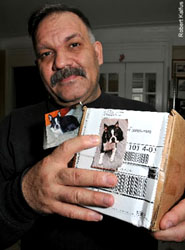 terrier
- and the dead dog was there for the proceeding. terrier
- and the dead dog was there for the proceeding.
"I brought Sasha so she would know that she was vindicated,"
bereft pet owner Teddy Bonaros sobbed after court, carrying
a bag containing the pooch's ashes in a brown carton.
With good behavior, killer Tufik Habib, a 40-year-old banker,
will be released today, since the days he already spent in jail
on the case counts in his favor.
Prosecutors say the callous brute bashed the tiny terrier's
head in with his foot and an umbrella in January 2008 in Bonaros'
Washington Heights apartment.
At yesterday's sentencing, Bonaros, a former travel-agency owner,
tearfully lit into Habib in an emotional victim impact statement,
calling him, in turn, a murderer, a deadbeat, a pervert, a liar,
a con artist, and "a heartless son of a bitch. I curse
and condemn you, Tufik, from the second you go into jail until
the last breath you take," railed Bonaros.
He noted that Sasha was nursing five puppies at the time she
died, and that the puppies' sire, Rocky, died "of a broken
heart."
"May you always suffer with pain, loneliness and poverty,"
Bonaros shouted.
Bonaros didn't pull the ashes out during his statement, but
Sasha's remains were there with him, boxed inside the bag, which
was slung over his shoulder.
Bonaros had met Habib through a roommate search Web site.
Habib pleaded guilty last November to misdemeanor animal cruelty
and has served 175 hours of community service.
Δ
PHOTO -- GRIEF: Teddy Bonaros holds the ashes of Sasha, who
was fatally kicked, in Manhattan court yesterday.
Photo Credit:
Robert Kalfus
|

NOT
FIT FOR A DOG!
WESTMINSTER CHAMP SNUBS SARDI'S
By AMBER SUTHERLAND and ANDY GELLER
February
12, 2009
Sardi's
has gone to the dogs, so the top dogs are no longer going
to Sardi's, the pets' well-heeled 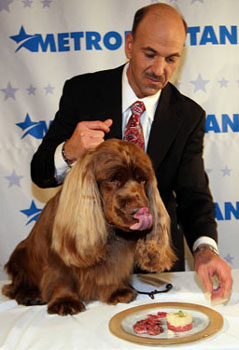 promoters
growled yesterday. promoters
growled yesterday.
The venerable Times Square restaurant has been usurped as
the eatery of choice for the Westminster Kennel Club's Best
in Show, who was instead treated to a celebratory lunch at
Grand Central Terminal's Metrazur.
Those who control the dog-eat-dog world of show dogs said
Sardi's is past its prime and hasn't learned any new tricks.
"Old institutions like Sardi's are crumbling. We're about
the new. Who goes to Sardi's, anyway?" barked Metropolitan
Dog Club President Charlotte Reed, whose group hosts the annual
lunch.
"We're trying to diversify and to make the club younger
and hipper. We want to be more inclusive. We are a salon of
dog thought."
Max Klimavicius, Sardi's owner, was laughing out loud at the
snub. "We're certainly not crumbling," he said.
"Sardi's has been a very popular theater spot for 80
years." Last year, the kennel club chose Cipriani Dolci
in Grand Central for its lunch - although the winner also
chomped a steak at Sardi's.
Metrazur, on Grand Central's East Balcony, "is what the
dog world is about now," said Reed.
Taking center stage - actually a table - was Stump, the Sussex
spaniel who, at age 10, is the oldest dog ever to win Best
in Show in the competition's 133-year history. He sat patiently
on his hind legs while photographers fired away.
Then, a gold-rimmed platter appeared. On it was a 10-ounce
flatiron steak, a shoulder cut that is $27 on the restaurant's
menu. It was lovingly cooked medium rare by Metrazur's chef,
Stefan Barh, who calls himself more of a cat person. "My
cat wouldn't appreciate me making steak for a dog. I'll bring
her home some tuna," he said.
"I don't usually feed dogs. But Stump is a champion.
Stump is like all our other VIP customers."
In view of Stump's advanced age - he is 70 in human years
- Barh sliced the steak into fine pieces, and the top dog
made short work of it. Then he went back to sitting patiently
to pose for dog fanciers, who paid up to $125 to attend.
"He is a wonderful example of what you want in that breed,"
said judge Sari Tietjen, who named Stump the Best in Show.
"I didn't know who he was or how old he is. I hope we
all age as well as he has.
"He showed his heart out. I thought his overall attitude
said, 'This is me, this is my night and I'm the star.' "
Δ
CHOW HOUND: Stump, with handler Scott Sommer, licks
his lips for Metrazur steak yesterday.
Photo Credit:
Chad Rachman
|

10-Year-Old
Spaniel Completes Comeback
By KATIE THOMAS
Richard
Sandomir contributed reporting.
February
11, 2009
At 10 years old, Stump the Sussex spaniel should be well into
his dotage. Instead, the dog who 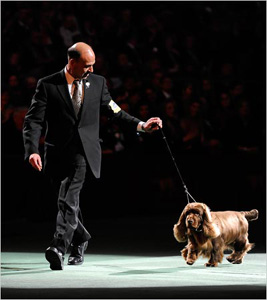 technically
retired four years ago took home Best in Show on Tuesday at
the 133rd Annual Westminster Kennel Club show at Madison Square
Garden, becoming the oldest to win the award. technically
retired four years ago took home Best in Show on Tuesday at
the 133rd Annual Westminster Kennel Club show at Madison Square
Garden, becoming the oldest to win the award.
Stump, officially named Ch. Clussexx Three D Grinchy Glee,
might have surprised aficionados, who had their eye on a giant
schnauzer, but the crowd clearly preferred the jaunty spaniel.
Stump was greeted with deafening applause each time he plodded
around the ring.
It was the first time that a Sussex spaniel won the top prize,
although the breed, which originated as a hunting companion
in England, was among the first to be recognized by the American
Kennel Club.
Judge Sari Brewster Tietjen said she made her decision at
the last minute.
“I didn’t know who he was or how old he was,”
Tietjen said. “He’s just everything that you’d
want in the breed, and I couldn’t say no to him.”
Stump won the sporting group at Westminster in 2004, but in
early 2005 fell seriously ill with an undetermined sickness,
said Scott Sommer, Stump’s handler and an owner along
with Cecilia Ruggles and Beth Dowd.
Stump eventually returned to health, and by last year he was
looking quite good. Still, Sommer said he was not sure until
last Wednesday that he would definitely show Stump at Westminster.
“I wanted to take him here and hope he showed good,”
Sommer said after winning the group. “That was my goal.”
The night brought to a close the reign of Uno, the beagle
who went from being a humble hound to canine celebrity last
year after becoming the first in his breed to win Best in
Show. Uno spent the past year on a tour of the country, visiting
the White House, riding on a Peanuts float at the Macys Thanksgiving
Day parade, and even lighting the Empire State Building on
Monday in Westminster’s signature colors of purple and
gold.
Uno ceded his crown to another workaday dog, a spaniel who
spends most of his time sleeping in Sommer’s bed in
Houston “between the sheets.” Stump competes for
space there with J. R., a bichon frisé who won Best
in Show at Westminster in 2001 with Sommer.
Sommer said he did little to prepare Stump for his big night,
barely even walking him around the driveway to see if he was
show ready.
Sussex spaniels are a rare breed with a small gene pool, Sommer
said. According to their breed standard, the dog should have
a “cheerful and tractable disposition.” Stump’s
merry gait is also in keeping with his breed: the standard
describes a rolling gait that is charitably described as deliberate
but not clumsy.
According to American Kennel Club statistics, Sussex spaniels
are less common than 144 other breeds. Stump’s victory
edges out Ch. Loteki Supernatural Being, an 8-year-old papillon
who won Best in Show in 1999, for oldest winner.
Another favorite of the night was Spirit, a giant schnauzer
who was the top-ranked dog in the country last year and who
won her working group only moments before entering the Best
in Show ring.
Other dogs competing in Best in Show were a standard poodle,
a Scottish terrier, a puli, a Brussels griffon and a Scottish
deerhound.
Despite Stump’s charisma, Sommer hinted that the dog
was unlikely to replicate Uno’s demanding travel schedule.
And at his age, who can blame him?
“Stump’s going to travel back to Houston and kind
of stay there,” Sommer said. “He doesn’t
travel that much.”
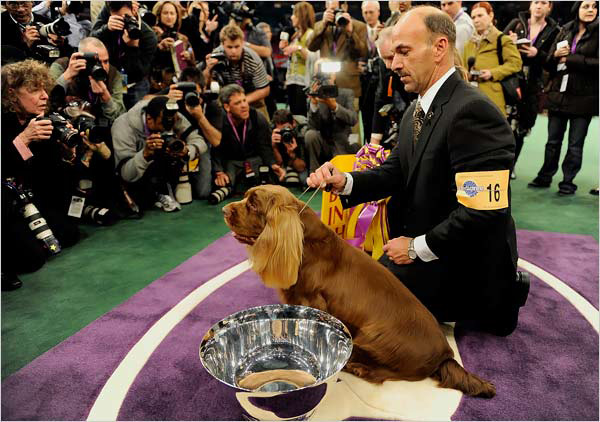
Stump with handler Scott Sommer. Photo Credits: Barton Silverman/The
New York Times

The
Stump Theory
By GAIL COLLINS
Op-Ed
Columnist
February 12, 2009
On Tuesday, a 10-year-old Sussex spaniel named Stump won Best
in Show at the Westminster Kennel  Club,
becoming the oldest dog to win the title in the show’s
133-year history. Club,
becoming the oldest dog to win the title in the show’s
133-year history.
Yet
another sign of the emerging trend of 2009:
Old is in.
This is not exactly what we were expecting from the Age of
Obama. When a 47-year-old becomes president by trouncing a
72-year-old opponent, there’s every reason to think
that the tide is turning youthward.
• • •
So
it’s better if we readjust our thinking and start regarding
everybody as 20 years younger than the calendar suggests.
Then you will feel much better when the 80-year-old postman
delivers your mail and it includes a request for money from
your 38-year-old offspring doing post-post-post-doctoral work
at Ohio State.
At least this will be good news for anybody under the age
of 40 who gets into a jam. If the Olympic swimmer Michael
Phelps and the Yankee slugger Alex Rodriguez have drug issues,
who cares? In the new adjusted way of viewing the country,
Phelps is just a toddler and Rodriguez is barely in puberty.
And in their place, we have Stump. You may have missed his
great star turn on Tuesday night. Strangely, the Westminster
Kennel Club Dog Show does not get as much attention as, say,
the Super Bowl, even though there are way more Americans who
own dogs than play football. Perhaps if Bruce Springsteen
(59) had done a half-time show at Westminster involving huge
amounts of jumping around and a crotch-first slide into the
camera, things would be different.
Stump, whose hobbies are sleeping and sleeping, is actually
Champion Clussexx Three D Grinchy Glee, but nobody his age
can remember all that. After a refreshing workout that involved
a short walk around the driveway, he trotted onto the stage
and wiped the floor with his younger competition, the most
notable of which was a poodle that was conceived with the
25-year-old semen of a long-dead champion named Snapper.
Stump would be around 70 in human years, but Snapper —
wow. Even given the fact that it was frozen, Snapper’s
seed has to have been the equivalent of at least 150.
Click
√
on Stump
Image
for full article

Keeping
Championship Bloodlines Alive
By KATIE THOMAS
February
11, 2009
Every time Tim Brazier leads his dog Yes into the ring, he
can’t help thinking of Snapper, another 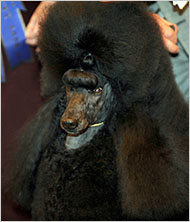 champion
black standard poodle. champion
black standard poodle.
Yes, a standard poodle who won the nonsporting group Monday
at the Westminster Kennel Club Dog Show, is a product of artificial
insemination that used 25-year-old frozen sperm.
“It’s a trip down memory lane,” said Brazier,
who won the nonsporting group with Yes, or Ch. Randenn Tristar
Affirmation, at the Westminster Kennel Club Dog Show on Monday.
Yes, a daughter of Snapper, or Ch. Eaton Affirmed, shares
her father’s sashay as well as his fluid movement and
balance.
“And the little personal quirks, too, like cocking her
head to the side, like he always did,” Brazier said.
Like father, like daughter, with a twist: Snapper died in
1990, 13 years before Yes was born. She was conceived using
25-year-old frozen sperm from Snapper, who sired more than
100 champions in his lifetime.
Yes’s story is considered unusual because of the age
of the specimen and her extraordinary success as a show dog.
But frozen semen has been used for decades by breeders who
want to inject a dash of nostalgia into a litter of puppies.
Click
√
on Image
for full article
Photo
Credits: Barton Silverman/The New York Times
|

Vicktory dog goes home!
by David Dickson
February
6, 2009
The first Vicktory dog has gone home! How’s that for
a statement worth shouting from the rooftops? 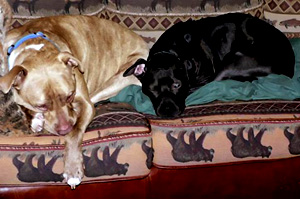 This
is one happy ending a long, long time in the making. This
is one happy ending a long, long time in the making.
When Traci first heard about the Vicktory dogs, her heart
went out to them. She couldn’t believe all they had
been forced to live through. The one thing she knew for certain
was that they deserved better. They deserved a home full of
love and kindness. She wanted to be one of those homes. "If
I could," she says, "I would have given every one
of them a good home."
There was one setback, though. The Vicktory dogs were still
a long way from looking for homes. First, they had quite the
recovery ahead of them at the sanctuary. It would be a long
wait to adopt one, with no guarantees, but Traci still wanted
to be considered.
Then something happened. A big, goofy lovable pit bull named
Tacoma came to Best Friends from a shelter. Tacoma is as friendly
as a puppy. He even did a stint as office dog at the Best
Friends clinic. Aside from knocking over all the furniture
and thoroughly licking everybody who strayed close enough,
he excelled as an office dog.
The adoption folks contacted Traci and told her about Tacoma.
He, too, needed a home. Would she consider him? She took one
look—and was hooked. Traci adopted Tacoma and they’ve
been best pals ever since.
But she never stopped thinking about the Vicktory dogs. When
the time came for several of the Vicktory dogs to get ready
for homes, Traci still wanted to be considered. She and Tacoma
felt it was time to welcome a friend.
It was a tough adoption process -- there a lot of special
requirements for being able to adopt one of these special
needs dogs. But after the adoption staffers approved Traci,
she was thrilled! She had only one request: "Pick the
dog you think will get along best with Tacoma."
Boy, did they knock this one out of the park. They chose Halle,
a sweet, bashful girl who used to be afraid of her own shadow.
When Halle first came to Best Friends, she was terrified of
everything, everywhere. The whole world was one big threat.
With all the help and constant TLC from her caregivers and
friends, however, she’s come a long way and overcome
so many fears. Even so, Halle still has confidence issues.
Tacoma, on the other hand, is the kind of guy with enough
confidence to bet the house on a pair of deuces in a poker
game. This guy wouldn’t know how to act bashful on a
dare.
When these two met, it was a cosmic case of love at first
sight. They romped and played together and never had a moment’s
trouble. In fact, they snuggled side by side on the bed with
Traci during the initial sleepover. Talk about a deal-clincher!
Traci and Tacoma took Halle home.
However, Traci can’t officially adopt Halle quite yet.
The Vicktory dogs came to Best Friends with specific legal
requirements, one of which is a six-month foster period before
adoption. Still, if the first week of fostering is any indication,
it looks like Halle has found her forever home.
She follows Tacoma around every minute and he’s equally
smitten with her. They are inseparable in every sense of the
word. Traci says that Halle is still a tad coy around new
faces, but she doesn’t duck for cover or anything. Besides,
every day she spends with Tacoma she absorbs a little of his
confidence. And Traci couldn’t be more thrilled to have
her around. "She has the sweetest, most innocent-looking
face," she says about Halle.
So for now, it’s one big trial run. But with all the
obstacles Halle has overcome so far, a six-month waiting period
should be a cinch. Congrats to Halle, Tacoma, and Traci. It’s
a happy-ever-after most certainly worth waiting for.
Photo
of Halle and Tacoma courtesy of Traci
|

New
World Wolves and Coyotes Owe Debt to Dogs
Researchers have determined that black-coated
wolves, like these in Yellowstone National Park, got their
distinctive color from dogs.
By MARK DERR
February
6, 2009
In a bit of genetic sleuthing, a team of researchers has determined
that black wolves and coyotes in North America got their distinctive
color from dogs that carried a gene mutation to the New World.
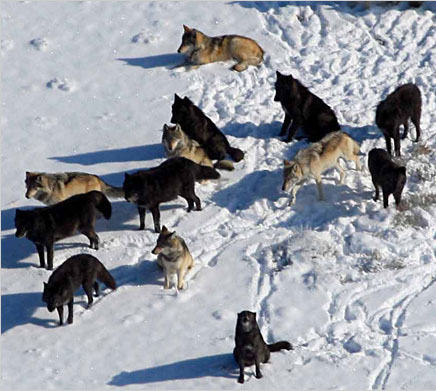
The finding presents a rare instance in which a genetic mutation
from a domesticated animal has benefited wild animals by enriching
their “genetic legacy,” the scientists write in
Thursday’s Science Express,
the online edition of the journal Science. Because black wolves
are more common in forested areas than on the tundra, the
researchers concluded that melanism — the pigmentation
that resulted from the mutation — must give those animals
an adaptive advantage.
Although common in many species, melanism in dogs follows
a unique genetic pathway, said Dr. Gregory S. Barsh, a professor
of genetics and pediatrics at the Stanford University School
of Medicine and the senior author of the paper.
Last year, Dr. Barsh and his laboratory identified a gene
mutation responsible for the protein beta-defensin 3, which
regulates melanism in dogs. After finding that the same mutation
was responsible for black wolves and black coyotes in North
America, and for black wolves from the Italian Apennines where
wolves have recently hybridized with free-ranging dogs, the
researchers set out to discover where and when the mutation
evolved.
Photo:
Daniel Stahler/Associated Press
SCIENCE
EXPRESS: Molecular and Evolutionary History of Melanism
in North American Gray Wolves
Click  √
√
Click
√
on NYTimes
BANNER for full article
|
Daily
Herald-Tribune
Passing
of Service Dogs Act applauded
CHRISTOPHER MILLS - Herald-Tribune staff
Posted
5 February 2009
Grande
Prairie, Alberta CA - That’s
one small step for man, one giant leap for service dogs.
The Alberta government recently passed the Service Dogs Act,
which enables those with disabilities who use qualified service
dogs to access any public place in the province.
Since the passing of the Blind Persons’ Rights Act in
2007, guide dogs have been allowed in all public venues, but
service dogs do more than act as eyes for the visually impaired.
They also help people with illnesses such as epilepsy and
diabetes with things like every day tasks, carrying and retrieving
items, providing balance and stability, or responding to seizures
or diabetic episodes.
Now, all types of services dogs will be extended the same
benefits.
According to the province, there are approximately 130 guide
dogs for visually impaired persons in the province right now,
which will initially leave less than 100 qualified service
dogs for people with other types of disabilities.
Connor Warkentin, a nine-year-old Grande Prairie boy with
autism, has been using his service dog Duncan for more than
three years. Connor uses the dog because his autism keeps
him from perceiving danger or understanding fear, his mother
Gayle said.
“He does not realize that there is danger out there,”
she said. “The dog keeps him safe whenever he’s
in a public place. It’s a safety element we do not have
if we don’t have the dog.”
The Warkentins got the yellow Labrador from National Service
Dogs in Cambridge, Ont.
Click
√
on HEADLINE for full article
|

Arkansas
animal cruelty bill signed into law
By ANDREW DeMILLO, Associated Press
Thu Feb 5,
2009
LITTLE ROCK, Ark. – Gov. Mike Beebe has signed into
law new animal-cruelty restrictions that make aggravated cruelty
to cats, dogs and horses a felony on the first offense.
The new law, which also makes cockfighting a penalty, comes
after previous attempts to stiffen animal-cruelty restrictions
had faltered over arguments between animal welfare groups
and hunters and farmers.
"I became convinced that a first-offense felony was appropriate
for the definitions in the bill," Beebe said Wednesday
at a bill-signing ceremony.
"They satisfied me that it wasn't going to be used for
things that were discussed as extreme and the language was
there and protected to ensure that. I don't know who could
argue against it."
Arkansas becomes the 46th state to make cruelty to animals
a felony, according to the Humane Society of the United States.
Click
√
on HEADLINE for full article
|
Houston
Chronicle
Sniffing
out a trail
Private investigator specializes in furry friends,
saying the key to finding lost dogs is understanding how canines
think
By RICHARD STEWART
Feb.
3, 2009
A pampered Dachshund named Dazzle slips under a backyard fence
in Pearland and scampers off for an adventure as fast as her
short legs can take her.
And now she’s a lost dog with her frantic owner Gerry
Thornton looking everywhere.
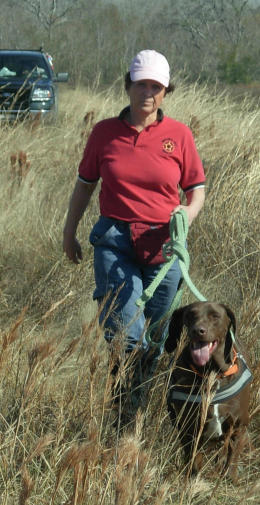 Enter
pet detective Karin TarQwyn. She is one of the few licensed
private detectives in the country who specializes in finding
lost dogs. In the four years in the business, she’s
been involved in more than 1,500 cases. Enter
pet detective Karin TarQwyn. She is one of the few licensed
private detectives in the country who specializes in finding
lost dogs. In the four years in the business, she’s
been involved in more than 1,500 cases.
She does it, she says, by knowing how dogs think — and
they don’t always think like their human companions
believe they do.
Dazzle spent most of her five years on the show circuit under
the name Got 2 B Dazzling, having her long red coat brushed
and her every need taken care of. But TarQwyn said that beneath
Dazzle’s pampered exterior beats the heart of the hunting
dog of her ancestors. Once she got too far away from home
to find her way back, her instincts took over and she began
to look for her own food.
TarQwyn started Dazzle’s case like she always does,
interviewing Thornton on the telephone and drawing up the
dog’s profile. She then poured over maps and satellite
photos to try to predict where Dazzle may have gone since
her disappearance on Jan. 6.
TarQwyn took Thornton’s case late last week. “Many
cases are just handled over the telephone,” she said
in an interview from her ranch near Bristow, Okla.
Last week she loaded up her crew of real experts — a
set of tracking dogs that range from Cade the big Labrador
to Paco the Chihuahua — and headed to Pearland.
“A big part of the job is being a dog handler,”
TarQwyn said.
Click
√
on HEADLINE for full article
|
Youngstown
Vindicator
Youngstown
officials seek tougher state penalties for animal cruelty
Sunday, February 1, 2009
YOUNGSTOWN — The mayor and city prosecutor have asked two
state representatives to introduce legislation that would elevate
certain acts of animal cruelty to a felony charge.
In a letter to Robert F. Hagan of Youngstown, D-60th, and Ronald
V. Gerberry of Austintown, D-59th, Mayor Jay Williams and City
Prosecutor Jay Macejko cite the need for legislation to bring
Ohio in line with 45 other states that define certain acts of
animal cruelty as a felony or provide felony-level penalties even
though an offense is not specifically defined as a felony.
“Sadly, Ohio is in the minority that only provides misdemeanor
penalties regardless of the extent of the cruelty,” Macejko
said in the letter. He said the goal of bringing Ohio in line
with the vast majority of the country could be accomplished by
amending the penalty section of the current law.
The letter gives a synopsis of what happened at High Caliber K-9,
a kennel that operated on Coitsville-Hubbard Road until October
when seven dead and 12 starving dogs were found on the property.
Steve Croley, the operator, reached a plea agreement and pleaded
guilty to four misdemeanor counts of animal cruelty and began
serving a four-month jail sentence Jan. 23.
Macejko noted in the letter that Croley did not face 19 counts
due to legal missteps on the part of Animal Charity humane agents.
He said the agents who entered the property took the necessary
moral, but not the necessary legal, action.
“To be blunt, misdemeanor penalties are not enough for what
happened here, regardless of the number of offenses,” Macejko
wrote. “The macabre suffering that happened at High Caliber
in late October is almost beyond comprehension.”
He said limiting the felony charge to situations where animals
die and to businesses that provide kenneling of animals would
provide prosecutors “the tools necessary to punish these
nefarious deeds.”
The penalty now for first-degree misdemeanor animal cruelty is
up to six months in jail. If a fifth-degree felony is added to
the law, the penalty would be six months to one year in prison.
|
 Metropolitan
Diary
February 2,
2009
Dear
Diary:
Metropolitan
Diary
February 2,
2009
Dear
Diary:
I was standing inside the entrance of the Union Square Petco recently
when an English bulldog mix and his owner walked into the store.
With great conviction and not a second’s hesitation, the
dog yanked a stuffed toy off an enormous rack of toys lining the
wall just a few feet from the door.
“Well, I guess we’ll take this one,” his owner
said.
At the check-out counter the cashier tried to persuade the dog
to drop the toy momentarily by offering him a cookie, but no go.
I commented to a Petco employee standing nearby, “That dog
knew exactly which one he wanted without even browsing.”
The employee responded nonchalantly, “Oh, he was in here
earlier today and kept staring at that duck.”
Together the pet’s owner and his great macho bulldog, a
stuffed mallard wearing a Christmas hat clenched proudly in his
mouth, made their way back out into the wintry night.
Eileen Elliott |

Brooklyn Man Arrested for Animal Cruelty
January
30, 2009.
On October 30, a three-year-old poodle named Cuddles was brought
by his caretaker to the ASPCA’s  Bergh
Memorial Animal Hospital as an emergency walk-in. Veterinarians
discovered injuries to the male dog’s face, left eye,
right side and back. After receiving medical treatment, Cuddles
was reunited with his owner. Bergh
Memorial Animal Hospital as an emergency walk-in. Veterinarians
discovered injuries to the male dog’s face, left eye,
right side and back. After receiving medical treatment, Cuddles
was reunited with his owner.
Following an investigation, ASPCA Humane Law Enforcement agents
arrested Brooklynite Donauld Soleil, a 19-year-old acquaintance
of the dog’s owner, in late December. He has been charged
with one count of misdemeanor animal cruelty for allegedly causing
the dog's injuries, and faces up to one year in jail and a $1,000
fine.
If you know of an animal who is being hurt, please report it—those
who intentionally hurt animals often move on to abuse the people
in their lives, too. To report animal cruelty in New York City,
contact the ASPCA’s anonymous tip line at (877) THE-ASPCA.
Visit our Report
Cruelty FAQ to learn how to report cruelty elsewhere.
• • •
SPECIAL
ANNOUNCEMENT
Get Your Degree in Animal CSI: New ASPCA Program
Offered at University of Florida
We are thrilled to
announce the launch of the ASPCA
Veterinary Forensic Sciences program in partnership with the
University of Florida. With expected course offerings
to include Animal Crime Scene Processing, Forensic Entomology
and Bloodstain Analysis, the program will provide students with
the expertise to solve crimes against animals. Both undergraduate
and graduate programs will be offered, as well as continuing
education programs for veterinarians, law enforcement, animal
control officers and attorneys.
“The ability to offer a joint forensic science and veterinary
medicine education at the Bachelor and Master’s levels
is unprecedented,” says the ASPCA’s Dr. Melinda
Merck, Senior Director, Veterinary Forensics. “We’re
excited to have the opportunity to collaborate with the University
of Florida and to create a program that can provide ‘one-stop
shopping’ for agencies and individuals.” Stay tuned
for details regarding the development of the program.
|

Access-ible
by Cathy Scott
January 29,
2009
Actress
Katherine Heigl, along
with Best Friends staff and volunteers, is hitting broadcast
news in a big way by 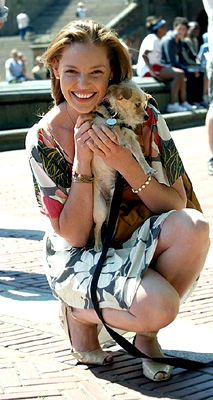 appearing
on Access Hollywood. And it's all about the animals' little
ones. appearing
on Access Hollywood. And it's all about the animals' little
ones.
The popular TV entertainment news show is featuring the rescue
and transfer of 33 small dogs who were saved Monday from overcrowded
Los Angeles animal shelters.
The dogs left Los Angeles Tuesday morning for new homes in Salt
Lake City, thanks to Best Friends' Pup My Ride program, and
a crew from Access Hollywood was there to film the first leg
of the dogs' ride to their new homes.
Heigl, who co-stars in the TV show Grey's Anatomy, was there
with her mother, Nancy, and Best Friends staff and volunteers,
who all worked together to make the rescue and transport possible.
To top it off, the Heigls are giving Best Friends a grant to
carry the program through 2009, so even more animals can be
saved.
Pup My Ride, part of Best Friends' Puppies Aren't Products nationwide
campaign, in 2008 saved 650 at-risk, small-breed dogs from Los
Angeles shelters. The dogs were transported to communities where
the demand for small dogs is high but the supply is low.
Pup My Ride works hand-in-paw with A Puppy-Store-Free L.A.,
another Best Friends program focused on reaching the goal of
No More Homeless Pets, says Kate Schnepel, associate director
of Best Friends' Community Programs and Services.
And the program is fast making a dent in the problem of discarded
pets sent to already overwhelmed and understaffed municipal
shelters.
"Robin Harmon and her volunteers pulled off another fantastic
transport this morning," says Elizabeth Oreck, manager
of Best Friends' Los Angeles programs, "and we were privileged
to have Katherine and her mother, Nancy Heigl, there."
• • •
New
Georgia Law Continues to Crack Down on Dog Fighting
By Cheri Moon, Best Friends staff
January 29,
2009
Before
2008, only one person had been incarcerated for dog fighting
in Georgia. Considering the state had one of the weakest dog-fighting
laws in the nation, that's no compliment. But since a new and
tougher dog fighting law was passed in May 2008, multiple arrests
have been made, with more on the horizon.
Most Recent Arrest in Floyd County
Dominique Ladell Porter of Floyd County, GA is the most recent
criminal to add his name to the growing roster of dog fighting
arrests. Porter has been charged with six felony counts of dog
fighting and six misdemeanor counts of animal cruelty .
Animal control inspected Porter's property after they were alerted
to the situation by an investigator for the Humane Society.
Officers confiscated six American pit bull terriers in late
December because the dogs were emaciated, in very poor health
and exhibited scarring and injuries consistent with dogs that
have been used for fighting. Animal control then contacted the
Floyd county police department who investigated the case and
found sufficient evidence to make an arrest.
Law Targets Dog-Fighting Lifestyle
Georgia's new dog fighting law makes it a felony to train, transport,
sell or own a fighting dog, or to advertise, promote or bet
on fights. A first conviction means one to five years in prison,
a fine of at least $5,000, or both. The law also makes attending
a dog fight a high and aggravated misdemeanor on the first offense,
a felony on subsequent ones.
These new standards make Georgia a role model in the plight
against organized dog-fighting. In addition to stricter consequences,
a key component of the new law is that it targets the people
whose lifestyles often include organizing or attending dog fights.
Best Friends worked closely with State Senator Chip Rogers since
2004 to see this law enacted. The team wanted the law to target
not only fighting-dog owners, but anyone who participated in
any aspect of dog fighting.
 Best
Friends worked diligently to garner the support of Georgia residents
for the new and tougher law. The "End GA Dog Fighting Campaign"
utilized petitions, member messages and even a PSA
featuring Willie Nelson to educate the public about
dog fighting and the need for tougher laws. Best
Friends worked diligently to garner the support of Georgia residents
for the new and tougher law. The "End GA Dog Fighting Campaign"
utilized petitions, member messages and even a PSA
featuring Willie Nelson to educate the public about
dog fighting and the need for tougher laws.
Continuing Public Education and Officer Training
Says Best Friends employee Nikki Sharp, "Even though we
worked tirelessly to see this bill come to fruition, our work
is far from over. You can't just pass a law, then step away
from it."
Best Friends continues to support Georgia's new law through
education campaigns that inform residents about the law and
it's more stringent penalties. In addition, Best Friends is
training judges, prosecutors and enforcement officers on how
to effectively implement the law.
The Humane Society of the United States is aiding in the crack
down of dog fighting across the nation by offering up to $5,000
for information leading to the arrest and conviction of anyone
involved in animal fighting.
Unknown Future For GA Confiscated Dogs
The six dogs taken from the Porter property are being held at
Floyd county animal control and have received treatment for
their wounds and health problems. The future for these dogs
is yet to be determined by local officials.
Says Sharp, "Because of dog fighting, people have a negative
image of pit bulls. Pit bulls and bully breeds are filling shelters
across the nation—where most of them are euthanized. That
needs to stop." She adds, "Cracking down on dog fighting
is a vital step in saving thousands of innocent dogs."
You Can Make A Difference!
You can help end breed discrimination by aiding in the battle
against dog fighting.
Report dog fighting or your suspicions to the Humane Society
of the United States’ toll-free tip line at 877-847-4787.
Keep your community safe with 10
things to do if you suspect dog fighting
.

|

Man
Wanted on Dogfighting, Theft Charges
Jan. 29,
2009
HOUSTON
- A man has been accused of attending dogfights and selling
stolen property, KPRC Local 2  reported
Thursday. reported
Thursday.
Crime Stoppers officials said Tracy Taljouri Rosenthal went
to at least three dogfights that undercover officers monitored.
Investigators said that before a dogfight on Aug. 16, Rosenthal
and another person approached two undercover officers and asked
them if they wanted to buy a stolen jet ski. The officers bought
it on Aug. 18 and confirmed that it was stolen in Baton Rouge,
La.
Rosenthal, 25, has been charged with misdemeanor dogfighting
for attending dogfights and felony theft. Two warrants have
been issued for his arrest.
Anyone with information about Rosenthal's whereabouts is asked
to call Crime Stoppers at 713-222-TIPS.
Man
Wanted in Dog's Death
Jan. 28,
2009
HOUSTON
- A man is wanted on animal cruelty charges, KPRC Local 2 reported
Wednesday.
Crime Stoppers officials said a woman asked Arturo Corona Aguilar
if he had seen her Pomeranian dog on Christmas Eve 2007.
Investigators said Aguilar, 42, pointed to a yard and told the
woman, "It'll be OK. I didn't hit him that hard."
The woman and her daughter went into the yard and found the
dog unconscious and bleeding from a large open wound to its
head. The dog died from its injuries.
A neighbor told police that she had seen Aguilar walking down
the 14900 block of Pine Warbler Lane with an ax in his hand.
She told detectives that she saw him swing the ax to the ground
and she heard a loud yelp from the area he struck.
Aguilar was indicted in January 2008 on a charge of cruelty
to an animal and a warrant was issued for his arrest.
Aguilar is Hispanic, 5 feet 4 inches tall and about 200 pounds.
A $5,000 reward was offered for information leading to Aguilar's
arrest. Anyone with information on his whereabouts is asked
to call Crime Stoppers at 713-222-TIPS.
|

A
Florida couple has spent more than £100,000 on a clone of
their deceased pet Labrador.
Wednesday
January 28, 2009
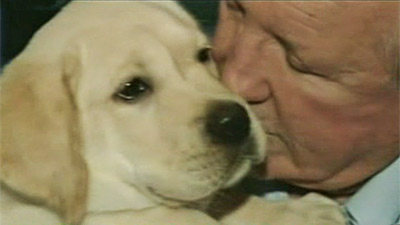
The
Ottos hope Lancelot Encore shares some of the late Lancelot's
traits
Lancelot
Encore is a clone of Ed and Nina Otto's late dog Lancelot, who
died of cancer in January 2008. The Ottos, who could not bear
life without their beloved dog, placed a £108,000 bid on
a biotech firm's dog-cloning auction last July.
BioArts International created Lancelot Encore in South Korea,
where he was born ten weeks ago.He's back with me. As much as
you could probably expect to ever get back someone who died.
Cloned dog owner Nina Otto
The Ottos say he is the first single-birth, commercially-cloned
puppy in the United States.
"This is Sir Lancelot, as he was, when he was nice and healthy,"
said Nina Otto, "probably around the time that we actually
took his DNA and froze it.
"I know that to a lot of people spending that much money
is ridiculous. I've heard some of my friends say 'On a dog?',
but it wasn't just a dog. It was Lancelot." The Ottos already
have eight other dogs. But with 12 acres of land they felt they
had more than enough room for another pet.
"Think about how wonderful it is to be able to have your
best friend back with you," Ed Otto said.
"We know he looks identical. We're hoping he has some of
the same traits."
The couple met Lancelot Encore at the airport in Miami, and were
obviously delighted with the result of the cloning process.
"He's back with me," said Nina, "in terms of the
essence of him, as much as you could probably expect to ever get
back someone who died." |

Weird
but True
Lukas Alpert
January
28, 2009
As
if there were't enough reasons to stay away from drugs.
An
English police Dog has died from a rare form of nose cancerthat
may be related to inhaling cocaine and other drugs for years.
"It
is ironic the wonderful organ that made him successful in his
work has been his de,ise," said Inspector Anne HJiggins
of the Avon and Somerset police.
|
 /
Cindy Adams /
Cindy Adams
January 28,
2009
Reader
Martin Newbrief:
If you crossed a Scotch Terrier with a Water Dog, would it be
a Scotch and water Dog? Yeah, good boy, Marty, now sit...stay....
|
 Mayor's
Alliance for NYC's Animals Celebrates Third Annual
Mayor's
Alliance for NYC's Animals Celebrates Third Annual
"I Love NYC Pets" Month with City-Wide
Adoption Events
Tuesday,
January 27, 2009
New York, NY – Tuesday, January 27, 2009 – Warm your
heart with a fuzzy valentine as the Mayor's Alliance for NYC's
Animals® and the city's animal rescue groups celebrate their
month-long pet adoption campaign this February with "I Love
NYC Pets" month. The third annual 2009 celebration includes
numerous adoption events and extended adoption hours at city shelters
— making it more convenient than ever to bring the cat or
dog of your dreams into your family.
Highlights of "I Love NYC Pets" month include special
pet adoption events held over the weekend of February 14 and 15
— just in time for Valentine's Day! KittyKind is also holding
a "KittyKoncert" Memorial the last day of February at
4:00 p.m. at the Jan Hus Presbyterian Church, 351 East 74th Street
(between First and Second Avenues), Manhattan, to celebrate the
love of our pets. For more information or to reserve tickets,
visit the KittyKind website at www.kittykind.org.
A list of Special Adoption Events taking place in February and
regular Animal Shelter Adoption Hours is available at www.ILoveNYCPets.org.
Please note that more events will be added to the February events
listing throughout the month.
Among the organizational partners of "I Love NYC Pets"
month are: American Society for the Prevention of Cruelty to Animals
(ASPCA), Animal Care & Control of New York City, Humane Society
of New York, and the North Shore Animal League. Details on the
month-long celebration and special events and promotions are available
at www.ILoveNYCPets.org. |

Dog
Owners More Likely To Share Germs With Pets By Not Washing Hands
Than By Sleeping With Dog
Jan. 27,
2009
Dog
owners who sleep with their pet or permit licks on the face
are in good company. Surveys show that more than half of owners
bond with their pets in these ways.
Research done by a veterinarian at Kansas State University found
that these dog owners are no more likely to share the same strains
of E. coli bacteria with their pets than are other dog owners.
Dr. Kate Stenske, a clinical assistant professor at K-State's
College of Veterinary Medicine, studied this association as
part of her doctoral research at the University of Tennessee.
The research is scheduled to appear in an upcoming issue of
the American Journal of Veterinary Research.
Stenske said the finding that these human-animal bonding behaviors
aren't more likely to spread germs is good news because there
are physical and psychological benefits of pet ownership.
"I became interested in the topic because there is such
a strong bond between dogs and their owners," Stenske said.
"If you look at one study, 84 percent of people say their
dog is like a child to them."
Stenske said surveys also show that nearly half of all dog owners
share food with their dogs, and more than half allow the dog
to sleep in the bed and lick them on the face.
"We also know diseases can be shared between dogs and people,"
Stenske said. "About 75 percent of emerging diseases are
zoonotic, meaning they are transferrable between humans and
other animals. With these two pieces of knowledge, I wanted
to examine the public health aspects of such activities."
Stenske's study centered on E. coli bacteria, which is common
in the gastrointestinal tracts of both dogs and humans.
"People have it, dogs have it, and it normally doesn't
cause any problems," she said. "But it can acquire
genes to make it antibiotic resistant."
The study examined fecal samples from dogs and their owners
and looked at the bacteria's DNA fingerprints. Stenske found
that 10 percent of dog-human pairs shared the same E. coli strains.
She also found that the E. coli had more resistance to common
antibiotics than expected, although the owners had more multiple-drug
resistant strains than their pets.
"This make us think that dogs are not likely to spread
multiple drug-resistant E. coli to their owners, but perhaps
owners may spread them to their dogs," Stenske said. "What
we learn from this is that antibiotics really do affect the
bacteria within our gastrointestinal tract, and we should only
take them when we really need to -- and always finish the entire
prescription as directed."
 The
research showed that bonding behaviors like sharing the bed
or allowing licks on the face had no association to an increase
in shared E. coli. However, Stenske said the research did show
an association between antibiotic-resistant E. coli and owners
who didn't wash their hands after petting their dogs or before
cooking meals. The
research showed that bonding behaviors like sharing the bed
or allowing licks on the face had no association to an increase
in shared E. coli. However, Stenske said the research did show
an association between antibiotic-resistant E. coli and owners
who didn't wash their hands after petting their dogs or before
cooking meals.
"We should use common sense and practice good general hygiene,"
she said.
Stenske said future research might focus on the relationship
between shared E. coli and the behaviors of cat owners. Not
only is cat ownership higher than dog ownership in the United
States, but cats also interact with people in different ways
than dogs, she said.
"We have a lot to learn," Stenske said. "In the
meantime, we should continue to own and love our pets because
they provide a source of companionship. We also need to make
sure we are washing our hands often."
|
KBJR-TV
The 26th Beargrease Sled Dog Marathon
Jan.
26, 2009
Duluth, MN - Mushers and their dogs have spent hundreds of hours
and traveled thousands of miles in  preparation
for the 26th Annual John Beargrease Sled Dog Marathon. Temperatures
barely reached zero but this is just the kind of day Northlanders
were hoping for. preparation
for the 26th Annual John Beargrease Sled Dog Marathon. Temperatures
barely reached zero but this is just the kind of day Northlanders
were hoping for.
Mushers and their dogs have spent hundreds of hours and traveled
thousands of miles in preparation for the 26th Annual John Beargrease
Sled Dog Marathon.
Temperatures
barely reached zero but this is just the kind of day Northlanders
were hoping for. "Beautiful winter day today just to be
out and about, just love it," said spectator Greg Russell.
"I know its good weather for the dogs and it's actually
pretty good for the people because the sun is out and it's not
too bad," Russell's wife, Louise said.
"This is what you do in Northern Minnesota when its this
cold," said Anne Pappas, a Duluth resident. "It's
only the smartest thing to do when you live in Minnesota is
to stand out in zero degrees and watch some dogs run around,"
added Jessica Colazy. The Beargrease is the longest and most
challenging of sled dog events in the lower 48 states.
And after months of rigorous training, the teams are ready to
go. "You don't know how things are going to go... some
waves of excitement, but mostly how are things going to go are
we going to make it thru the shoot out here- it's a hairpin
corner what's the weather going to do - will my truck break
down," said John Stetson, a Musher.
"We've
got a veteran team and we're hoping to make it there and back
and have a whole lot of fun on the way," said Eric Ament,
one of Stetson's friends.
These
dedicated men are what make some of the spectators come back
year after year. "After a few years you get to know them
so it's kind of nice to connect again after not seeing them
for a while," Russell said. "Some pretty amazing people
go out on the trail," said Colazy. And of course, everyone
loves their four- legged troopers. "I love being around
the dogs, the excitement the energy," Russell said. "It's
exciting and there all these nice lookin' dogs," said another
spectator.
The
race just began you can just feel the excitement and the anticipation
in the air this is a huge adventure these guys are going on:
400 miles up to a hundred miles a day. It'll be days before
anyone crosses the finish line, but the stories they come back
with will be worth the wait.
There
are 22 teams competing in the marathon race and 44 mushers participating
in mid- distance course.
|

Weird
but True
Adam Nichols
January
25, 2009
A
pooch who saved the life of a hypothermia victim has been invited
to be Top Dog at her wedding.
Boris
the Boxer sniffed out a barely alive Zöe Christie during
a walk in Devon, England, and pulled his owner over to her rescue.
Now she's invited hm to be guest of honor when she marries in
October.
"I
would love Boris to be there," said Christie.
|

Please
Discontinue Use of Peanut Butter Products, Pet Parents!
January
23,2009
In
light of last week’s FDA recall, which traced sources of Salmonella
contamination to a plant owned by Peanut Corporation of America,
the ASPCA is advising pet parents to temporarily discontinue
the use of peanut butter products.
A popular treat for dogs, peanut butter is commonly stuffed into
chewable activity toys. While healthy adult companion dogs
are relatively resistant to Salmonella bacteria, pets with health
issues, young puppies and older pooches with compromised immune
systems may be at greater risk. “Pet parents should wash their
hands after handling any potentially contaminated food and immediately
consult with a veterinarian if any symptoms are noticed in their
pets,” says the ASPCA’s Dr. Steven Hansen, Senior Vice
President, Animal Health Services. Signs to watch out for in dogs
include vomiting, diarrhea, fever, lethargy and drooling or panting.
Cats may develop a high fever with vague, non-specific clinical
signs.
In addition, pet parents handling a contaminated peanut butter product
may also develop food poisoning. “ Salmonella can be passed
between humans and pets,” says Dr. Louise Murray, ASPCA Director
of Medicine. “Adult cats are highly resistant, and most dogs
infected with the bacterium appear normal, but may pass Salmonella
in their feces, which can infect people or other pets. Therefore
it’s essential that pet parents take steps to protect both
themselves and their animal companions from infection." |
 2009
Campaign to Fight Puppy Mills in Full Swing
2009
Campaign to Fight Puppy Mills in Full Swing
January
23,2009
 As America ushers in a new era of federal leadership, many state
governments are also getting back to work—and at least one
of them is making puppy mill reform a priority. Last Sunday, the
ASPCA joined animal welfare advocates and Illinois lawmakers in
Chicago to announce the arrival of Chloe’s Bill, legislation
that will help stamp out the worst puppy mills in the Prairie
State.
As America ushers in a new era of federal leadership, many state
governments are also getting back to work—and at least one
of them is making puppy mill reform a priority. Last Sunday, the
ASPCA joined animal welfare advocates and Illinois lawmakers in
Chicago to announce the arrival of Chloe’s Bill, legislation
that will help stamp out the worst puppy mills in the Prairie
State.
“Illinois has a unique opportunity to adopt one of the strongest
commercial breeding laws in the country,” says Cori Menkin,
ASPCA Senior Director of Legislative Initiatives. “As commercial
breeding increases throughout the United States, particularly
in the Midwest, it is reassuring that Illinois is recognizing
the need for stronger laws before the prevalence of puppy mills
becomes a blight on the state’s reputation.”
As currently written, Chloe’s Bill would:
• Limit to 20 the number of unaltered dogs a breeder may
possess
• Ban anyone convicted of felony-level animal cruelty from
acquiring a dog-breeding license
• Prohibit wire flooring in commercial breeding facilities
and create guidelines for appropriate heating, cooling and ventilation
• Require pet stores and breeders to provide customers with
every dog’s full medical history
• Establish penalties for violations, ranging from fines
to animal seizure and license revocation
Sponsored by State Rep. John Fritchey and State Senator Dan Kotowski,
Chloe’s Bill is named for a young cocker spaniel—rescued
from a Macon County, IL, puppy mill—who was present at Sunday’s
press conference. Now living with one of the animal control agents
involved in the raid on her kennel, Chloe is the sole survivor
from her litter. Like thousands of other commercial dog breeders
in the U.S., the owners of Chloe’s kennel focused on producing
as many puppies as possible with little regard for the physical
and mental health of their animals. The dogs found at this puppy
mill were matted with feces and urine, and infested with fleas
and internal parasites. Many suffered from deformed paws from
living their lives on wire-floored cages.
As Rep. Fritchey explained to the media, “We are not trying
to do anything drastic; we’re not trying to do anything
radical. We’re trying to implement standards for what is
humane care, for what is decent care.” Fritchey added that
although he expects the bill will encounter some opposition, any
dog breeder who would oppose it is likely to be the type of breeder
that should make consumers wary. |

Clinically
Depressed Poodle Mauls Former French President Chirac
Thursday,
January 22, 2009
 Former French President Jacques Chirac was rushed to a hospital
after being mauled by his pet dog who is being treated for depression,
in a dramatic incident that rattled the ex-president's wife.
Former French President Jacques Chirac was rushed to a hospital
after being mauled by his pet dog who is being treated for depression,
in a dramatic incident that rattled the ex-president's wife.
The couple's white Maltese poodle, called Sumo, has a history
of frenzied fits and became increasingly prone to making "vicious,
unprovoked attacks" despite receiving treatment with anti-depressants,
Chirac's wife Bernadette said.
"If you only knew! I had a dramatic day yesterday,"
she told VSD magazine. "Sumo bit my husband!"
Mrs. Chirac, 74, did not reveal where the former president was
bitten, but said, "the dog went for him for no apparent
reason."
"We were aware the animal w as unpredictable and is being
treated with pills for depression. My husband was bitten quite
badly but he is certain to make a full recovery in weeks."
Chirac was taken to a hospital in Paris where he was treated
as an outpatient and later sent home.
The 76-year-old was president of France for 12 years until 2007.
Former
French First Lady Bernadette Chirac walks Sumo
in this undated AFP
photo.
|
January
22, 2009
 UPDATE:
UPDATE:
CNN's
Soledad O'Brien vs.Ugo the Dog
CAT
WOMAN SOLEDAD O'BRIEN TRYING TO EVICT MASTIFF
View FOXnews
INTERVIEW.
Go to >
 > Pooch Problem?
> Pooch Problem?
FOX & FRIENDS


Ugo's Mom

UGO |

ATTORNEY
STEVEN LYONS
Ugo's Dad
|
WRITE
>>>
Soledad O’Brien
142 W 26th St
New York, NY 10001
Contact CNN >>>
http://www.cnn.com/feedback/forms/form1.html?35
For
more on this story, click √
 here.
here.
|
  Most
Popular Pooch: Labrador Wins Again
Most
Popular Pooch: Labrador Wins Again
Wednesday,
21 January 2009
NEW YORK (AP) -- If there was any doubt, the Labrador
Retriever is the people's choice among purebred pooches for the
18th straight year. That's the word today from the American Kennel
Club, which keeps its nose to the ground on such matters.
|
|
|
|
LABRADOR
RETRIEVER |
|
Black |
Yellow |
Chocolate |
AKC
says more than twice as many labs were registered in the U.S.
in 2008 as Yorkshire terriers, the No. 2 dog on the list, which
means the breed will probably retain its "most popular dog"
title for the indefinite future. The rest of the top 10 canines
are the Yorkshire Terrier, German Shepherd, Golden Retriever,
Beagle, Boxer, Dachshund, Bulldog, Poodle and Shih Tzu.
The kennel club says the Bulldog returned to the list as No. 10
last year after an absence of 70 years, and has since jumped two
notches.
AKC celebrates its 125th anniversary this year. |

RUFF CO-OP WAR
CNN'S O'BRIEN BIDS TO BOOT 'STINKER'
By JANON FISHER
January
18, 2009
GOOD BOY: A Chelsea co-op board has moved to kick out allegedly
"gassy" mastiff Ugo, here with  pal
Emory. pal
Emory.
CNN correspondent Soledad
O'Brien wants this dog gone.
The newswoman and other members of a Chelsea co-op board are
trying to evict a beloved family pet from a swanky loft building
because they say the dog is smelly and slobbers. O'Brien, in
a 20-page affidavit, complained about the pooch's "size,
slobbering, shedding, drooling, gassiness and odors."
"She told me at a shareholder's meeting that my dog stinks,"
said Steven Lyons, owner of Ugo, a good-natured, 150-pound mastiff.
Lyons, an immigration lawyer, lives with his wife and their
three kids in a loft three floors above the journalist on West
26th Street.
O'Brien, the co-op board's secretary, signed a notice on Jan.
5 that terminated the family's lease, the  first
legal step before asking a Housing Court judge to remove the
dog or the family from the building. first
legal step before asking a Housing Court judge to remove the
dog or the family from the building.
"Her behavior has been particularly outrageous," Lyons
said of O'Brien. His wife, Monica Nelson, said, "She did
get in my face." "What's the matter? Aren't you talking
to me?" she said O'Brien asked her.
Other board members ridicule Nelson by holding their noses when
they ride the elevator with her - even when she's not with Ugo.
Lyons said neighbors had welcomed him to the building after
he purchased his $3 million, 4,000-square-foot, eighth-floor
apartment in 2003. But that changed in March 2007 when he got
the Neapolitan Mastiff, bred from an award-winning bloodline,
in Turin, Italy. By that summer, a newly elected board had begun
complaining, despite a co-op agreement allowing pets and the
fact that several residents own cats.
Lyons said he began taking Ugo to a pet-grooming salon three
times a month and spritzing him with an organic, orange-scented
deodorizer. He also offered to use the freight elevator to walk
the dog, but the board refused to allow it.
Soon the family will have to defend the dog in Housing Court.
"No family should have to decide between its own shelter
and putting the family pet in a shelter," said Michael
Schwartz, the family's lawyer.
O'Brien, 42, an anchor and special correspondent for "CNN
Worldwide," declined comment.
RELATED
STORY:
O'BRIEN HAS A HISTORY OF AUTHORITARIAN OVERZEALOUSNESS

CNN's
Soledad O'Brien Calls Russ Feingold "Crazy"
Submitted by Bob Fertik
March
13, 2006
 Monday
morning at 7:15 a.m., CNN American Morning anchor Soledad O'Brien
conducted one of her regular vicious jihads against a Democrat. Her
victim this morning was Senator Russ Feingold, who has the audacity
to propose censuring George Bush for repeatedly breaking
the law by authorizing warrantless wiretaps of law-abiding Americans. (CrooksandLiars.com
has the video.) Monday
morning at 7:15 a.m., CNN American Morning anchor Soledad O'Brien
conducted one of her regular vicious jihads against a Democrat. Her
victim this morning was Senator Russ Feingold, who has the audacity
to propose censuring George Bush for repeatedly breaking
the law by authorizing warrantless wiretaps of law-abiding Americans. (CrooksandLiars.com
has the video.)
Feingold's proposal was introduced with full seriousness and
recognition of its gravity. But O'Brien didn't want to
discuss the substance of the proposal - she just wanted to call
Feingold crazy, which she did repeatedly.
Namecalling is easy and cheap. If I wanted to smear Soledad
O'Brien, I could call her a "fascist." In fact,
I just did - see the image on the left.
|
 OP-ED
OP-ED
Dear Sir Obama: Presidential Advice
By JORY JOHN
Published:
January 16, 2009
Every day after school about 65 children come to our
center to get help with their homework. The place is
always vibrant, but on Nov. 5, 2008, the 20 tutors in
the room essentially played zone defense to keep things
in order. For the students, the election of Barack Obama
had overturned their world.
The
children had been interested in the election all year
but few of them, truth be told, really thought Mr. Obama
would be elected. When he won, their talk quickly and
excitedly turned to what would happen next.
We decided to channel this energy into a writing assignment.
We asked our students — not just those in San
Francisco, but ones in Ann Arbor, Mich.; Boston; Chicago;
Los Angeles; New York; and Seattle — to offer
their thoughts, hopes and advice to Mr. Obama in handwritten
letters (many of which came with drawings). Here is
the result of their work; some letters have been edited
for space.
The children had been interested in the election all
year but few of them, truth be told, really thought
Mr. Obama would be elected. When he won, their talk
quickly and excitedly turned to what would happen next.
We decided to channel this energy into a writing assignment.
We asked our students — not just those in San
Francisco, but ones in Ann Arbor, Mich.; Boston; Chicago;
Los Angeles; New York; and Seattle — to offer
their thoughts, hopes and advice to Mr. Obama in handwritten
letters (many of which came with drawings). Here is
the result of their work; some letters have been edited
for space.
|
Dear
President Obama,
Here is a list of the first 10 things you should do
as president:
1. Fly to the White House in a helicopter.
2. Walk in.
3. Wipe feet.
4. Walk to the Oval Office.
5. Sit down in a chair.
6. Put hand-sanitizer on hands.
7. Enjoy moment.
8. Get up.
9. Get in car.
10. Go to the dog pound.
— Chandler Browne, age 12, Chicago
Dear
President Obama,
The first thing you need to dois put your stuff in the
White House. Be careful, Abraham Lincoln haunts one
of the bedrooms. Look around the White House. Meet with
your helpers. Get a puppy.
Talk to America. Make a speech.
— Matthew Wong, age 8, Chicago
Dear
Barack Obama,
How are your daughters? How old are they? We like reading
"Cat in the Hat" and "Snug Bug".
We also like math and science. Is
it true that you're getting a dog? Jasmine has a Chihuahua
named BaBii and it never grows. You should get a snowman
dog, because it melts, and name it Rocky.
— Jasmine Aguilar and Kimberly Galván,
age 7, Chicago
|
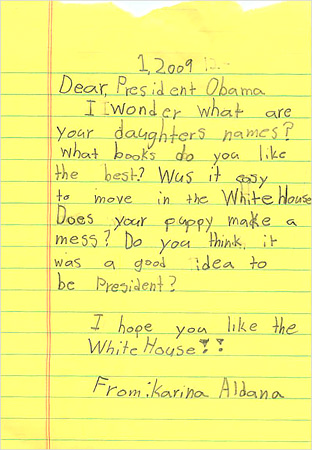
Webmaster's
note:
We have chosen four of relevant interest to these pages.
For More, √
click on the image above.
|
|

Hit-and-Run
Driver Arrested After Striking Puppy
Published:
January 16, 2009
Early last month, five-month-old pit bull Gigi and her owner
were crossing the street near their Staten Island home when
suddenly a car struck the puppy. According to Gigi’s owner,
the car was on the wrong side of the street. The driver
left the scene of the accident without providing any information
to the puppy’s devastated owner. Sadly, Gigi succumbed
to her injuries and died at a nearby animal hospital. The ASPCA
was notified of the incident two days later and promptly began
an investigation.
On December 27, ASPCA Humane Law Enforcement agents arrested
the alleged hit-and-run driver, Rafael Lauda, on multiple charges
stemming from the accident. Lauda, 22, was charged with leaving
the scene of an accident with injury to an animal and driving
with a suspended license. If convicted of all charges, he faces
more than a year in jail.
|

First
kiss
by David Dickson
January
15, 2009
There's nothing like a first kiss. Just ask Cherry the Vicktory
dog! When Cherry first came to Best Friends he was shut down
completely. After being rescued from the property of former
NFL quarterback Michael Vick, the poor guy couldn't even make
eye contact. All he wanted was to hide under a rock and disappear.
And when the Best Friends caregivers tried taking him for walks,
he'd slouch down to the ground and barely move an inch.
Like all the Vicktory dogs, the caregivers worked with Cherry
at his own pace. The progress came slowly at first, but after
enough time Cherry began gaining some confidence and trusting
a few people. He'd even quit throwing on the brakes when they'd
go for walks. But nothing was as big a breakthrough as something
that just happened with his friend Michelle.
Dogtown manager Michelle Besmehn has always had a soft spot
for Cherry. She's been there all along, trying to help him see
the world as not such a scary place. After Cherry had made enough
progress, Michelle invited Cherry to live in her office during
the days.
Office dogs at Dogtown, the dog part of the sanctuary, live
a charmed life. There's always a steady traffic of people and
other dogs coming through. Plenty of new friendly faces to meet
and new smells to analyze and catalogue. A great place for a
dog. That is, if you're the kind of dog who likes to meet new
faces.
Cherry started the whole day-visit routine by crawling under
Michelle's desk and staying there. For weeks he wanted to keep
the meet-and-greets to a bare minimum. Even though he'd come
a long way with confidence and trust, he still had plenty of
room to grow.
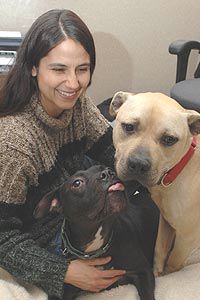 By and by, however, Cherry started finally getting used to all
the well-wishers. He would stop and say hello. In fact, he also
made friends with other dogs who came around. Then the caregivers
tried something new. They brought over Handsome Dan for a visit.
Handsome Dan, another Vicktory dog, is one of Cherry's favorite
pals.
By and by, however, Cherry started finally getting used to all
the well-wishers. He would stop and say hello. In fact, he also
made friends with other dogs who came around. Then the caregivers
tried something new. They brought over Handsome Dan for a visit.
Handsome Dan, another Vicktory dog, is one of Cherry's favorite
pals.
Cherry was so excited to have his old pal visiting that in the
magic of the moment he bestowed his first ever slobbery kiss
on Michelle. Talk about a breakthrough! That was the kiss heard
all around the world. Anybody who knows Cherry does a double-take
on hearing he handed out a real live smooch. He's been on one
heck of a journey, but make no mistake, the best is still ahead.
And coming around the corner soon, by the looks of it. Way to
go Cherry!
Learn more about the dogs rescued from the property of Michael
Vick on the VICKTORY
DOG page.
Photo by
Gary Kalpakoff shows Cherry kissing his pal Handsome Dan.
|
 Australian
dog food pulled from Chinese stores in health scare
Australian
dog food pulled from Chinese stores in health scare
From Yuli Yang
January
13, 2009
BEIJING, China (CNN) -- A brand of imported pet food is being
pulled off store shelves in China after reports of dogs being
sickened by it, a company official said Tuesday.
Natural Pet Corporation, which is the distributor for Optima dog
food from Australia, has ordered a recall, according to Zhang
Haobin, the company's general manager in Shanghai.
Reports of sick animals have been coming into Edis Pet Supply
Company in Shanghai, a retailer selling Optima dog food, a company
representative said.
Veterinarians have told Edis of four dogs poisoned by aflatoxin
after eating Optima products. Chinese media reports detail dozens
of additional poisonings.
Aflatoxin attacks the liver in several animal species. Although
rare in many parts of the world, the fungi that produce aflatoxins
can contaminate cereal grains often used in pet foods.
Zhang said Natural Pet Corporation is fully aware of the reports
of sick dogs and that the products are being tested. No results
are available at this time, he said.
Although this dog food is imported from Australia, tainted products
have been a troubling trend in China.
In 2007, the U.S. Food and Drug Administration recalled more than
150 brands of cat and dog food after finding that some pets became
ill or died after eating food tainted with melamine. Contaminated
additives used in the pet food came from China.
The chemical is commonly used in coatings and laminates, wood
adhesives, fabric coatings, ceiling tiles and flame retardants.
Two Chinese businesses, a U.S. company and top executives of each
were indicted by a federal grand jury in February in connection
with tainted pet food, which resulted in deaths and serious illnesses
in up to thousands of U.S. pets, federal prosecutors said. |

College
Students Find Comfort In Their Pets During Hard Times
A new study suggests that college students may
handle stressful situations better if they have a pet.
January
13, 2009
Research has already shown that pets can improve the quality
of life for people who are aging or those who are chronically
ill. But researchers at Ohio State University recently
found that many college students may also benefit from owning
a cat or a dog.
A survey of students at a large university and other adults
in the area found that nearly a quarter of college students
surveyed believed their pets helped them get through difficult
times in life. Students who chose to live with at least
one dog, one cat, or a combination of the two were less likely
to report feeling lonely and depressed; something they directly
attributed to their beloved pet.
These findings highlight how even younger, healthier young adults
can benefit from living with our four-legged friends, said Sara
Staats, lead author of the study and professor emeritus of psychology
at Ohio State’s Newark Campus.
“We might not think of college students as being lonely,
but a lot of freshman and sophomores are in an early transition
from living at home to living in dorms or off-campus.
College is a very stressful environment for them and sometimes
they can feel isolated or overwhelmed with the change,”
she said.
“We found that a lot of young adults are choosing to have
an animal companion for important reasons. Many feel their
pets will help get them through these difficult and stressful
situations, and many more say that without their pet, they would
feel lonely.”
The study was based on survey responses from nearly 350 college
students at a Midwestern commuter campus and nearby community
members. Only those people who currently or previously owned
a cat, a dog, or a combination of the two were included in the
present study. People who were 18 to 87 years of age were
all surveyed to study the differences between adults and students.
Participants were asked to indicate their current level of health,
the type of pet(s) owned, and whether they believed a pet affected
their overall health. They were then asked to identify
their top reasons for owning a pet in both multiple-choice and
open-ended surveys. The results were recently published
in the journal Society and Animals.
The results showed that most adults and college students chose
to own a pet for similar reasons. Although the results
were based on self-reports, many of those surveyed believed
their pet contributed to their overall health in a number of
ways.
Nearly a quarter of all college students and adults reported
that their pet was useful in keeping them active. This
answer was more common for those who owned dogs, but those who
had feline friends also reported their cat helped keep them
active.
Likewise, 18 percent of college students and 13 percent of adults
said their pet was important to helping them cope during difficult
times. This belief was far more likely among those who
were single rather than married, but it was listed by both groups
in both open-ended and multiple choice questions.
But the results showed that avoiding loneliness was the top
reason given by both students and adults. Nearly identical
percentages of married and single persons gave this response,
but students and those over 50 years of age were far more likely
to list this as their top reason.
While previous work has demonstrated that the elderly benefit
from animal companionship, this study is the one of the first
to suggest that animal companions help those younger than 30
years of age, Staats said.
“Most of the studies on pet ownership focus directly on
those adults and older generations who have heart problems or
special needs. But there hasn’t been much recognition
of that fact that young, healthy college students also derive
benefits from pet ownership such as hedge against loneliness
and improved ability to cope,” she said.
While the reasons for keeping a pet may be similar among adults
and college students, the lifestyles differences between the
two may provide clues as to why students rely on their pets
more often, Staats said. Many people in their late twenties
to mid-forties have established circles of friends. Adults
usually live in areas with friends, colleagues, and family nearby,
making their lives more stable than those beginning to build
their lives. Many more adults are married or have started raising
a family, and have years of experience learning how to cope
with difficult situations.
Many first and second-year students, however, are in the beginning
stages of building a new network of friends. College students
living far from home may find it harder to deal with difficult
situations because they are thrown into a new environment and
expected to find their way, often for the first time in their
lives. As a result, many students may find themselves
feeling isolated and withdrawn from their environment.
“Many students said that their pets fulfill a significant
role that is missing in their lives. The pets are not
a substitute for human social interaction and support, but they
do provide important interaction for these kids who might otherwise
feel isolated from their current environment,” Staats
said. “I wouldn’t advise everyone to go out
and buy a puppy. But I think this research clearly shows that
many students can benefit both psychologically and socially
from living with an animal companion.”
|

A
NEW LEASH ON LIFE
By JEREMY OLSHAN
January
12, 2009
Malasia Johnson was 15 feet away from abandoning her dog.

The teen rubbed her eyes, puffy and red from 12 hours of crying,
squeezed her beloved Yorkie/Maltese mix, Karter, and inched
toward the counter at the city's East 110th Street animal shelter.
"I don't want to give him up, but I don't have a choice,"
Johnson, 17, said, as she neared the front desk. "He barks
all day long and the building management has been complaining,
so my mom said I have to bring him here."
But Jenny Olsen, a volunteer who sits at a TV table in the middle
of the shelter, was determined not to let Johnson reach the
front desk - at least not without a fight.
Olsen runs the Safety Net program, which aims to help New Yorkers
keep their pets by offering free food and heavily discounted
veterinary, training and legal services to the ever-increasing
ranks of the financially distressed.
Calls to Safety Net's hot line are up 50 percent since the economy
imploded in September.
Olsen puts already-heartbroken pet owners on the spot, questioning
their motives in an impromptu trial on the animal's behalf.
Aside from the offers of assistance, she uses any means necessary,
including large servings of guilt, to get owners to reconsider
abandoning their pets and giving them a possible death sentence.
In Johnson's case - as in many others - it didn't take much
to change her mind.
"This all sounds very manageable - we can have a professional
trainer come to your home and work with you and Karter,"
Olsen told the girl.
"You mean you can make him stop barking?" Johnson
asked. "You mean I can keep my dog? Thank you."
|

O-PDATE

Finalists
in the Hunt for a Dog
By SHARON OTTERMAN
Published:
January 12, 2009
The Obama family is nearing a decision on the breed for the
first dog.
Before President-elect Barack Obama began his interview on the
ABC program “This Week,” which was broadcast Sunday,
his daughters, Malia, 10, and Sasha, 7, asked the host, George
Stephanopoulos, to slip in this question: “What kind of
a dog are we getting, and when are we getting it?”
When asked, Mr. Obama laughed “They seem to have narrowed
it down to a Labradoodle or a Portuguese water hound,”
he said, adding that the next step is to canvass shelters.
“We’re closing in on it,” he said. “This
has been tougher than finding a commerce secretary,” a
reference to the recent withdrawal by Gov. Bill Richardson of
New Mexico as his original selection for that post.
Both breeds — a Labradoodle at top, a Portuguese water
dog below — were chosen to reduce Malia’s allergy
to dogs and have big Democratic backers. Senator Edward M. Kennedy
owns two Portuguese water dogs, Sunny and Splash, which often
flank him as he walks the halls of the Capitol. Vice President-elect
Joseph R. Biden Jr. has a Labradoodle (part Labrador retriever,
part poodle) named Brother.
|

Mercury Detection: It's a “Ruff Job”
Sniffing Dog Provides
Cost-Effective Contamination Detection
January
12, 2009
MINNEAPOLIS,
Minn. -- America's only dog that's trained to sniff mercury
is able to detect as little as a half-gram, and is faster and
cheaper than traditional lab analysis. Dogs' olfactory membranes
are larger and 44 times more sensitive than humans'. Mercury
contamination is frequent in schools: mercury spills are typical
in science classrooms and labs where thermometers and barometers
are used.
It's not often that you see a four-legged student roaming the
school halls, but this dog is on a mission. Clancy is the only
dog in the United States trained to sniff out dangerous mercury.
"A lot of time the kids will break lab thermometers and
try to sweep them down into the sink, and can continuously put
out vapor that the students can breathe and the teachers can
breathe," Carol Hubbard, a mercury specialist with the
Minnesota Pollution Control Agency in St. Paul, tells DBIS.
She says breathing in that vapor can be dangerous. In young
children, it can actually stunt their intellectual development.
But students at Patrick Henry High School in Minneapolis, Minn.,
have nothing to fear. Clancy can detect as little as a half
a gram of mercury -- the same amount that spills out when a
thermometer breaks. On command, he sits next to the hidden mercury
and waits for his reward -- a tennis ball.
Student Andre Washington says, "If he's able to sniff out
that stuff and save us from the mercury exposure, I think he's
a really good dog!"
"He sniffs out mercury," David Hanvichid says. "That's
an incredible ability that a dog can do!"
Incredible, but also in his nature. Dogs can detect odors 44-times
better than humans. They pick up scents through folded membranes
right behind their noses -- right in front of their brains.
Humans' membranes are the size of a postage stamp, but dogs'
are 50-times bigger.
Clancy finds unexpected mercury in a school supply room. Hubbard
tests the area with her machine to make sure he's right. And
he is!
"He is pretty reliable," Hubbard says. He's also quicker,
cheaper and better company than her equipment. "We have
gotten to be really good friends. He is my partner, so we have
a lot of fun."
And they get a lot done! In the last five years, Clancy helped
rid schools of more than 1,500 pounds of mercury.
Hubbard and her colleagues got Clancy from the humane society.
They said they picked him because he was so responsive to tennis
balls, indicating he'd work hard for his reward. It took her
about two months to train Clancy. Both Hubbard and Clancy get
their blood levels tested for mercury -- his every six months,
hers every 12 -- and they've always tested normal.
BACKGROUND: Dogs have been used by law enforcement and military
personnel for 30 years to detect narcotics and explosives because
of their keen sense of smell. The Minnesota Protection Control
Agency (MPCA) is now using specially trained dogs to check schools
and other facilities for mercury contamination. The MPCA estimates
that there is around two pounds of mercury "hidden"
in most schools. The U.S. Environmental Protecton Agency is
also conducting research on how to use dogs for detection of
indoor air pollutants such as toxic molds, illegal pesticides,
and gasoline vapors from contaminated ground water.
|
 Dog
killer turns to cats
Dog
killer turns to cats
January
12 2009
A mystery
dog poisoner who has killed scores of Hong Kong pet dogs over
the past 20 years has begun targeting cats, animal welfare experts
warned on Monday.
The body of a ginger and white cat was found last week off Bowen
Road in Hong Kong's Mid Levels district, the regular haunt of
the poisoner who lays tainted meat and has evaded capture for
two decades.
The Society for the Prevention of Cruelty to Animals (SPCA) said
the dead pet it was found by police close to where a jogger had
reported seeing suspicious pieces of meat the same day. SPCA Executive
Director Sandy Macalister said: "It is a dreadful thing.
It is so cruel and indiscriminate and goes to show we can assume
that other animals like cats have died but have never been found."
On Saturday, SPCA inspectors and volunteers organised a systematic
sweep of the hillside to check for more poisonous bait in the
undergrowth and to warn dog walkers to be extra vigilant. Police
say there have been around 72 cases of dog poisoning in the
area between 1995 and end of October 2007, and three on Hong
Kong Island in the first 10 months of 2008.
However, the SPCA believes around 200 dogs have been poisoned
at the hand of the Mid-Levels poisoner in the past 20 years.
The most famous victim was Whisky, the pet dog of Hong Kong's
last British governor Chris Patten, who survived after eating
poisoned chicken four months before the handover in 1997.
All the cases have been along Bowen Road and Black's Link area
and involve dogs ingesting a meat laced with highly-toxic pesticide
that causes a particularly painful death.
One theory which has persisted over the serial-killer's long
reign is that the person responsible has an obsessive dislike
of dogs who foul footpaths and may have begun his campaign as
a means of revenge.
But Macalister said the latest case showed whoever was responsible
had no regard for any animal life.
"This person uses a very toxic pesticide. We had a dog
brought in which we presume had just licked the area where the
poison had been laid. The dog didn't die but it was very sick.
It went through hell but survived," he said.
A huge reward from animal lovers has been offered to anyone
who can track down the culprit.
A Hong Kong police spokesperson said: "We attach much importance
to tackling dog poisoning cases. Apart from stepping up patrols
at black spots, we have also taken various steps to draw the
public's attention to the matter."
|

EXTRA!!!

Obama
choice: Labradoodle or a Portuguese water dog
By Janice Lloyd
January 11,
2009
Will the next pooch in the White House be a dog of change?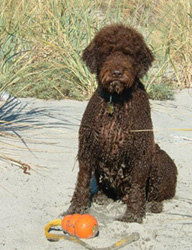
Sunday, President-elect Barack Obama told George Stephanopoulos
on ABC News' This Week that the family has narrowed the choice
to either a Portuguese Water Hound or Labradoodle.
The former is actually known as the Portuguese water dog. It
dates back to the 1200s and worked on boats with Portuguese
fishermen, according to the website of the Portuguese Water
Dog Club of America.
Sen. Ted Kennedy has helped make them famous, returning to the
Capitol after brain cancer treatment with his two Portuguese
water dogs.
The labradoodle, on the other hand, is a relatively new dog
whose  cross-breeding
between a Labrador and a poodle goes back only to the 1980s.
In his election-night victory speech, Obama promised daughters
Sasha, 7, and Malia, 10, they could have a puppy in the White
House. He later said that Malia is allergic, that the family
would need a "hypoallergenic" dog and that they wanted
a pound dog. cross-breeding
between a Labrador and a poodle goes back only to the 1980s.
In his election-night victory speech, Obama promised daughters
Sasha, 7, and Malia, 10, they could have a puppy in the White
House. He later said that Malia is allergic, that the family
would need a "hypoallergenic" dog and that they wanted
a pound dog.
Both dogs are non-shedders and do not cause as much reaction
in allergy sufferers as other dogs, says Stu Freeman, president
of the Portuguese Water Dog Club of America.
"There really is no hypoallergenic dog," Freeman says.
"We tell people to spend time around the dogs to make sure
they're going to be OK. The hair might not bother them, but
the saliva might."
Freeman says it can be difficult to find either breed in shelters
because "rescue groups will always get word they're in
shelters and save them."
Obama told Stephanopoulos they were going to start "looking
at shelters to see when one of those dogs might come up."
Mary Harkings, who oversees a Portuguese water dog rescue group,
says the breed is "funny and very family-oriented"
but adds that the dogs crave exercise. "You can't just
put them in a backyard and let them run it out," she says.
"They want to do things with you."
That might be one huge plus for the labradoodle. "They
can get by on 30 minutes a day of walking," says Melissa
Angelini, a breeder in Monroe Township, N.J. "They're not
that high-energy. Mine have been lying around for three days
and are fine."
Obama has said finding the right dog has been "tougher
than finding a Commerce secretary."
Rolli Grayson, a Chicago breeder of the Portuguese water dogs,
was watching the show and had this advice for Obama: "I
just wish he'd get what he wants. He should stop worrying about
pleasing everyone and get what's best for his family."
|
 Prince
Edward escapes charge over beating dog
Prince
Edward escapes charge over beating dog
January
10, 2009
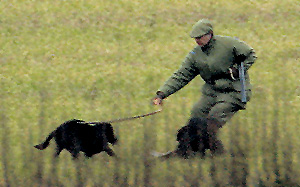 LONDON (AFP) — Britain's Prince Edward has escaped prosecution
for allegedly beating a dog, after an animal welfare group said
Friday there was insufficient evidence to charge him.
LONDON (AFP) — Britain's Prince Edward has escaped prosecution
for allegedly beating a dog, after an animal welfare group said
Friday there was insufficient evidence to charge him.
Edward, 44, youngest child of Queen Elizabeth II, was pictured
in newspapers last month waving a four-foot (1.2-metre) stick
at two quarrelling gun dogs -- first with the stick in the air,
then very close to one of the dogs' heads.
Charities complained, and the Royal Society for the Protection
of Cruelty to Animals (RSPCA) opened an investigation into whether
he could be prosecuted.
But on Friday the RSPCA announced it had "closed its investigation
as there was insufficient evidence to support the allegation that
Prince Edward beat his dog."
A Buckingham Palace spokeswoman welcomed the outcome, but declined
to comment further.
The dogs were said to fighting over a dead pheasant during a shooting
outing at Queen Elizabeth's private Sandringham estate in Norfolk,
in the east of England, where the royals traditionally spend their
winter break.
At the time a palace spokesman said: "He broke up the fight
with the dogs and pictures show him waving his stick around. We
cannot confirm, however, whether he struck the dog." |

Dog Caught Stealing Home at Citi Field
January
9, 2009
Not since Ricky Henderson's playing days in Queens has someone
dogged it this bad for the Mets.
A stray dog led city animal control officers on a romp through
the Mets' new Citi Field yesterday after sneaking into the ballpark
and sleeping there for several days, according to the Daily News.
"She was around home plate, ran up the first base line and
ducked into the stands," Mike Pastore, head of field operations
for New York City Animal Care & Control, told The News. "We
were going to set up a trap behind home plate."
Construction workers told The News that the dog had been wandering
around Citi Field for days.
The animal control officers eventually grabbed the dog near the
stadium's Jackie Robinson Rotunda, and then named her Jackie after
the baseball legend.
The brown-and-cream shepherd mix weighed about 40lbs and was taken
to a Manhattan shelter to be evaluated. If healthy, she will be
up for adoption within days. |
 
Several Dogs Die From Illness at Brooklyn Animal Home
Wednesday,
07 January 2009
NEW YORK -- Several dogs have died from a rare illness that forced
a Brooklyn animal shelter to close for nearly a week.
Animal Care & Control of New York City says the dogs at the
Brooklyn shelter on Linden Boulevard are no longer in any danger
from contracting the disease known as Strep Zoo.
The shelter reopened Monday.
The shelter was closed last week. People who wanted to drop off
or adopt dogs were directed to go to the agency's Manhattan location.
AC&C spokesman Richard Gentles says that all animals were
given penicillin as a precaution. |

From
Dog Fighting to Dog Snuggling
by David Dickson
January
5, 2009
Quick, it's time to buy some presents! Not the holiday variety,
though. We're talking about can openers, sofas, curtains, and
silverware. It's a house-warming party for two of the Vicktory
dogs!
Before you get too excited, they haven't been  adopted
yet. But for Little Red and Handsome Dan, it's a big step in
that direction. These two snuggle monsters are now living in
the same play area. It's a far cry from dog fighting! These
two pups, rescued from the property of former NFL quarterback
Michael Vick, are now snuggling it up together. adopted
yet. But for Little Red and Handsome Dan, it's a big step in
that direction. These two snuggle monsters are now living in
the same play area. It's a far cry from dog fighting! These
two pups, rescued from the property of former NFL quarterback
Michael Vick, are now snuggling it up together.
When they first arrived at the sanctuary, the Vicktory dogs
had a long road ahead of them in so many different ways. One
of the biggest was confidence. Some of the Vicktory dogs were
so totally afraid of everything around them that they commando-crawled
everywhere they went, just to stay closer to the ground and
out of the way. Each one lived alone in a private play area.
It's incredible how far they've come. They conquered loose-leash
walking, socialization, basic training, and learning how to
play. Oscar has even become a Canine Good Citizen! No question,
the Vicktory dogs are not the same dogs who rolled off the truck,
afraid of their own shadows.
And now, Little Red and Handsome Dan are at the point where
they can live together as play pals. Some space opened up in
another part of the sanctuary, and the caregivers and managers
thought this was a good chance to give them a new experience.
So two of the Vicktory dogs, all of whom many people thought
would never get along with other dogs, are now happy and well-adjusted
roommates. These two dogs who have had such a rough life can
now zip and race around in their very own play area as only
best buds can do.
Surely that's worth a celebratory chew toy or two!
Photo
by Molly Wald
|
 /
MAGAZINE
/
MAGAZINE
Creature Comforts
By REBECCA SKLOOT
January
4, 2009
Exerpted
ON HALLOWEEN NIGHT IN A SUBURB of Albany, a group of
children dressed as 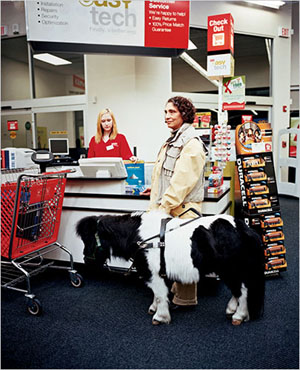 vampires
and witches ran past a middle-aged woman in plain clothes. She
gripped a leather harness — like the kind used for Seeing
Eye dogs — which was attached to a small, fuzzy black-and-white
horse barely tall enough to reach the woman’s hip. vampires
and witches ran past a middle-aged woman in plain clothes. She
gripped a leather harness — like the kind used for Seeing
Eye dogs — which was attached to a small, fuzzy black-and-white
horse barely tall enough to reach the woman’s hip.
“Cool costume,” one of the kids said, nodding toward
her.
But she wasn’t dressed up. The woman, Ann
Edie, was simply blind and out for an evening walk with
Panda, her guide miniature horse.
• • •
Edie
isn’t the only blind person who uses a guide horse instead
of a dog — there’s actually a Guide Horse Foundation
that’s been around nearly a decade. The obvious question
is, Why? In fact, Edie says, there are many reasons: miniature
horses are mild-mannered, trainable and less threatening than
large dogs. They’re naturally cautious and have exceptional
vision, with eyes set far apart for nearly 360-degree range.
Plus, they’re herd animals, so they instinctively synchronize
their movements with others. But the biggest reason is age:
miniature horses can live and work for more than 30 years. In
that time, a blind person typically goes through five to seven
guide dogs. That can be draining both emotionally and economically,
because each one can cost up to $60,000 to breed, train and
place in a home.
•
• •
...the
Americans With Disabilities Act (A.D.A.) requires that service
animals be allowed wherever their owners want to go.
•
• •
A
few months ago, in a cafe in St. Louis, I met a man named Jim
Eggers, who uses an assistance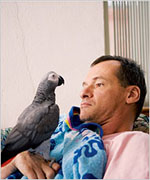 parrot, Sadie, to help control his psychotic tendencies....
“I have bipolar disorder with psychotic tendencies,”
he told me.... “Homicidal feelings too.”
parrot, Sadie, to help control his psychotic tendencies....
“I have bipolar disorder with psychotic tendencies,”
he told me.... “Homicidal feelings too.”
•
• •
Sadie
is one of the few things keeping Eggers from snapping. Sadie
rides around town on Eggers’s back in a bright purple
backpack specially designed to hold her cage. When he gets upset,
she talks him down, saying: “It’s O.K., Jim. Calm
down, Jim. You’re all right, Jim. I’m here, Jim.”
She somehow senses when he is getting agitated before he even
knows it’s happening.
•
• •
There
are two categories of animals that help people. “Therapy
animals” (also known as “comfort animals”)
have been used for decades in hospitals and homes for the elderly
or disabled. Their job is essentially to be themselves —
to let humans pet and play with them, which calms people, lowers
their blood pressure and makes them feel better. There are also
therapy horses, which people ride to help with balance and muscle
building.
These
animals are valuable, but they have no special legal rights
because they aren’t considered service animals, the second
category, which the A.D.A. defines as “any guide dog,
signal dog or other animal individually trained to do work or
perform tasks for the benefit of an individual with a disability,
including, but not limited to, guiding individuals with impaired
vision, alerting individuals with impaired hearing to intruders
or sounds, providing minimal protection or rescue work, pulling
a wheelchair or fetching dropped items.”
Since the 1920s, when guide dogs first started working with
blind World War I veterans, service animals have been trained
to do everything from helping people balance on stairs to opening
doors to calling 911. In the early ’80s, small capuchin
monkeys started helping quadriplegics with basic day-to-day
functions like eating and drinking, and there was no question
about whetherú they counted as service animals. Things
got more complicated in the ’90s, when “psychiatric
service animals” started fetching pills and water, alerting
owners to panic attacks and helping autistic children socialize.
The
line between therapy animals and psychiatric service animals
has always been blurry, because it usually comes down to varying
definitions of the words “task” and “work”
and whether something like actively soothing a person qualifies.
That line got blurrier in 2003, when the Department of Transportation
revised its internal policies regarding service animals on airplanes.
It issued a statement saying that in recent years, “a
wider variety of animals (e.g., cats, monkeys, etc.) have been
individually trained to assist people with disabilities. Service
animals also perform a much wider variety of functions than
ever before.”
To keep up with these changes, the D.O.T.’s new guidelines
said, “Animals that assist persons with disabilities by
providing emotional support qualify as service animals.”
They also said that any species could qualify and that these
animals didn’t need special training, aside from basic
obedience. The only thing required for a pet to fly with its
owner instead of riding as cargo was documentation (like a letter
from a doctor) saying the person needed emotional support from
an animal.
•
• •
To
protect the disabled from intrusive questions about their medical
histories, the A.D.A. makes it illegal to ask what disorder
an animal helps with. You also can’t ask for proof that
a person is disabled or a demonstration of an animal’s
“tasks.” The only questions businesses can ask are
“Is that a trained service animal?” and “What
task is it trained to do?”
If
the person answers yes to the first and claims that the animal
is, say, trained to alert him or her to a specific condition
(like a seizure), additional questioning could end in a lawsuit.
•
• •
In
June, in an effort to clarify the confusion surrounding service
animals, the Department of Justice proposed new regulations
to explicitly include psychiatric service and exclude comfort
animals. This was part of a sweeping revision of the A.D.A.
•
• •
"Many
people try to make this issue black and white — this service
animal is good; that one is bad — but that’s not
possible, because disability extends through an enormous realm
of human behavior and anatomy and human condition,” Lex
Frieden, a professor of health-information science at the University
of Texas Health Science Center at Houston and a former director
of the National Council on Disability, told me. In the end,
according to him, the important thing to remember is this: “The
public used to be put off by the very sight of a person with
a disability. That state of mind delayed productivity and caused
irreparable harm to many people for decades. We’ve now
said, by law, that regardless of their disability, people must
have equal opportunity, and we can’t discriminate. In
order to seek the opportunities and benefits they have as citizens,
if a person needs a cane, they should be able to use one. If
they need a wheelchair, a dog, a miniature horse or any other
device or animal, society has to accept that, because those
things are, in fact, part of that person.”
√
Click
on New York
Times banner for full article
Click
here √ for related story
for related story
Photo
Credits:
Edie and Panda: Jeff Riedel for The New York Times
Sadie and Eggers: Dilip Vishwanat/Getty Images, for The New
York Times
Webmaster's
note:
Having broken a hip in a fall four years ago and needing hip
replacement surgery a year later, I depend on my Mini Schnauzer,
Rodin, to  assist
me in walking our other two Dogs, Frida and Sophie. As a sufferer
of AADD and Bipolar disorder, Rodin also keeps me focused and
alerts me to upcoming mood changes. Three years ago, during
a suicidal episode, he saved my life. assist
me in walking our other two Dogs, Frida and Sophie. As a sufferer
of AADD and Bipolar disorder, Rodin also keeps me focused and
alerts me to upcoming mood changes. Three years ago, during
a suicidal episode, he saved my life.
√
MORE
ON THIS COMING SOON IN
 a true story
a true story
about our
family, our
Dogs and
THE
CO-OP
BOARD
from
HELL
This
is a work in progress
|

DESIGNER GONE 'WILD'
By RITA DELFINER
Saturday,
January 3, 2009
Fashion designer Karl Lagerfeld has tanned the hide of animal-rights
activists - by declaring that furs  come
from "beasts who would kill us if they could." come
from "beasts who would kill us if they could."
The Chanel designer, 75, told BBC Radio that, "in a meat-eating
world, wearing leather for shoes and even clothes and handbags,
the discussion of fur is childish."
"Personally, I don't wear fur," said the German-born
haute couture icon....
But Lagerfeld noted that there is "an industry who lives
from that."
In the north, hunters "make a living having learned nothing
else than hunting," he said, "killing those beasts
who would kill us if they could kill us."
Michael McGraw, a spokesman for People
for the Ethical Treatment of Animals, said: "Lagerfeld
seems particularly delusional with his kill-or-be-killed mentality.
When was the last time a person's life was threatened by a mink
or rabbit?"
Webmaster's
note:
To: letters@nypost.com
From: rodin@from-the-doghouse.com
Subject: Designer Gone 'Wild' - Saturday, January 3, 2009
Sent: Sat 1/3/2009 5:34 PM
Perhaps fashion designer Karl Lagerfeld's declaration that furs
come from "beasts who would kill us if they could"
and that hunters are "killing those beasts who would kill
us if they could kill us" should be taken to its ultimate
conclusion and we should revert to cannibalism for no animal
hunts and kills man like man.
Now, who's discussion is "childish"?
May the Dogs be with you!
ROBERT COANE
Webmaster
|

Two
New Yorkers Arrested for Starving Their Dogs
Published:
January 2, 2009
Following investigations by the ASPCA’s Humane Law Enforcement
(HLE) department, two New York City women were arrested last
month for crimes against their animal companions. Although the
women are from different boroughs and their stories are unconnected,
their alleged offenses are the same—both failed to adequately
care for their pet dogs, putting the animals’ lives in
jeopardy through neglect.
Back in October, an HLE agent discovered an emaciated and dirty
male pit bull in the Manhattan home of Jennifer Vias, 26. The
one-year-old dog was transported to the ASPCA’s Bergh
Memorial Animal Hospital (BMAH), where he was renamed Lazarus
and treated for starvation and neglect. On December 14, Vias
was placed under arrest and charged with one count of misdemeanor
animal cruelty. She faces up to one year in jail and a $1,000
fine; meanwhile, Lazarus was released to the ASPCA and, just
this week, began his new life with qualified, caring adopters.
On December 12, HLE agents arrested Staten Islander Zaquana
Gordon for neglecting her three-year-old dog. When police officers
from the 122nd Precinct executed an unrelated warrant on Gordon
in early November, they encountered the woman’s extremely
thin, lethargic pit bull and alerted the ASPCA.  HLE
agents retrieved the dog from the scene and brought him to BMAH.
Like Lazarus, this dog, renamed Romeo, was treated for starvation
and neglect. HLE
agents retrieved the dog from the scene and brought him to BMAH.
Like Lazarus, this dog, renamed Romeo, was treated for starvation
and neglect.
Gordon, 22, was charged with one count of misdemeanor animal
cruelty and two counts of criminal possession for drugs found
on her person during the arrest. Romeo was released to the ASPCA
and is currently available for adoption .
Owning a pet is a responsibility that should not be taken lightly.
Neglect to meet a pet’s basic needs—including food,
water, shelter and medical care—is a crime recognized
by an ever-growing number of jurisdictions across the nation.
If you know of an animal whose health is being compromised by
neglect, please report it. In New York City, contact the ASPCA’s
anonymous tip line at (877) THE-ASPCA.
Visit
our Report Cruelty FAQ to learn how to report cruelty elsewhere.
|

Beloved Pets Everlasting?
By ERIC KONIGSBERG
January
1, 2009
Fairfax, Calif. -- THE
most difficult thing about the cloned puppies is not telling
them apart, but explaining why they don’t look exactly
alike. This was the problem Lou Hawthorne faced on a recent
afternoon hike with Mira and MissyToo, two dogs whose embryos
were created from the preserved, recycled and repurposed nuclear
DNA of the original Missy, a border collie-husky mix who died
in 2002.
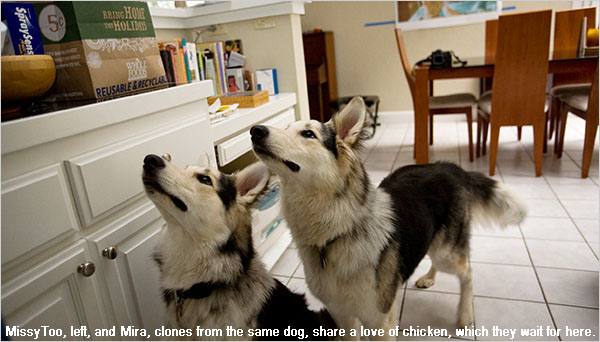
Photo: Heidi Schumann for
The New York Times
To be sure, they have a very strong resemblance to each other
and to Missy. It’s just that sometimes, as soon as people
hear that the dogs are clones, the questions start coming:
“Why is one dog’s fur curlier?”
“Why aren’t the dogs the same size?”
“Why is one of them darker?”
“Why does this one have a floppy ear?”
Mr. Hawthorne, who is 48, is highly invested in the notion of
likeness. With clones, after all, what good does similar do?
It is Mr. Hawthorne’s biotech company, BioArts, which
is based here in the Bay Area but has arrangements with a laboratory
in South Korea, that performed the actual cloning.
He also has particular reason to be sensitive to questions that
touch on the authenticity of the clones, given the history of
his chief geneticist, Dr. Hwang Woo Suk of the Sooam Biotech
Research Foundation in South Korea. Dr. Hwang is perhaps best
known for fraudulently reporting in 2004 that a team he led
had successfully cloned human embryos and stem cells. After
the false claims were unearthed, he was fired by Seoul National
University, where he did his research as a professor. But he
is also widely acknowledged for having been involved in successfully
cloning an Afghan hound in 2005.
“Dr. Hwang’s past is obviously controversial, but
we feel that his lab and his record when it comes to dog cloning
are the best in the field,” Mr. Hawthorne said. “He’s
been very open with me about admitting his mistakes. Nobody
says he lied about cloning animals.”
Elizabeth Wictum, associate director of the Veterinary Genetics
Laboratory at the University of California, Davis, said that
earlier this year, she and her staff had taken sets of DNA extracts
from Mr. Hawthorne’s puppies and compared them with stored
samples of Missy’s DNA, and concluded that the results
were “consistent with clones.”
“The puppies had the same nuclear DNA as Missy, and different
mitochondrial DNA, which is what you get from a cloned animal,”
Ms. Wictum said. “If somebody were trying to, say, sneak
in two samples from the same dog or an identical twin and claim
that one was a clone’s, there would be no differentiation
between the nuclear and mitochondrial DNA.”
Missy 1.0 — Mira and MissyToo’s “genetic donor,”
as Mr. Hawthorne calls her when he’s speaking technically
— was his mother’s dog. To date, he said, there
are four Missy clones running around, all born between December
2007 and June 2008. Mira lives at Mr. Hawthorne’s house
in Mill Valley and MissyToo between homes in Mill Valley and
San Francisco, both owned by his mother’s boyfriend; clones
No. 3 and 4 were given away to friends and now live in Phoenix
and Boulder, respectively.
Click
√
on image for full article
Photo:
Heidi Schumann for
The New York Times
|
|




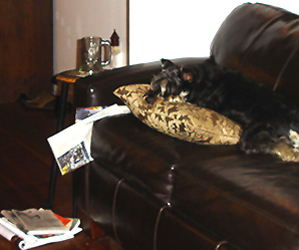

 Wolves
to Return to Endangered List
Wolves
to Return to Endangered List 
 area,
flat-screen TVs, Webcam access and private rooms with attached
patios opened near O'Hare International Airport in May 2008,
just as the travel industry was descending rapidly due to
the economy.
area,
flat-screen TVs, Webcam access and private rooms with attached
patios opened near O'Hare International Airport in May 2008,
just as the travel industry was descending rapidly due to
the economy. birthday
celebration earlier this month was overshadowed by a public
furore over Evita, his beloved dachshund, after she bit a
royal guardsman on the leg.
birthday
celebration earlier this month was overshadowed by a public
furore over Evita, his beloved dachshund, after she bit a
royal guardsman on the leg.  own
official White House portrait.
own
official White House portrait. 

 restaurant
want to use it. (My gift! Enjoy! Or maybe not . . .) It captures
the gist of a new and unusual (at least to my knowledge and
quick reporting) but abundantly clever effort by Momofuku
to help homeless dogs.
restaurant
want to use it. (My gift! Enjoy! Or maybe not . . .) It captures
the gist of a new and unusual (at least to my knowledge and
quick reporting) but abundantly clever effort by Momofuku
to help homeless dogs.  there’s
been some red tape to cut through, according to the Momofuku
staffer most centrally involved in the project, Christina
Tosi (right). She said some animal shelters
resisted overtures, while others had to pause to research
whether any city codes or ordinances discouraged such donations.
there’s
been some red tape to cut through, according to the Momofuku
staffer most centrally involved in the project, Christina
Tosi (right). She said some animal shelters
resisted overtures, while others had to pause to research
whether any city codes or ordinances discouraged such donations.
 much
his friend tried to persuade him.
much
his friend tried to persuade him. 




 Canine
commuter - wild dog waits on the platform
Canine
commuter - wild dog waits on the platform 

 Judicial
Circuit Drug Task Force. The ASPCA dispatched forensic veterinarian
Dr. Melinda Merck and our Mobile Animal Crime Scene Investigation
Unit to collect evidence in the investigation and aid in the
prosecution of the case.
Judicial
Circuit Drug Task Force. The ASPCA dispatched forensic veterinarian
Dr. Melinda Merck and our Mobile Animal Crime Scene Investigation
Unit to collect evidence in the investigation and aid in the
prosecution of the case. connection
with tainted pet food in 2007 that may have killed thousands
of dogs and cats .
connection
with tainted pet food in 2007 that may have killed thousands
of dogs and cats .







 pal
Emory.
pal
Emory. first
legal step before asking a Housing Court judge to
remove the dog or the family from the building.
first
legal step before asking a Housing Court judge to
remove the dog or the family from the building. 
 Monday
morning at 7:15 a.m., CNN American Morning anchor
Soledad O'Brien conducted one of her regular vicious
jihads against a Democrat. Her victim this morning
was Senator Russ Feingold, who has the audacity to propose
censuring George Bush for repeatedly breaking the
law by authorizing warrantless wiretaps of law-abiding
Americans. (CrooksandLiars.com has the video.)
Monday
morning at 7:15 a.m., CNN American Morning anchor
Soledad O'Brien conducted one of her regular vicious
jihads against a Democrat. Her victim this morning
was Senator Russ Feingold, who has the audacity to propose
censuring George Bush for repeatedly breaking the
law by authorizing warrantless wiretaps of law-abiding
Americans. (CrooksandLiars.com has the video.)





 Now
that he's no longer commander in chief, George W. Bush's life
has gone to the dogs.
Now
that he's no longer commander in chief, George W. Bush's life
has gone to the dogs. 
 Boulder,
Colo., has been adopted by another family.
Boulder,
Colo., has been adopted by another family. took
off, leaping over a fence and into the night. He wasn't seen
again until Sunday morning, when a man walking to a hardware
store spotted him near a cemetery on the border between Evergreen
Park and Chicago.
took
off, leaping over a fence and into the night. He wasn't seen
again until Sunday morning, when a man walking to a hardware
store spotted him near a cemetery on the border between Evergreen
Park and Chicago. German
shepherd has been missing since Wednesday night after he was
spooked by thunder and climbed a fence near the officer's Southwest
Side home, Canine Unit Officer Rick King said.
German
shepherd has been missing since Wednesday night after he was
spooked by thunder and climbed a fence near the officer's Southwest
Side home, Canine Unit Officer Rick King said. groups
in the New York area. Best Friends Animal Society, in collaboration
with National Mill Dog Rescue, arranged for the release and
transport of the dogs and after a long but hopeful cross-country
journey over the Mother's Day weekend, they were delivered to
waiting groups here at North Shore Animal League America.
groups
in the New York area. Best Friends Animal Society, in collaboration
with National Mill Dog Rescue, arranged for the release and
transport of the dogs and after a long but hopeful cross-country
journey over the Mother's Day weekend, they were delivered to
waiting groups here at North Shore Animal League America. 
 and
transported them to New York for a new “leash”
on life.
and
transported them to New York for a new “leash”
on life. 
 an
animal cruelty conviction by testifying in the trial of Kathy
Bauck, operator of Pick of the Litter Kennels. The New York
Mills, MN, breeder sells animals to pet stores and online—and
has at times housed more than 1,300 dogs of at least 32 different
breeds. Bauck was arrested in August 2008 and charged with
several counts of felony animal cruelty, torture and practicing
veterinary medicine without a license. On March 24, after
a 41⁄2-day trial and six hours of deliberation, a jury
cleared Bauck of felony charges but found her guilty of four
misdemeanors (one count of animal cruelty and three counts
of torture).
an
animal cruelty conviction by testifying in the trial of Kathy
Bauck, operator of Pick of the Litter Kennels. The New York
Mills, MN, breeder sells animals to pet stores and online—and
has at times housed more than 1,300 dogs of at least 32 different
breeds. Bauck was arrested in August 2008 and charged with
several counts of felony animal cruelty, torture and practicing
veterinary medicine without a license. On March 24, after
a 41⁄2-day trial and six hours of deliberation, a jury
cleared Bauck of felony charges but found her guilty of four
misdemeanors (one count of animal cruelty and three counts
of torture).  earlier
this week, but not before the "ninja" made off with
the goods. The couple says the 7-year-old Yorkshire Terrier
began growling and barking Monday night, which tipped them
off to the burglar's presence.
earlier
this week, but not before the "ninja" made off with
the goods. The couple says the 7-year-old Yorkshire Terrier
began growling and barking Monday night, which tipped them
off to the burglar's presence. 

 housing
apartments, as he has for years. But others of his kind are
not.
housing
apartments, as he has for years. But others of his kind are
not.
 New
airline tries to make skies friendlier for furry travelers
New
airline tries to make skies friendlier for furry travelers attendant
with them. ... There's fresh circulated air, like any passenger
would have. It's well-lit. It's a whole different service
than cargo."
attendant
with them. ... There's fresh circulated air, like any passenger
would have. It's well-lit. It's a whole different service
than cargo."

 distributed,
trustees announced on Tuesday, but the bulk went to
medical centers instead of dogs.
distributed,
trustees announced on Tuesday, but the bulk went to
medical centers instead of dogs.  Mean's
money to charity -- with only $1 million going to
the canine causes she so loved. Helmsley, 87, who
died in 2007, left barking orders in her will that
funds from the Leona M. and Harry B. Helmsley Charitable
Trust would be used for "purposes related to
the provision of care for dogs."
Mean's
money to charity -- with only $1 million going to
the canine causes she so loved. Helmsley, 87, who
died in 2007, left barking orders in her will that
funds from the Leona M. and Harry B. Helmsley Charitable
Trust would be used for "purposes related to
the provision of care for dogs."  million
to charity — with just $1 million going to the
dogs.
million
to charity — with just $1 million going to the
dogs. cohorts,
Hunter, Peanut and Casey. To their Upper East Side owner,
they are man's best friends, precious pooches who can do no
wrong. To their neighbors, they are the hounds of hell whose
barks drive people bonkers.
cohorts,
Hunter, Peanut and Casey. To their Upper East Side owner,
they are man's best friends, precious pooches who can do no
wrong. To their neighbors, they are the hounds of hell whose
barks drive people bonkers.  newest
– and only four-legged — occupant of the White
House, made his much-anticipated Washington debut. Then again,
the president had his two young daughters with him. What else
could any self-respecting father and new dog owner say? “We’re
trying to be responsible dog owners,’’ he later
confessed.
newest
– and only four-legged — occupant of the White
House, made his much-anticipated Washington debut. Then again,
the president had his two young daughters with him. What else
could any self-respecting father and new dog owner say? “We’re
trying to be responsible dog owners,’’ he later
confessed.
 secretary
of the interior, to remove the gray wolf from the endangered
species list in Idaho and Montana.
secretary
of the interior, to remove the gray wolf from the endangered
species list in Idaho and Montana. 

 fighters.
And now, Best Friends Animal Society and other animal welfare
groups have joined forces to help future canine victims of
this organized crime.
fighters.
And now, Best Friends Animal Society and other animal welfare
groups have joined forces to help future canine victims of
this organized crime.  Malia
and Sasha chose the name, because their cousins have a cat
named Bo and because first lady Michelle Obama’s father
was nicknamed Diddley, a source said. (Get it? Bo …
Diddley?)
Malia
and Sasha chose the name, because their cousins have a cat
named Bo and because first lady Michelle Obama’s father
was nicknamed Diddley, a source said. (Get it? Bo …
Diddley?)  When
the president walked across the room during the visit, Bo
followed obediently.
When
the president walked across the room during the visit, Bo
followed obediently. 
 pet
-- and recommended swatting the tiny terrier when he tinkled
inside, according to court documents.
pet
-- and recommended swatting the tiny terrier when he tinkled
inside, according to court documents. 
 leads
a Passover Seder in Chicago on Saturday, some of the rituals
symbolizing Jews’ exodus from Egypt may be lost on the
yarmulke-wearing guests. Those guests will, after all, be
dogs.
leads
a Passover Seder in Chicago on Saturday, some of the rituals
symbolizing Jews’ exodus from Egypt may be lost on the
yarmulke-wearing guests. Those guests will, after all, be
dogs.  a
deaf woman in Queens. They pinched her best friend -- her dog,
Pinky (left).
a
deaf woman in Queens. They pinched her best friend -- her dog,
Pinky (left).  title
of world's smallest dog.
title
of world's smallest dog.
 owners
after surviving alone on an island for four months, reports
said.
owners
after surviving alone on an island for four months, reports
said.  PITTSBURGH
(AP) — A 911 call that summoned two police officers
to a home where they were ambushed, and where a third was
later killed during a four-hour siege, was precipitated by
a fight between the gunman and his mother over a Dog urinating
in the house....
PITTSBURGH
(AP) — A 911 call that summoned two police officers
to a home where they were ambushed, and where a third was
later killed during a four-hour siege, was precipitated by
a fight between the gunman and his mother over a Dog urinating
in the house....
 a
new study finds.
a
new study finds. 
 collars
and sending them for spa services. Now even the city’s
wealthiest dog owners have cut their budgets and sometimes
abandoned their dogs entirely.
collars
and sending them for spa services. Now even the city’s
wealthiest dog owners have cut their budgets and sometimes
abandoned their dogs entirely. 

 technique
that made him a walking miracle.
technique
that made him a walking miracle.  watching
for a harried friend. The friend, Ravely Arias, of Douglaston,
Queens, claims in a lawsuit that Leandro Rohde fell in love
with her Yorkshire terrier and now refuses to give it back.
watching
for a harried friend. The friend, Ravely Arias, of Douglaston,
Queens, claims in a lawsuit that Leandro Rohde fell in love
with her Yorkshire terrier and now refuses to give it back.
 Windy
City canines, these parks are paradise. That's because the
Chicago Park District's dog parks are leash-free and give
canines a year-round chance to do what they were born to do
-- run free, and with other dogs, no less.
Windy
City canines, these parks are paradise. That's because the
Chicago Park District's dog parks are leash-free and give
canines a year-round chance to do what they were born to do
-- run free, and with other dogs, no less.  bound
for Virginia to appear at a bankruptcy hearing next week.
bound
for Virginia to appear at a bankruptcy hearing next week.
 said.
"I couldn't believe it: the chaos, the noise, the smell,"
Cook County Sheriff Tom Dart said outside the small home while
holding two shivering Chihuahua puppies. Dart, who took part
in the raid, garnered national attention last fall after he
briefly suspended evictions for mortgage foreclosures in the
county. Earlier this month, the sheriff sued Craigslist.com
for allegedly facilitating prostitution.
said.
"I couldn't believe it: the chaos, the noise, the smell,"
Cook County Sheriff Tom Dart said outside the small home while
holding two shivering Chihuahua puppies. Dart, who took part
in the raid, garnered national attention last fall after he
briefly suspended evictions for mortgage foreclosures in the
county. Earlier this month, the sheriff sued Craigslist.com
for allegedly facilitating prostitution.  perimeter.
In a program begun in 1986, 24 mean dogs — mostly German
shepherds, rottweilers and Belgian malinois, with a few boxers
and pit bulls — roam the space between the inner and
outer chain-link fences 24 hours a day, ferociously defending
their territory. Get too close to the fence and they will
bare their teeth, bark and lunge. Set foot in their space
and they will attack.
perimeter.
In a program begun in 1986, 24 mean dogs — mostly German
shepherds, rottweilers and Belgian malinois, with a few boxers
and pit bulls — roam the space between the inner and
outer chain-link fences 24 hours a day, ferociously defending
their territory. Get too close to the fence and they will
bare their teeth, bark and lunge. Set foot in their space
and they will attack. turned
more personal--asking the President about bowling, basketball,
and his pick for the Final Four. Then Leno had one last question--about
the much anticipated First Dog.
turned
more personal--asking the President about bowling, basketball,
and his pick for the Final Four. Then Leno had one last question--about
the much anticipated First Dog.



 millennium
earlier than had previously been thought. The site was where
northern Kazakhstan is now, the culture was called Botai and
the date was around 3500 B.C. The Botai did not just herd horses
for meat. Scientists found bit-wear marks on Botai horses’
teeth — a clear sign the animals were being ridden. They
also found evidence on pottery fragments that “very likely”
came from mare’s milk fat — a sign that the horses
were being milked.
millennium
earlier than had previously been thought. The site was where
northern Kazakhstan is now, the culture was called Botai and
the date was around 3500 B.C. The Botai did not just herd horses
for meat. Scientists found bit-wear marks on Botai horses’
teeth — a clear sign the animals were being ridden. They
also found evidence on pottery fragments that “very likely”
came from mare’s milk fat — a sign that the horses
were being milked.


 dogs,
which in turn multiplied at an alarming rate. Now stray dogs
are such a menace that municipal workers are hunting them
down, slaughtering some 10,000 in Baghdad just since December.
dogs,
which in turn multiplied at an alarming rate. Now stray dogs
are such a menace that municipal workers are hunting them
down, slaughtering some 10,000 in Baghdad just since December. of
the first rescued pets store resulting from A Puppy-Store-Free
LA .
of
the first rescued pets store resulting from A Puppy-Store-Free
LA . DOGS
to George W. Bush, an insult to Canines everywhere. "This
is a gift from the Iraqis; this is the farewell kiss, you
Dog!”
shouted al-Zeidi as he miserably missed his target. Lousy
'gift'.
DOGS
to George W. Bush, an insult to Canines everywhere. "This
is a gift from the Iraqis; this is the farewell kiss, you
Dog!”
shouted al-Zeidi as he miserably missed his target. Lousy
'gift'.
 was
stolen” since the 2003 American invasion, said Um Baneen,
31, a homemaker who said it was President Bush, not Mr. Zaidi,
who deserved three years in prison. “No one dared to
face Bush in the whole world, only Muntader al-Zaidi.”
was
stolen” since the 2003 American invasion, said Um Baneen,
31, a homemaker who said it was President Bush, not Mr. Zaidi,
who deserved three years in prison. “No one dared to
face Bush in the whole world, only Muntader al-Zaidi.” barking,
yapping, whining, snarling, scrapping, jumping, biting and
all the other things dogs do. The next moment they were straining
at the gang line, and with a burst of acceleration, all turned
silent but for the hiss of the runners on the snow and the
sound of my own exhilarated breathing.
barking,
yapping, whining, snarling, scrapping, jumping, biting and
all the other things dogs do. The next moment they were straining
at the gang line, and with a burst of acceleration, all turned
silent but for the hiss of the runners on the snow and the
sound of my own exhilarated breathing.  true.
Bebe, a Chihuahua stolen from a car, was reunited with Clark
and partner Carlton Robbins on March 10.
true.
Bebe, a Chihuahua stolen from a car, was reunited with Clark
and partner Carlton Robbins on March 10.  him
discover the bloodlines in the adorable mutt sent home from
war-torn Iraq by his paratrooper son.
him
discover the bloodlines in the adorable mutt sent home from
war-torn Iraq by his paratrooper son. suburban
Atlanta at an auction Tuesday. A minimum bid of $3.2 million
was required, but only two parties showed up and neither brought
the $160,000 payment that was needed just to start the auction.
suburban
Atlanta at an auction Tuesday. A minimum bid of $3.2 million
was required, but only two parties showed up and neither brought
the $160,000 payment that was needed just to start the auction. resurfaced
Monday, and the ordinance's chief sponsor is confident it could
pass. Ald. Ed Burke (14th) has softened some provisions. A third
offense for failing to neuter or spay a pet before it's 6 months
old would now trigger a $100-a-month fine, compared to a single
$500 fine, impoundment and sterilization under the original.
resurfaced
Monday, and the ordinance's chief sponsor is confident it could
pass. Ald. Ed Burke (14th) has softened some provisions. A third
offense for failing to neuter or spay a pet before it's 6 months
old would now trigger a $100-a-month fine, compared to a single
$500 fine, impoundment and sterilization under the original.
 Pennsylvania
kennel.
Pennsylvania
kennel. poisoned
her two 8-year-old dogs, Chief and Rebel.
poisoned
her two 8-year-old dogs, Chief and Rebel.  administration
announced Friday that it would take the gray wolf off the endangered
species list in Montana and Idaho, though it left the predator
under federal protection in Wyoming.
administration
announced Friday that it would take the gray wolf off the endangered
species list in Montana and Idaho, though it left the predator
under federal protection in Wyoming.
 suspected
human rabies fatalities, the government has started culling
dogs in a misguided attempt to stop the spread of the disease.
suspected
human rabies fatalities, the government has started culling
dogs in a misguided attempt to stop the spread of the disease. downstair's
yappy little dogs are driving her loco.
downstair's
yappy little dogs are driving her loco.  VICK
GOING TO HIS DOG HOUSE
VICK
GOING TO HIS DOG HOUSE
 April
and are looking for a rescue Portuguese Water Dog.
April
and are looking for a rescue Portuguese Water Dog. 

 than
just the dogs.
than
just the dogs.  necklace
with a picture of your dead Chihuahua on it.
necklace
with a picture of your dead Chihuahua on it. the
Belchers Creek last ice last Wednesday afternoon. The officers
were trining in recovery and ice rescue when they were called
to the scene to rescue Snickers, a two-year-old brown Puggle.
the
Belchers Creek last ice last Wednesday afternoon. The officers
were trining in recovery and ice rescue when they were called
to the scene to rescue Snickers, a two-year-old brown Puggle. her
master go from Hollywood has-been to Oscar front- runner.
her
master go from Hollywood has-been to Oscar front- runner.  Mickey Rourke is headed to the Academy Awards both as a nominee
and a grieving pet owner after the death of his 17-year-old
Chihuahua, Loki.
Mickey Rourke is headed to the Academy Awards both as a nominee
and a grieving pet owner after the death of his 17-year-old
Chihuahua, Loki. terrier
- and the dead dog was there for the proceeding.
terrier
- and the dead dog was there for the proceeding.  promoters
growled yesterday.
promoters
growled yesterday.  technically
retired four years ago took home Best in Show on Tuesday at
the 133rd Annual Westminster Kennel Club show at Madison Square
Garden, becoming the oldest to win the award.
technically
retired four years ago took home Best in Show on Tuesday at
the 133rd Annual Westminster Kennel Club show at Madison Square
Garden, becoming the oldest to win the award. 


 This
is one happy ending a long, long time in the making.
This
is one happy ending a long, long time in the making. 

 Enter
pet detective Karin TarQwyn. She is one of the few licensed
private detectives in the country who specializes in finding
lost dogs. In the four years in the business, she’s
been involved in more than 1,500 cases.
Enter
pet detective Karin TarQwyn. She is one of the few licensed
private detectives in the country who specializes in finding
lost dogs. In the four years in the business, she’s
been involved in more than 1,500 cases. appearing
on Access Hollywood. And it's all about the animals' little
ones.
appearing
on Access Hollywood. And it's all about the animals' little
ones. 


 The
research showed that bonding behaviors like sharing the bed
or allowing licks on the face had no association to an increase
in shared E. coli. However, Stenske said the research did show
an association between antibiotic-resistant E. coli and owners
who didn't wash their hands after petting their dogs or before
cooking meals.
The
research showed that bonding behaviors like sharing the bed
or allowing licks on the face had no association to an increase
in shared E. coli. However, Stenske said the research did show
an association between antibiotic-resistant E. coli and owners
who didn't wash their hands after petting their dogs or before
cooking meals. preparation
for the 26th Annual John Beargrease Sled Dog Marathon. Temperatures
barely reached zero but this is just the kind of day Northlanders
were hoping for.
preparation
for the 26th Annual John Beargrease Sled Dog Marathon. Temperatures
barely reached zero but this is just the kind of day Northlanders
were hoping for. As America ushers in a new era of federal leadership, many state
governments are also getting back to work—and at least one
of them is making puppy mill reform a priority. Last Sunday, the
ASPCA joined animal welfare advocates and Illinois lawmakers in
Chicago to announce the arrival of Chloe’s Bill, legislation
that will help stamp out the worst puppy mills in the Prairie
State.
As America ushers in a new era of federal leadership, many state
governments are also getting back to work—and at least one
of them is making puppy mill reform a priority. Last Sunday, the
ASPCA joined animal welfare advocates and Illinois lawmakers in
Chicago to announce the arrival of Chloe’s Bill, legislation
that will help stamp out the worst puppy mills in the Prairie
State.  Former French President Jacques Chirac was rushed to a hospital
after being mauled by his pet dog who is being treated for depression,
in a dramatic incident that rattled the ex-president's wife.
Former French President Jacques Chirac was rushed to a hospital
after being mauled by his pet dog who is being treated for depression,
in a dramatic incident that rattled the ex-president's wife.
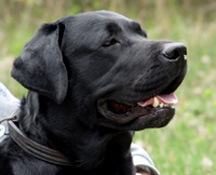



 By and by, however, Cherry started finally getting used to all
the well-wishers. He would stop and say hello. In fact, he also
made friends with other dogs who came around. Then the caregivers
tried something new. They brought over Handsome Dan for a visit.
Handsome Dan, another Vicktory dog, is one of Cherry's favorite
pals.
By and by, however, Cherry started finally getting used to all
the well-wishers. He would stop and say hello. In fact, he also
made friends with other dogs who came around. Then the caregivers
tried something new. They brought over Handsome Dan for a visit.
Handsome Dan, another Vicktory dog, is one of Cherry's favorite
pals. 



 cross-breeding
between a Labrador and a poodle goes back only to the 1980s.
In his election-night victory speech, Obama promised daughters
Sasha, 7, and Malia, 10, they could have a puppy in the White
House. He later said that Malia is allergic, that the family
would need a "hypoallergenic" dog and that they wanted
a pound dog.
cross-breeding
between a Labrador and a poodle goes back only to the 1980s.
In his election-night victory speech, Obama promised daughters
Sasha, 7, and Malia, 10, they could have a puppy in the White
House. He later said that Malia is allergic, that the family
would need a "hypoallergenic" dog and that they wanted
a pound dog.  LONDON (AFP) — Britain's Prince Edward has escaped prosecution
for allegedly beating a dog, after an animal welfare group said
Friday there was insufficient evidence to charge him.
LONDON (AFP) — Britain's Prince Edward has escaped prosecution
for allegedly beating a dog, after an animal welfare group said
Friday there was insufficient evidence to charge him.
 adopted
yet. But for Little Red and Handsome Dan, it's a big step in
that direction. These two snuggle monsters are now living in
the same play area. It's a far cry from dog fighting! These
two pups, rescued from the property of former NFL quarterback
Michael Vick, are now snuggling it up together.
adopted
yet. But for Little Red and Handsome Dan, it's a big step in
that direction. These two snuggle monsters are now living in
the same play area. It's a far cry from dog fighting! These
two pups, rescued from the property of former NFL quarterback
Michael Vick, are now snuggling it up together.  vampires
and witches ran past a middle-aged woman in plain clothes. She
gripped a leather harness — like the kind used for Seeing
Eye dogs — which was attached to a small, fuzzy black-and-white
horse barely tall enough to reach the woman’s hip.
vampires
and witches ran past a middle-aged woman in plain clothes. She
gripped a leather harness — like the kind used for Seeing
Eye dogs — which was attached to a small, fuzzy black-and-white
horse barely tall enough to reach the woman’s hip.  parrot, Sadie, to help control his psychotic tendencies....
“I have bipolar disorder with psychotic tendencies,”
he told me.... “Homicidal feelings too.”
parrot, Sadie, to help control his psychotic tendencies....
“I have bipolar disorder with psychotic tendencies,”
he told me.... “Homicidal feelings too.” 

 come
from "beasts who would kill us if they could."
come
from "beasts who would kill us if they could." 



